Secrets to a successful case-study interview
January 9, 2023


Prepping for (and maybe fretting) the case-study interview?
While this kind of interview may appear intimidating, consider this: The interviewer really wants you to do well.
So, shake off the nerves, relax and have fun.
Tips for standing out in the case-study interview:
- Take your time; don't rush it. Talk through the problem. If you can't make sense of it, take a moment and allow yourself some time to process what you've been missing. If you get stuck, get creative. Don't let yourself get bogged down; rely on your ingenuity.
- Ask questions. You can always ask your interviewer to define an acronym or to repeat or confirm details. If the interviewer asks, “How do we achieve success?”, don’t be afraid to ask, “What does ‘success’ mean to you? Is it turning a profit? Raising the company’s profile?” When you work on a client project, you need to ask questions to figure out what the problems might be, and the same applies here. The interviewer is your biggest asset in the room. They have the information you need to “solve the case” successfully. Use them wisely!
- Be flexible. The focus of a case-study interview may vary. So, be prepared to participate in whatever discussion the interviewer has in mind. They may spend the first half of the interview asking about your previous experience, or they may dive right into the case study at the start. The bottom line: Be flexible, and be ready to discuss the work you do and how you do it.
- Use visual aids. Don’t be afraid to use pen and paper, sketch out your thoughts, and talk through the problem at hand if it helps you get your ideas across. What matters most is demonstrating that you can solve problems.
- Focus on impact. Inventory the information you have, and then dive in where you can have the most impact. Don’t forget to discuss your thought process and explain your assumptions.
- Tell a story. Your experience has helped you progress in your career and education; use that experience. For example, in a business case study, you could bring your experience as a traveler to a case about a hypothetical airline. Your individuality is important. Your unique insights will serve you well when you’re interviewing.
- Pay attention to cues. If the interviewer says something, it probably means something. Don’t dismiss seemingly extraneous details. For example, the interviewer might say, “The case is about a retailer who wants to increase the value of a company it purchased, and the owner loved the brand when growing up.” The purpose of that detail is to indicate that turning around and selling the asset is not an option for making it profitable, because the owner is attached to it.
Preparing for the job you want can take time, but it’s a worthwhile investment—especially when you receive an offer.
Your ideas, ingenuity and determination make a difference.
Find your fit with Accenture.
Stay connected
Explore open roles that match your interests and skills.
Keep up to date
Get the latest stories delivered to your inbox. Select "Life at Accenture" on the registration form.
Get job alerts
Receive notifications when we have open roles and get other relevant career news.
Anaam Zamorano
RECRUITING ASSOCIATE MANAGER, HOUSTON, TEXAS
- Case Interview: A comprehensive guide
- Pyramid Principle
- Hypothesis driven structure
- Fit Interview
- Consulting math
- The key to landing your consulting job
- What is a case interview?
- Types of case interview
- How to solve cases with the Problem-Driven Structure?
- What to remember in case interviews
- Case examples or building blocks?
- How do I prepare for case interviews
- Interview day tips
- How we can help
1. The key to landing your consulting job.
Case interviews - where you are asked to solve a business case study under scrutiny - are the core of the selection process right across McKinsey, Bain and BCG (the “MBB” firms). This interview format is also used pretty much universally across other high-end consultancies; including LEK, Kearney, Oliver Wyman and the consulting wings of the “Big Four”.
If you want to land a job at any of these firms, you will have to ace multiple case interviews.
It is increasingly likely that you will also have to solve online cases given by chatbots. You might need to pass these either before making it to interview or be asked to sit them alongside first round interviews.
Importantly, case studies aren’t something you can just wing . Firms explicitly expect you to have thoroughly prepared and many of your competitors on interview day will have been prepping for months.
Don’t worry though - MCC is here to help!
This article will take you through a full overview of everything you’ll need to know to do well, linking to more detailed articles and resources at each stage to let you really drill down into the details.
As well as traditional case interviews, we’ll also attend to the new formats in which cases are being delivered and otherwise make sure you’re up to speed with recent trends in this overall part of consulting recruitment.
Before we can figure out how to prepare for a case interview, though, we will first have to properly understand in detail what exactly you are up against. What format does a standard consulting case interview take? What is expected of you? How will you be assessed?
Let's dive right in and find out!
Professional help
Before going further, if this sounds like a lot to get your head around on your own, don't worry - help is available!
Our Case Academy course gives you everything you need to know to crack cases like a pro:
Case Academy Course
To put what you learn into practice (and secure some savings in the process) you can add mock interview coaching sessions with expereinced MBB consultants:
Coaching options
And, if you just want an experienced consultant to take charge of the whole selection process for you, you can check out our comprehensive mentoring programmes:
Explore mentoring
Now, back to the article!
2. What is a case interview?
Before we can hope to tackle a case interview, we have to understand what one is.
In short, a case interview simulates real consulting work by having you solve a business case study in conversation with your interviewer.
This case study will be a business problem where you have to advise a client - that is, an imaginary business or similar organisation in need of guidance.
You must help this client solve a problem and/or make a decision. This requires you to analyse the information you are given about that client organisation and figure out a final recommendation for what they should do next.
Business problems in general obviously vary in difficulty. Some are quite straightforward and can be addressed with fairly standard solutions. However, consulting firms exist precisely to solve the tough issues that businesses have failed to deal with internally - and so consultants will typically work on complex, idiosyncratic problems requiring novel solutions.
Some examples of case study questions might be:
- How much would you pay for a banking licence in Ghana?
- Estimate the potential value of the electric vehicle market in Germany
- How much gas storage capacity should a UK domestic energy supplier build?
Consulting firms need the brightest minds they can find to put to work on these important, difficult projects. You can expect the case studies you have to solve in interview, then, to echo the unique, complicated problems consultancies deal with every day. As we’ll explain here, this means that you need to be ready to think outside the box to figure out genuinely novel solutions.
2.1. Where are case interviews in the consulting selection process?
Not everyone who applies to a consulting firm will have a case interview - far from it!
In fact, case interviews are pretty expensive and inconvenient for firms to host, requiring them to take consultants off active projects and even fly them back to the office from location for in-person interviews (although this happens less frequently now). Ideally, firms want to cut costs and save time by narrowing down the candidate pool as much as possible before any live interviews.
As such, there are some hoops to jump through before you make it to interview rounds.
Firms will typically eliminate as much as 80% of the applicant pool before interviews start . For most firms, 50%+ of applicants might be cut based on resumes, before a similar cut is made on those remaining based on aptitude tests. McKinsey currently gives their Solve assessment to most applicants, but will use their resulting test scores alongside resumes to cut 70%+ of the candidate pool before interviews.
You'll need to be on top of your game to get as far as a case interview with a top firm. Getting through the resume screen and any aptitude tests is an achievement in itself! Also we need to note that the general timeline of an application can differ depending on a series of factors, including which position you apply, your background, and the office you are applying to. For example, an undergraduate applying for a Business Analyst position (the entry level job at McKinsey) will most likely be part of a recruitment cycle and as such have pretty fixed dates when they need to sit the pre-screening test, and have the first and second round interviews (see more on those below). Conversely, an experienced hire will most likely have a much greater choice of test and interview dates as well as more time at their disposal to prepare.
For readers not yet embroiled in the selection process themselves, let’s put case interviews in context and take a quick look at each stage in turn. Importantly, note that you might also be asked to solve case studies outside interviews as well…
2.1.1. Application screen
It’s sometimes easy to forget that such a large cut is made at the application stage. At larger firms, this will mean your resume and cover letter is looked at by some combination of AI tools, recruitment staff and junior consulting staff (often someone from your own university).
Only the best applications will be passed to later stages, so make sure to check out our free resume and cover letter guides, and potentially get help with editing , to give yourself the best chance possible.
2.1.2. Aptitude tests and online cases
This part of the selection process has been changing quickly in recent years and is increasingly beginning to blur into the traditionally separate case interview rounds.
In the past, GMAT or PST style tests were the norm. Firms then used increasingly sophisticated and often gamified aptitude tests, like the Pymetrics test currently used by several firms, including BCG and Bain, and the original version of McKinsey’s Solve assessment (then branded as the Problem Solving Game).
Now, though, there is a move towards delivering relatively sophisticated case studies online. For example, McKinsey has replaced half the old Solve assessment with an online case. BCG’s Casey chatbot case now directly replaces a live first round case interview, and in the new era of AI chatbots, we expect these online cases to quickly become more realistic and increasingly start to relieve firms of some of the costs of live case interviews.
Our consultants collectively reckon that, over time, 50% of case interviews are likely to be replaced with these kinds of cases . We give some specific advice for online cases in section six. However, the important thing to note is that these are still just simulations of traditional case interviews - you still need to learn how to solve cases in precisely the same way, and your prep will largely remain the same.
2.1.3. Rounds of Interviews
Now, let’s not go overboard with talk of AI. Even in the long term, the client facing nature of consulting means that firms will have live case interviews for as long as they are hiring anyone. And in the immediate term, case interviews are still absolutely the core of consulting selection.
Before landing an offer at McKinsey, Bain, BCG or any similar firm, you won’t just have one case interview, but will have to complete four to six case interviews, usually divided into two rounds, with each interview lasting approximately 50-60 minutes .
Being invited to first round usually means two or three case interviews. As noted above, you might also be asked to complete an online case or similar alongside your first round interviews.
If you ace first round, you will be invited to second round to face the same again, but more gruelling. Only then - after up to six case interviews in total, can you hope to receive an offer.
2.2. Differences between first and second round interviews
Despite case interviews in the first and second round following the same format, second/final round interviews will be significantly more intense . The seniority of the interviewer, time pressure (with up to three interviews back-to-back), and the sheer value of the job at stake will likely make a second round consulting case interview one of the most challenging moments of your professional life.
There are three key differences between the two rounds:
- Time Pressure : Final round case interviews test your ability to perform under pressure, with as many as three interviews in a row and often only very small breaks between them.
- Focus : Since second round interviewers tend to be more senior (usually partners with 12+ years experience) and will be more interested in your personality and ability to handle challenges independently. Some partners will drill down into your experiences and achievements to the extreme. They want to understand how you react to challenges and your ability to identify and learn from past mistakes.
- Psychological Pressure: While case interviews in the first round are usually more focused on you simply cracking the case, second round interviewers often employ a "bad cop" strategy to test the way you react to challenges and uncertainty.
2.3. What skills do case interviews assess?
Reliably impressing your interviewers means knowing what they are looking for. This means understanding the skills you are being assessed against in some detail.
Overall, it’s important always to remember that, with case studies, there are no strict right or wrong answers. What really matters is how you think problems through, how confident you are with your conclusions and how quick you are with the back of the envelope arithmetic.
The objective of this kind of interview isn’t to get to one particular solution, but to assess your skillset. This is even true of modern online cases, where sophisticated AI algorithms score how you work as well as the solutions you generate.
If you visit McKinsey , Bain and BCG web pages on case interviews, you will find that the three firms look for very similar traits, and the same will be true of other top consultancies.
Broadly speaking, your interviewer will be evaluating you across five key areas:
2.1.1.One: Probing mind
Showing intellectual curiosity by asking relevant and insightful questions that demonstrate critical thinking and a proactive nature. For instance, if we are told that revenues for a leading supermarket chain have been declining over the last ten years, a successful candidate would ask:
“ We know revenues have declined. This could be due to price or volume. Do we know how they changed over the same period? ”
This is as opposed to a laundry list of questions like:
- Did customers change their preferences?
- Which segment has shown the decline in volume?
- Is there a price war in the industry?
2.1.2. Structure
Structure in this context means structuring a problem. This, in turn, means creating a framework - that is, a series of clear, sequential steps in order to get to a solution.
As with the case interview in general, the focus with case study structures isn’t on reaching a solution, but on how you get there.
This is the trickiest part of the case interview and the single most common reason candidates fail.
We discuss how to properly structure a case in more detail in section three. In terms of what your interviewer is looking for at high level, though, key pieces of your structure should be:
- Proper understanding of the objective of the case - Ask yourself: "What is the single crucial piece of advice that the client absolutely needs?"
- Identification of the drivers - Ask yourself: "What are the key forces that play a role in defining the outcome?"
Our Problem Driven Structure method, discussed in section three, bakes this approach in at a fundamental level. This is as opposed to the framework-based approach you will find in older case-solving
Focus on going through memorised sequences of steps too-often means failing to develop a full understanding of the case and the real key drivers.
At this link, we run through a case to illustrate the difference between a standard framework-based approach and our Problem Driven Structure method.
2.1.3. Problem Solving
You’ll be tested on your ability to identify problems and drivers, isolate causes and effects, demonstrate creativity and prioritise issues. In particular, the interviewer will look for the following skills:
- Prioritisation - Can you distinguish relevant and irrelevant facts?
- Connecting the dots - Can you connect new facts and evidence to the big picture?
- Establishing conclusions - Can you establish correct conclusions without rushing to inferences not supported by evidence?
2.1.4. Numerical Agility
In case interviews, you are expected to be quick and confident with both precise and approximated numbers. This translates to:
- Performing simple calculations quickly - Essential to solve cases quickly and impress clients with quick estimates and preliminary conclusions.
- Analysing data - Extract data from graphs and charts, elaborate and draw insightful conclusions.
- Solving business problems - Translate a real world case to a mathematical problem and solve it.
Our article on consulting math is a great resource here, though the extensive math content in our MCC Academy is the best and most comprehensive material available.
2.1.5. Communication
Real consulting work isn’t just about the raw analysis to come up with a recommendation - this then needs to be sold to the client as the right course of action.
Similarly, in a case interview, you must be able to turn your answer into a compelling recommendation. This is just as essential to impressing your interviewer as your structure and analysis.
Consultants already comment on how difficult it is to find candidates with the right communication skills. Add to this the current direction of travel, where AI will be able to automate more and more of the routine analytic side of consulting, and communication becomes a bigger and bigger part of what consultants are being paid for.
So, how do you make sure that your recommendations are relevant, smart, and engaging? The answer is to master what is known as CEO-level communication .
This art of speaking like a CEO can be quite challenging, as it often involves presenting information in effectively the opposite way to how you might normally.
To get it right, there are three key areas to focus on in your communications:
- Top down : A CEO wants to hear the key message first. They will only ask for more details if they think that will actually be useful. Always consider what is absolutely critical for the CEO to know, and start with that. You can read more in our article on the Pyramid Principle .
- Concise : This is not the time for "boiling the ocean" or listing an endless number possible solutions. CEOs, and thus consultants, want a structured, quick and concise recommendation for their business problem, that they can implement immediately.
- Fact-based : Consultants share CEOs' hatred of opinions based on gut feel rather than facts. They want recommendations based on facts to make sure they are actually in control. Always go on to back up your conclusions with the relevant facts.
Being concise and to the point is key in many areas, networking being one for them. For more detail on all this, check out our full article on delivering recommendations .
Prep the right way
3. types of case interview.
While most case interviews share a similar structure, firms will have some differences in the particular ways they like to do things in terms of both the case study and the fit component.
As we’ll see, these differences aren’t hugely impactful in terms of how you prepare. That said, it's always good to know as much as possible about what you will be going up against.
3.1. Different case objectives
A guiding thread throughout this article and our approach in general will be to treat each case as a self-contained problem and not try to pigeonhole it into a certain category. Having said that, there are of course similarities between cases and we can identify certain parameters and objectives.
Broadly speaking, cases can be divided into issue-based cases and strategic decision cases. In the former you will be asked to solve a certain issue, such as declining profits, or low productivity whereas in the latter you will be ask whether your client should or should not do something, such as enter a specific market or acquire another company. The chart below is a good breakdown of these different objectives:
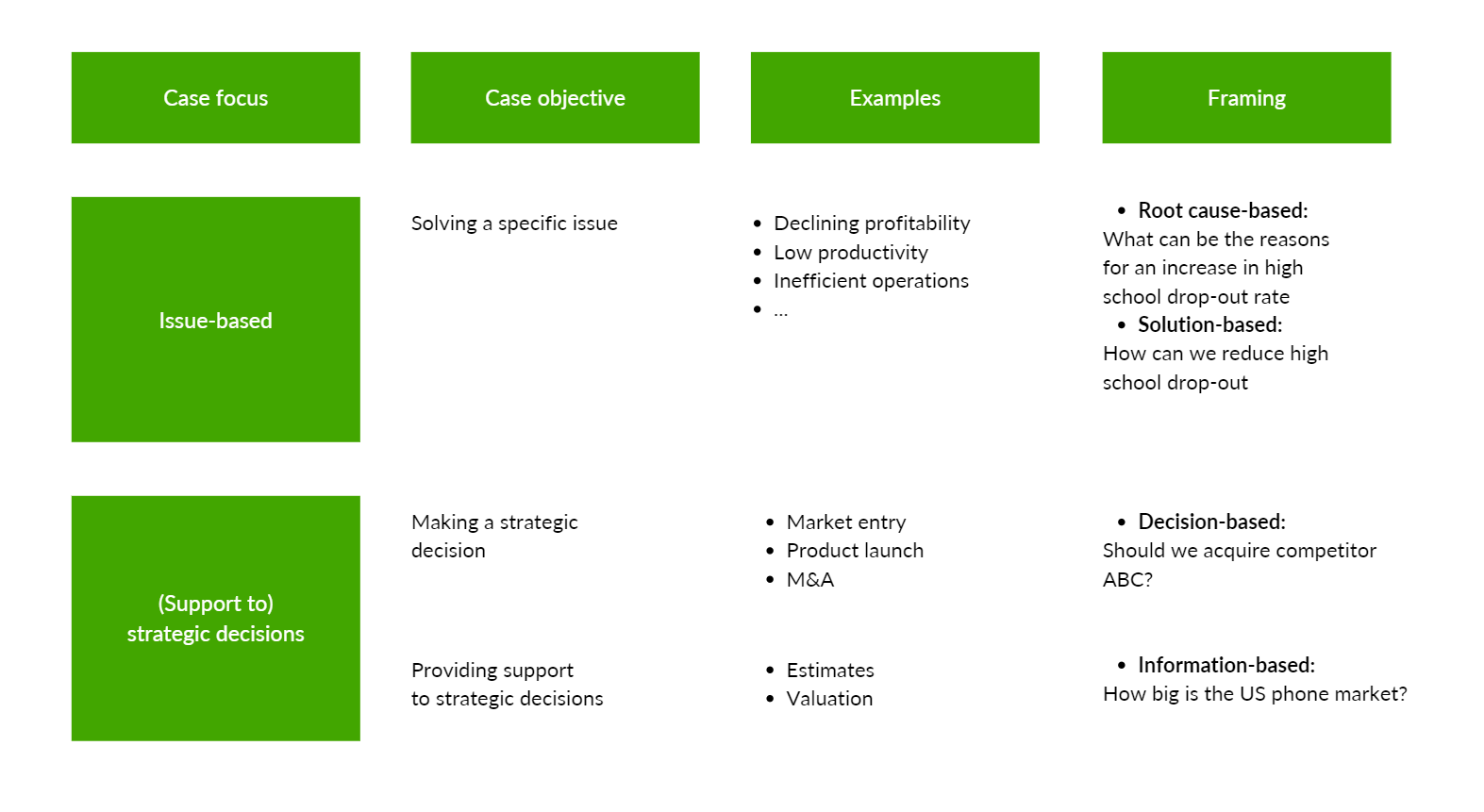
3.2. How do interviewers craft cases
While interviewers will very likely be given a case bank to choose from by their company, a good number of them will also choose to adapt the cases they would currently be working on to a case interview setting. The difference is that the latter cases will be harder to pigeonhole and apply standard frameworks to, so a tailored approach will be paramount.
If you’ve applied for a specific practice or type of consulting - such as operational consulting, for example - it’s very likely that you will receive a case geared towards that particular area alongside a ‘generalist’ consulting case (however, if that’s the case, you will generally be notified). The other main distinction when it comes to case interviews is between interviewer-led and candidate-led.
3.3. Candidate-led cases
Most consulting case interview questions test your ability to crack a broad problem, with a case prompt often going something like:
" How much would you pay to secure the rights to run a restaurant in the British Museum? "
You, as a candidate, are then expected to identify your path to solve the case (that is, provide a structure), leveraging your interviewer to collect the data and test your assumptions.
This is known as a “candidate-led” case interview and is used by Bain, BCG and other firms. From a structuring perspective, it’s easier to lose direction in a candidate-led case as there are no sign-posts along the way. As such, you need to come up with an approach that is both broad enough to cover all of the potential drivers in a case but also tailored enough to the problem you are asked to solve. It’s also up to you to figure out when you need to delve deeper into a certain branch of the case, brainstorm or ask for data. The following case from Bain is an excellent example on how to navigate a candidate-led case.
3.4. Interviewer-led cases
This type of case - employed most famously by McKinsey - is slightly different, with the interviewer controlling the pace and direction of the conversation much more than with other case interviews.
At McKinsey, your interviewer will ask you a set of pre-determined questions, regardless of your initial structure. For each question, you will have to understand the problem, come up with a mini structure, ask for additional data (if necessary) and come to the conclusion that answers the question. This more structured format of case also shows up in online cases by other firms - notably including BCG’s Casey chatbot (with the amusing result that practising McKinsey-style cases can be a great addition when prepping for BCG).
Essentially, these interviewer-led case studies are large cases made up of lots of mini-cases. You still use basically the same method as you would for standard (or candidate-led) cases - the main difference is simply that, instead of using that method to solve one big case, you are solving several mini-cases sequentially. These cases are easier to follow as the interviewer will guide you in the right direction. However, this doesn’t mean you should pay less attention to structure and deliver a generic framework! Also, usually (but not always!) the first question will ask you to map your approach and is the equivalent of the structuring question in candidate-led cases. Sometimes, if you’re missing key elements, the interviewer might prompt you in the right direction - so make sure to take those prompts seriously as they are there to help you get back on track (ask for 30 seconds to think on the prompt and structure your approach). Other times - and this is a less fortunate scenario - the interviewer might say nothing and simply move on to the next question. This is why you should put just as much thought (if not more) into the framework you build for interviewer-led cases , as you may be penalized if you produce something too generic or that doesn’t encompass all the issues of the case.
3.5. Case and fit
The standard case interview can be thought of as splitting into two standalone sub-interviews. Thus “case interviews” can be divided into the case study itself and a “fit interview” section, where culture fit questions are asked.
This can lead to a bit of confusion, as the actual case interview component might take up as little as half of your scheduled “case interview”. You need to make sure you are ready for both aspects.
To illustrate, here is the typical case interview timeline:

- First 15-30 minutes: Fit Interview - with questions assessing your motivation to be a consultant in that specific firm and your traits around leadership and teamwork. Learn more about the fit interview in our in-depth article here .
- Next 30-40 minutes: Case Interview - solving a case study
- Last 5 minutes: Fit Interview again - this time focussing on your questions for your interviewer.
Both the Case and Fit interviews play crucial roles in the finial hiring decision. There is no “average” taken between case and fit interviews: if your performance is not up to scratch in either of the two, you will not be able to move on to the next interview round or get an offer.
NB: No case without fit
Note that, even if you have only been told you are having a case interview or otherwise are just doing a case study, always be prepared to answer fit questions. At most firms, it is standard practice to include some fit questions in all case interviews, even if there are also separate explicit fit interviews, and interviewers will almost invariably include some of these questions around your case. This is perfectly natural - imagine how odd and artificial it would be to show up to an interview, simply do a case and leave again, without talking about anything else with the interviewer before or after.
3.5.1 Differences between firms
For the most part, a case interview is a case interview. However, firms will have some differences in the particular ways they like to do things in terms of both the case study and the fit component.
3.5.2. The McKinsey PEI
McKinsey brands its fit aspect of interviews as the Personal Experience Interview or PEI. Despite the different name, this is really much the same interview you will be going up against in Bain, BCG and any similar firms.
McKinsey does have a reputation for pushing candidates a little harder with fit or PEI questions , focusing on one story per interview and drilling down further into the specific details each time. We discuss this tendency more in our fit interview article . However, no top end firm is going to go easy on you and you should absolutely be ready for the same level of grilling at Bain, BCG and others. Thus any difference isn’t hugely salient in terms of prep.
3.6. What is different in 2023?
For the foreseeable future, you are going to have to go through multiple live case interviews to secure any decent consulting job. These might increasingly happen via Zoom rather than in person, but they should remain largely the same otherwise.
However, things are changing and the rise of AI in recent months seems pretty much guaranteed to accelerate existing trends.
Even before the explosive development of AI chatbots like ChatGPT we have seen in recent months, automation was already starting to change the recruitment process.
As we mentioned, case interviews are expensive and inconvenient for firms to run . Ideally, then, firms will try to reduce the number of interviews required for recruitment as far as possible. For many years, tests of various kinds served to cut down the applicant pool and thus the number of interviews. However, these tests had a limited capacity to assess candidates against the full consulting skillset in the way that case interviews do so well.
More recently, though, the development of online testing has allowed for more and more advanced assessments. Top consulting firms have been leveraging screening tests that better and better capture the same skillset as case interviews. Eventually this is converging on automated case studies. We see this very clearly with the addition of the Redrock case to McKinsey’s Solve assessment.
As these digital cases become closer to the real thing, the line between test and case interview blurs. Online cases don’t just reduce the number of candidates to case interview, but start directly replacing them.
Case in point here is BCG’s Casey chatbot . Previously, BCG had deployed less advanced online cases and similar tests to weed out some candidates before live case interviews began. Now, though, Casey actually replaces one first round case interview.
Casey, at time of writing, is still a relatively “basic” chatbot, basically running through a pre-set script. The Whatsapp-like interface does a lot of work to make it feel like one is chatting to a “real person” - the chatbot itself, though, cannot provide feedback or nudges to candidates as would a human interviewer.
We fully expect that, as soon as BCG and other firms can train a truer AI, these online cases will become more widespread and start replacing more live interviews.
We discuss the likely impacts of advanced AI on consulting recruitment and the industry more broadly in our blog.
Here, though, the real message is that you should expect to run into digital cases as well as traditional case interviews.
Luckily, despite any changes in specific case interview format, you will still need to master the same fundamental skills and prepare in much the same way.
We’ll cover a few ways to help prepare for chatbot cases in section four. Ultimately, though, firms are looking for the same problem solving ability and mindset as a real interviewer. Especially as chatbots get better at mimicking a real interviewer, candidates who are well prepared for case cracking in general should have no problem with AI administered cases.
3.6.1. Automated fit interviews
Analogous to online cases, in recent years there has been a trend towards automated, “one way” fit interviews, with these typically being administered for consultancies by specialist contractors like HireVue or SparkHire.
These are kind of like Zoom interviews, but if the interviewer didn’t show up. Instead you will be given fit questions to answer and must record your answer in your computer webcam. Your response will then go on to be assessed by an algorithm, scoring both what you say and how you say it.
Again, with advances in AI, it is easy to imagine these automated case interviews going from fully scripted interactions, where all candidates are asked the same list of questions, to a more interactive experience. Thus, we might soon arrive at a point where you are being grilled on the details of your stories - McKinsey PEI style - but by a bot rather than a human.
We include some tips on this kind of “one way” fit interview in section six here.
4. How to solve cases with the Problem-Driven Structure?
If you look around online for material on how to solve case studies, a lot of what you find will set out framework-based approaches. However, as we have mentioned, these frameworks tend to break down with more complex, unique cases - with these being exactly the kind of tough case studies you can expect to be given in your case interviews.
To address this problem, the MyConsultingCoach team has synthesized a new approach to case cracking that replicates how top management consultants approach actual engagements.
MyConsultingCoach’s Problem Driven Structure approach is a universal problem solving method that can be applied to any business problem , irrespective of its nature.
As opposed to just selecting a generic framework for each case interview, the Problem Driven Structure approach works by generating a bespoke structure for each individual question and is a simplified version of the roadmap McKinsey consultants use when working on engagements.
The canonical seven steps from McKinsey on real projects are simplified to four for case interview questions, as the analysis required for a six-month engagement is somewhat less than that needed for a 45-minute case study. However, the underlying flow is the same (see the method in action in the video below)
Let's zoom in to see how our method actually works in more detail:
4.1. Identify the problem
Identifying the problem means properly understanding the prompt/question you are given, so you get to the actual point of the case.
This might sound simple, but cases are often very tricky, and many candidates irretrievably mess things up within the first few minutes of starting. Often, they won’t notice this has happened until they are getting to the end of their analysis. Then, they suddenly realise that they have misunderstood the case prompt - and have effectively been answering the wrong question all along!
With no time to go back and start again, there is nothing to do. Even if there were time, making such a silly mistake early on will make a terrible impression on their interviewer, who might well have written them off already. The interview is scuppered and all the candidate’s preparation has been for nothing.
This error is so galling as it is so readily avoidable.
Our method prevents this problem by placing huge emphasis on a full understanding of the case prompt. This lays the foundations for success as, once we have identified the fundamental, underlying problem our client is facing, we focus our whole analysis around finding solutions to this specific issue.
Now, some case interview prompts are easy to digest. For example, “Our client, a supermarket, has seen a decline in profits. How can we bring them up?”. However, many of the prompts given in interviews for top firms are much more difficult and might refer to unfamiliar business areas or industries. For example, “How much would you pay for a banking license in Ghana?” or “What would be your key areas of concern be when setting up an NGO?”
Don’t worry if you have no idea how you might go about tackling some of these prompts!
In our article on identifying the problem and in our full lesson on the subject in our MCC Academy course, we teach a systematic, four step approach to identifying the problem , as well as running through common errors to ensure you start off on the right foot every time!
This is summarised here:
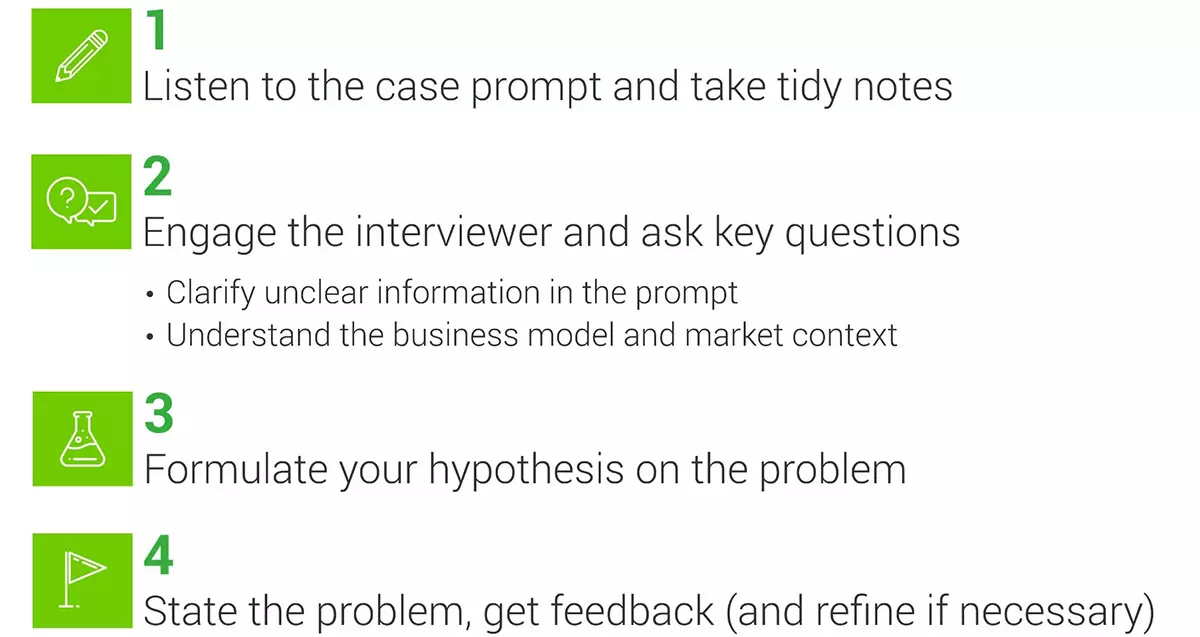
Following this method lets you excel where your competitors mess up and get off to a great start in impressing your interviewer!
4.2. Build your problem driven structure
After you have properly understood the problem, the next step is to successfully crack a case is to draw up a bespoke structure that captures all the unique features of the case.
This is what will guide your analysis through the rest of the case study and is precisely the same method used by real consultants working on real engagements.
Of course, it might be easier here to simply roll out one an old-fashioned framework, and a lot of candidates will do so. This is likely to be faster at this stage and requires a lot less thought than our problem-driven structure approach.
However, whilst our problem driven structure approach requires more work from you, our method has the advantage of actually working in the kind of complex case studies where generic frameworks fail - that is exactly the kind of cases you can expect at an MBB interview .
Since we effectively start from first principles every time, we can tackle any case with the same overarching method. Simple or complex, every case is the same to you and you don’t have to gamble a job on whether a framework will actually work
4.2.1 Issue trees
Issue trees break down the overall problem into a set of smaller problems that you can then solve individually. Representing this on a diagram also makes it easy for both you and your interviewer to keep track of your analysis.
To see how this is done, let’s look at the issue tree below breaking down the revenues of an airline:

These revenues can be segmented as the number of customers multiplied by the average ticket price. The number of customers can be further broken down into a number of flights multiplied by the number of seats, times average occupancy rate. The node corresponding to the average ticket price can then be segmented further.
4.2.2 Hypothesis trees
Hypothesis trees are similar, the only difference being that rather than just trying to break up the issue into smaller issues you are assuming that the problem can be solved and you are formulating solutions.
In the example above, you would assume revenues can be increased by either increasing the average ticket price or the number of customers . You can then hypothesize that you can increase the average occupancy rate in three ways: align the schedule of short and long haul flights, run a promotion to boost occupancy in off-peak times, or offer early bird discounts.
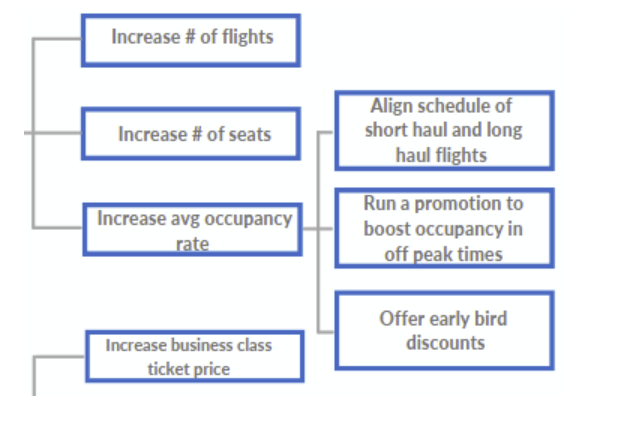
4.2.3 Other structures:structured lists
Structured lists are simply subcategories of a problem into which you can fit similar elements. This McKinsey case answer starts off by identifying several buckets such as retailer response, competitor response, current capabilities and brand image and then proceeds to consider what could fit into these categories.
Buckets can be a good way to start the structure of a complex case but when using them it can be very difficult to be MECE and consistent, so you should always aim to then re-organize them into either an issue or a hypothesis tree.
It is worth noting that the same problem can be structured in multiple valid ways by choosing different means to segment the key issues. Ultimately all these lists are methods to set out a logical hierachy among elements.
4.2.4 Structures in practice
That said, not all valid structures are equally useful in solving the underlying problem. A good structure fulfils several requirements - including MECE-ness , level consistency, materiality, simplicity, and actionability. It’s important to put in the time to master segmentation, so you can choose a scheme isn’t only valid, but actually useful in addressing the problem.
After taking the effort to identify the problem properly, an advantage of our method is that it will help ensure you stay focused on that same fundamental problem throughout. This might not sound like much, but many candidates end up getting lost in their own analysis, veering off on huge tangents and returning with an answer to a question they weren’t asked.
Another frequent issue - particularly with certain frameworks - is that candidates finish their analysis and, even if they have successfully stuck to the initial question, they have not actually reached a definite solution. Instead, they might simply have generated a laundry list of pros and cons, with no clear single recommendation for action.
Clients employ consultants for actionable answers, and this is what is expected in the case interview. The problem driven structure excels in ensuring that everything you do is clearly related back to the key question in a way that will generate a definitive answer. Thus, the problem driven structure builds in the hypothesis driven approach so characteristic of real consulting practice.
You can learn how to set out your own problem driven structures in our article here and in our full lesson in the MCC Academy course.
4.2. Lead the analysis
A problem driven structure might ensure we reach a proper solution eventually, but how do we actually get there?
We call this step " leading the analysis ", and it is the process whereby you systematically navigate through your structure, identifying the key factors driving the issue you are addressing.
Generally, this will mean continuing to grow your tree diagram, further segmenting what you identify as the most salient end nodes and thus drilling down into the most crucial factors causing the client’s central problem.
Once you have gotten right down into the detail of what is actually causing the company’s issues, solutions can then be generated quite straightforwardly.
To see this process in action, we can return to our airline revenue example:

Let’s say we discover the average ticket price to be a key issue in the airline’s problems. Looking closer at the drivers of average ticket price, we find that the problem lies with economy class ticket prices. We can then further segment that price into the base fare and additional items such as food.
Having broken down the issue to such a fine-grained level and considering the 80/20 rule(see below), solutions occur quite naturally. In this case, we can suggest incentivising the crew to increase onboard sales, improving assortment in the plane, or offering discounts for online purchases.
Our article on leading the analysis is a great primer on the subject, with our video lesson in the MCC Academy providing the most comprehensive guide available.
4.4. Provide recommendations
So you have a solution - but you aren’t finished yet!
Now, you need to deliver your solution as a final recommendation.
This should be done as if you are briefing a busy CEO and thus should be a one minute, top-down, concise, structured, clear, and fact-based account of your findings.
The brevity of the final recommendation belies its importance. In real life consulting, the recommendation is what the client has potentially paid millions for - from their point of view, it is the only thing that matters.
In a case interview, your performance in this final summing up of your case is going to significantly colour your interviewer’s parting impression of you - and thus your chances of getting hired!
So, how do we do it right?
Barbara Minto's Pyramid Principle elegantly sums up almost everything required for a perfect recommendation. The answer comes first , as this is what is most important. This is then supported by a few key arguments , which are in turn buttressed by supporting facts .
Across the whole recommendation, the goal isn’t to just summarise what you have done. Instead, you are aiming to synthesize your findings to extract the key "so what?" insight that is useful to the client going forward.
All this might seem like common sense, but it is actually the opposite of how we relay results in academia and other fields. There, we typically move from data, through arguments and eventually to conclusions. As such, making good recommendations is a skill that takes practice to master.
We can see the Pyramid Principle illustrated in the diagram below:

To supplement the basic Pyramid Principle scheme, we suggest candidates add a few brief remarks on potential risks and suggested next steps . This helps demonstrate the ability for critical self-reflection and lets your interviewer see you going the extra mile.
The combination of logical rigour and communication skills that is so definitive of consulting is particularly on display in the final recommendation.
Despite it only lasting 60 seconds, you will need to leverage a full set of key consulting skills to deliver a really excellent recommendation and leave your interviewer with a good final impression of your case solving abilities.
Our specific article on final recommendations and the specific video lesson on the same topic within our MCC Academy are great, comprehensive resources. Beyond those, our lesson on consulting thinking and our articles on MECE and the Pyramid Principle are also very useful.
4.5. What if I get stuck?
Naturally with case interviews being difficult problems there may be times where you’re unsure what to do or which direction to take. The most common scenario is that you will get stuck midway through the case and there are essentially two things that you should do:
- 1. Go back to your structure
- 2. Ask the interviewer for clarification
Your structure should always be your best friend - after all, this is why you put so much thought and effort into it: if it’s MECE it will point you in the right direction. This may seem abstract but let’s take the very simple example of a profitability case interview: if you’ve started your analysis by segmenting profit into revenue minus costs and you’ve seen that the cost side of the analysis is leading you nowhere, you can be certain that the declining profit is due to a decline in revenue.
Similarly, when you’re stuck on the quantitative section of the case interview, make sure that your framework for calculations is set up correctly (you can confirm this with the interviewer) and see what it is you’re trying to solve for: for example if you’re trying to find what price the client should sell their new t-shirt in order to break even on their investment, you should realize that what you’re trying to find is the break even point, so you can start by calculating either the costs or the revenues. You have all the data for the costs side and you know they’re trying to sell 10.000 pairs so you can simply set up the equation with x being the price.
As we’ve emphasised on several occasions, your case interview will be a dialogue. As such, if you don’t know what to do next or don’t understand something, make sure to ask the interviewer (and as a general rule always follow their prompts as they are trying to help, not trick you). This is especially true for the quantitative questions, where you should really understand what data you’re looking at before you jump into any calculations. Ideally you should ask your questions before you take time to formulate your approach but don’t be afraid to ask for further clarification if you really can’t make sense of what’s going on. It’s always good to walk your interviewer through your approach before you start doing the calculations and it’s no mistake to make sure that you both have the same understanding of the data. For example when confronted with the chart below, you might ask what GW (in this case gigawatt) means from the get-go and ask to confirm the different metrics (i.e. whether 1 GW = 1000 megawatts). You will never be penalised for asking a question like that.
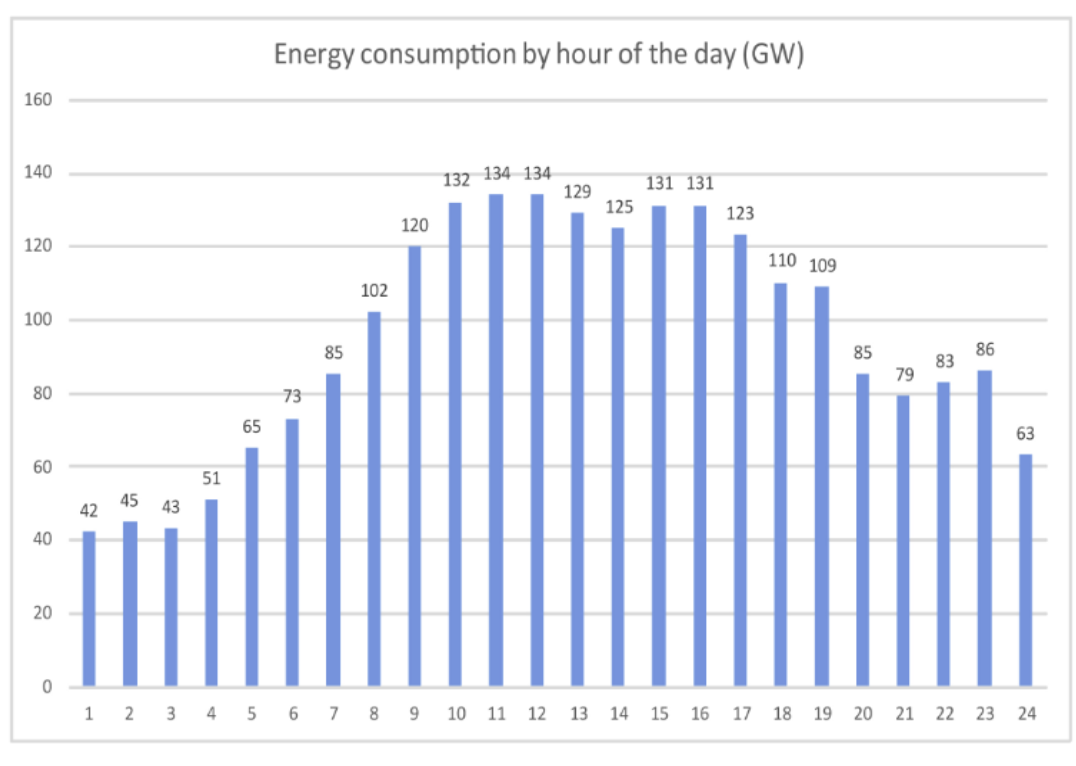
5. What to remember in case interviews
If you’re new to case cracking you might feel a bit hopeless when you see a difficult case question, not having any idea where to start.
In fact though, cracking case interviews is much like playing chess. The rules you need to know to get started are actually pretty simple. What will make you really proficient is time and practice.
In this section, we’ll run through a high level overview of everything you need to know, linking to more detailed resources at every step.
5.1. An overall clear structure
You will probably hear this more than you care for but it is the most important thing to keep in mind as you start solving cases, as not only it is a key evaluation criterion but the greatest tool you will have at your disposal. The ability to build a clear structure in all aspects of the case inteview will be the difference between breezing through a complicated case and struggling at its every step. Let’s look a bit closer at the key areas where you should be structured!
5.1.1 Structured notes
Every case interview starts with a prompt, usually verbal, and as such you will have to take some notes. And here is where your foray into structure begins, as the notes you take should be clear, concise and structured in a way that will allow you to repeat the case back to the interviewer without writing down any unnecessary information.
This may sound very basic but you should absolutely not be dismissive about it: taking clear and organized notes will allow what we found helps is to have separate sections for:
- The case brief
- Follow-up questions and answers
- Numerical data
- Case structure (the most crucial part when solving the case)
- Any scrap work during the case (usually calculations)
When solving the case - or, as we call it here, in the Lead the analysis step, it is highly recommended to keep on feeding and integrating your structure, so that you never get lost. Maintaining a clear high level view is one of the most critical aspects in case interviews as it is a key skill in consulting: by constantly keeping track of where you are following your structure, you’ll never lose your focus on the end goal.
In the case of an interviewer-led case, you can also have separate sheets for each question (e.g. Question 1. What factors can we look at that drive profitability?). If you develop a system like this you’ll know exactly where to look for each point of data rather than rummage around in untidy notes. There are a couple more sections that you may have, depending on preference - we’ll get to these in the next sections.
5.1.2 Structured communication
There will be three main types of communication in cases:
- 1. Asking and answering questions
- 2. Walking the interviewer through your structure (either the case or calculation framework - we’ll get to that in a bit!)
- 3. Delivering your recommendation
Asking and answering questions will be the most common of these and the key thing to do before you speak is ask for some time to collect your thoughts and get organised. What you want to avoid is a ‘laundry list’ of questions or anything that sounds too much like a stream of consciousness.
Different systems work for different candidates but a sure-fire way of being organised is numbering your questions and answers. So rather than saying something like ‘I would like to ask about the business model, operational capacity and customer personas’ it’s much better to break it down and say something along the lines of ‘I’ve got three key questions. Firstly I would like to inquire into the business model of our client. Secondly I would like to ask about their operational capacity. Thirdly I would like to know more about the different customer personas they are serving’.
A similar principle should be applied when walking the interviewer through your structure, and this is especially true of online case interviews (more and more frequent now) when the interviewer can’t see your notes. Even if you have your branches or buckets clearly defined, you should still use a numbering system to make it obvious to the interviewer. So, for example, when asked to identify whether a company should make an acquisition, you might say ‘I would like to examine the following key areas. Firstly the financial aspects of this issue, secondly the synergies and thirdly the client’s expertise’
The recommendation should be delivered top-down (see section 4.4 for specifics) and should employ the same numbering principle. To do so in a speedy manner, you should circle or mark the key facts that you encounter throughout the case so you can easily pull them out at the end.
5.1.3 Structured framework
It’s very important that you have a systematic approach - or framework - for every case. Let’s get one thing straight: there is a difference between having a problem-solving framework for your case and trying to force a case into a predetermined framework. Doing the former is an absolute must , whilst doing the latter will most likely have you unceremoniously dismissed.
We have seen there are several ways of building a framework, from identifying several categories of issues (or ‘buckets’) to building an issue or hypothesis tree (which is the most efficient type of framework). For the purpose of organization, we recommend having a separate sheet for the framework of the case, or, if it’s too much to manage, you can have it on the same sheet as the initial case prompt. That way you’ll have all the details as well as your proposed solution in one place.
5.1.4 Structured calculations
Whether it’s interviewer or candidate-led, at some point in the case you will get a bunch of numerical data and you will have to perform some calculations (for the specifics of the math you’ll need on consulting interviews, have a look at our Consulting Math Guide ). Here’s where we urge you to take your time and not dive straight into calculating! And here’s why: while your numerical agility is sure to impress interviewers, what they’re actually looking for is your logic and the calculations you need to perform in order to solve the problem . So it’s ok if you make a small mistake, as long as you’re solving for the right thing.
As such, make it easy for them - and yourself. Before you start, write down in steps the calculations you need to perform. Here’s an example: let’s say you need to find out by how much profits will change if variable costs are reduced by 10%. Your approach should look something like:
- 1. Calculate current profits: Profits = Revenues - (Variable costs + Fixed costs)
- 2. Calculate the reduction in variable costs: Variable costs x 0.9
- 3. Calculate new profits: New profits = Revenues - (New variable costs + Fixed costs)
Of course, there may be more efficient ways to do that calculation, but what’s important - much like in the framework section - is to show your interviewer that you have a plan, in the form of a structured approach. You can write your plan on the sheet containing the data, then perform the calculations on a scrap sheet and fill in the results afterward.
5.2. Common business knowledge and formulas
Although some consulting firms claim they don’t evaluate candidates based on their business knowledge, familiarity with basic business concepts and formulae is very useful in terms of understanding the case studies you are given in the first instance and drawing inspiration for structuring and brainstorming.
If you are coming from a business undergrad, an MBA or are an experienced hire, you might well have this covered already. For those coming from a different background, it may be useful to cover some.
Luckily, you don’t need a degree-level understanding of business to crack case interviews , and a lot of the information you will pick up by osmosis as you read through articles like this and go through cases.
However, some things you will just need to sit down and learn. We cover everything you need to know in some detail in our Case Academy Course course. However, some examples here of things you need to learn are:
- Basic accounting (particularly how to understand all the elements of a balance sheet)
- Basic economics
- Basic marketing
- Basic strategy
Below we include a few elementary concepts and formulae so you can hit the ground running in solving cases. We should note that you should not memorise these and indeed a good portion of them can be worked out logically, but you should have at least some idea of what to expect as this will make you faster and will free up much of your mental computing power. In what follows we’ll tackle concepts that you will encounter in the private business sector as well as some situations that come up in cases that feature clients from the NGO or governmental sector.
5.2.1 Business sector concepts
These concepts are the bread and butter of almost any business case so you need to make sure you have them down. Naturally, there will be specificities and differences between cases but for the most part here is a breakdown of each of them.
5.2.1.1. Revenue
The revenue is the money that the company brings in and is usually equal to the number of products they sell multiplied to the price per item and can be expressed with the following equation:
Revenue = Volume x Price
Companies may have various sources of revenue or indeed multiple types of products, all priced differently which is something you will need to account for in your case interview. Let’s consider some situations. A clothing company such as Nike will derive most of their revenue from the number of products they sell times the average price per item. Conversely, for a retail bank revenue is measured as the volume of loans multiplied by the interest rate at which the loans are given out. As we’ll see below, we might consider primary revenues and ancillary revenues: in the case of a football club, we might calculate primary revenues by multiplying the number of tickets sold by the average ticket price, and ancillary revenues those coming from sales of merchandise (similarly, let’s say average t-shirt price times the number of t-shirts sold), tv rights and sponsorships.
These are but a few examples and another reminder that you should always aim to ask questions and understand the precise revenue structure of the companies you encounter in cases.
5.2.1.2. Costs
The costs are the expenses that a company incurs during its operations. Generally, they can be broken down into fixed and variable costs :
Costs = Fixed Costs + Variable Costs
As their name implies, fixed costs do not change based on the number of units produced or sold. For example, if you produce shoes and are renting the space for your factory, you will have to pay the rent regardless of whether you produce one pair or 100. On the other hand, variable costs depend on the level of activity, so in our shoe factory example they would be equivalent to the materials used to produce each pair of shoes and would increase the more we produce.
These concepts are of course guidelines used in order to simplify the analysis in cases, and you should be aware that in reality often the situation can be more complicated. However, this should be enough for case interviews. Costs can also be quasi-fixed, in that they increase marginally with volume. Take the example of a restaurant which has a regular staff, incurring a fixed cost but during very busy hours or periods they also employ some part-time workers. This cost is not exactly variable (as it doesn’t increase with the quantity of food produced) but also not entirely fixed, as the number of extra hands will depend on how busy the restaurant is. Fixed costs can also be non-linear in nature. Let’s consider the rent in the same restaurant: we would normally pay a fixed amount every month, but if the restaurant becomes very popular we might need to rent out some extra space so the cost will increase. Again, this is not always relevant for case interviews.
5.2.1.3. Profit and profit margin
The profit is the amount of money a company is left with after it has paid all of its expenses and can be expressed as follows:
Profit = Revenue - Costs
It’s very likely that you will encounter a profitability issue in one of your case interviews, namely you will be asked to increase a company’s profit. There are two main ways of doing this: increasing revenues and reducing costs , so these will be the two main areas you will have to investigate. This may seem simple but what you will really need to understand in a case are the key drivers of a business (and this should be done through clarifying questions to the interviewer - just as a real consultant would question their client).
For example, if your client is an airline you can assume that the main source of revenue is sales of tickets, but you should inquire how many types of ticket the specific airline sells. You may naturally consider economy and business class tickets, but you may find out that there is a more premium option - such as first class - and several in-between options. Similarly to our football club example, there may be ancillary revenues from selling of food and beverage as well as advertising certain products or services on flights.
You may also come across the profit margin in case interviews. This is simply the percentage of profit compared to the revenue and can be expressed as follows:
Profit margin = Profit/Revenue x 100
5.2.1.4. Break-even point
An ancillary concept to profit, the break-even point is the moment where revenues equal costs making the profit zero and can be expressed as the following equation:
Revenues = Costs (Fixed costs + Variable costs)
This formula will be useful when you are asked questions such as ‘What is the minimum price I should sell product X?’ or ‘What quantity do I need to sell in order to recoup my investment?’. Let’s say in a case interview an owner of a sandwich store asks us to figure out how many salami and cheese salami sandwiches she needs to sell in order to break even. She’s spending $4 on salami and $2 for cheese and lettuce per sandwich, and believes she can sell the sandwiches at around $7. The cost of utilities and personnel is around $5000 per month. We could lay this all out in the break-even equation:
7 x Q ( quantity ) = (4+2) x Q + 5000 ( variable + fixed costs )
In a different scenario, we may be asked to calculate the break-even price . Let’s consider our sandwich example and say our owner knows she has enough ingredients for about 5000 sandwiches per month but is not sure how much to sell them for. In that case, if we know our break-even equation, we can simply make the following changes:
P ( price ) x 5000 = (4+2) x 5000 + 5000
By solving the equation we get to the price of $7 per sandwich.
5.2.1.5. Market share and market size
We can also consider the market closely with profit, as in fact the company’s performance in the market is what drives profits. The market size is the total number of potential customers for a certain business or product, whereas the market share is the percentage of that market that your business controls (or could control, depending on the case).
There is a good chance you will have to estimate the market size in one of your case interviews and we get into more details on how to do that below. You may be asked to estimate this in either number of potential customers or total value . The latter simply refers to the number of customers multiplied by the average value of the product or service.
To calculate the market share you will have to divide the company’s share by the total market size and multiply by 100:
Note, though, that learning the very basics of business is the beginning rather than the end of your journey. Once you are able to “speak business” at a rudimentary level, you should try to “become fluent” and immerse yourself in reading/viewing/listening to as wide a variety of business material as possible, getting a feel for all kinds of companies and industries - and especially the kinds of problems that can come up in each context and how they are solved. The material put out by the consulting firms themselves is a great place to start, but you should also follow the business news and find out about different companies and sectors as much as possible between now and interviews. Remember, if you’re going to be a consultant, this should be fun rather than a chore!
5.3 Public sector and NGO concepts
As we mentioned, there will be some cases (see section 6.6 for a more detailed example) where the key performance indicators (or KPIs in short) will not be connected to profit. The most common ones will involve the government of a country or an NGO, but they can be way more diverse and require more thought and application of first principles. We have laid out a couple of the key concepts or KPIs that come up below
5.3.1 Quantifiability
In many such scenarios you will be asked to make an important strategic decision of some kind or to optimise a process. Of course these are not restricted to non-private sector cases but this is where they really come into their own as there can be great variation in the type of decision and the types of field.
While there may be no familiar business concepts to anchor yourself onto, a concept that is essential is quantifiability . This means, however qualitative the decision might seem, consultants rely on data so you should always aim to have aspects of a decision that can be quantified, even if the data doesn’t present itself in a straightforward manner.
Let’s take a practical example. Your younger sibling asks you to help them decide which university they should choose if they want to study engineering. One way to structure your approach would be to segment the problem into factors affecting your sibling’s experience at university and experience post-university. Within the ‘at uni’ category you might think about the following:
- Financials : How much are tuition costs and accommodation costs?
- Quality of teaching and research : How are possible universities ranked in the QS guide based on teaching and research?
- Quality of resources : How well stocked is their library, are the labs well equipped etc.?
- Subject ranking : How is engineering at different unis ranked?
- Life on campus and the city : What are the living costs in the city where the university is based? What are the extracurricular opportunities and would your sibling like to live in that specific city based on them?
Within the ‘out of uni’ category you might think about:
- Exit options : What are the fields in which your sibling could be employed and how long does it take the average student of that university to find a job?
- Alumni network : What percentage of alumni are employed by major companies?
- Signal : What percentage of applicants from the university get an interview in major engineering companies and related technical fields?
You will perhaps notice that all the buckets discussed pose quantifiable questions meant to provide us with data necessary to make a decision. It’s no point to ask ‘Which university has the nicest teaching staff?’ as that can be a very subjective metric.
5.3.1 Impact
Another key concept to consider when dealing with sectors other than the private one is how impactful a decision or a line of inquiry is on the overarching issue , or whether all our branches in our issue tree have a similar impact. This can often come in the form of impact on lives, such as in McKinsey’s conservation case discussed below, namely how many species can we save with our choice of habitat.
5.4 Common consulting concepts
Consultants use basic business concepts on an every day basis, as they help them articulate their frameworks to problems. However, they also use some consulting specific tools to quality check their analysis and perform in the most efficient way possible. These principles can be applied to all aspects of a consultant’s work, but for brevity we can say they mostly impact a consultant’s systematic approach and communication - two very important things that are also tested in case interviews. Therefore, it’s imperative that you not only get to know them, but learn how and when to use them as they are at the very core of good casing. They are MECE-ness, the Pareto Principle and the Pyramid principle and are explained briefly below - you should, however, go on to study them in-depth in their respective articles.
Perhaps the central pillar of all consulting work and an invaluable tool to solve cases, MECE stands for Mutually Exclusive and Collectively Exhaustive . It can refer to any and every aspect in a case but is most often used when talking about structure. We have a detailed article explaining the concept here , but the short version is that MECE-ness ensures that there is no overlap between elements of a structure (i.e. the Mutually Exclusive component) and that it covers all the drivers or areas of a problem (Collectively Exhaustive). It is a concept that can be applied to any segmentation when dividing a set into subsets that include it wholly but do not overlap.
Let’s take a simple example and then a case framework example. In simple terms, when we are asked to break down the set ‘cars’ into subsets, dividing cars into ‘red cars’ and ‘sports cars’ is neither mutually exclusive (as there are indeed red sports cars) nor exhaustive of the whole set (i.e. there are also yellow non-sports cars that are not covered by this segmentation). A MECE way to segment would be ‘cars produced before 2000’ and ‘cars produced after 2000’ as this segmentation allows for no overlap and covers all the cars in existence.
Dividing cars can be simple, but how can we ensure MECEness in a case-interview a.k.a. a business situation. While the same principles apply, a good tip to ensure that your structure is MECE is to think about all the stakeholders - i.e. those whom a specific venture involves.
Let’s consider that our client is a soda manufacturer who wants to move from a business-to-business strategy, i.e. selling to large chains of stores and supermarkets, to a business-to-consumer strategy where it sells directly to consumers. In doing so they would like to retrain part of their account managers as direct salespeople and need to know what factors to consider.
A stakeholder-driven approach would be to consider the workforce and customers and move further down the issue tree, thinking about individual issues that might affect them. In the case of the workforce, we might consider how the shift would affect their workload and whether it takes their skillset into account. As for the customers, we might wonder whether existing customers would be satisfied with this move: will the remaining B2B account managers be able to provide for the needs of all their clients and will the fact that the company is selling directly to consumers now not cannibalise their businesses? We see how by taking a stakeholder-centred approach we can ensure that every single perspective and potential issue arising from it is fully covered.
5.4.2 The Pareto Principle
Also known as the 80/20 rule, this principle is important when gauging the impact of a decision or a factor in your analysis. It simply states that in business (but not only) 80% of outcomes come from 20% of causes. What this means is you can make a few significant changes that will impact most of your business organisation, sales model, cost structure etc.
Let’s have a look at 3 quick examples to illustrate this:
- 80% of all accidents are caused by 20% of drivers
- 20% of a company’s products account for 80% of the sales
- 80% of all results in a company are driven by 20% of its employees
The 80/20 rule will be a very good guide line in real engagements as well as case interviews, as it will essentially point to the easiest and most straightforward way of doing things. Let’s say one of the questions in a case is asking you to come up with an approach to understand the appeal of a new beard trimmer. Obviously you can’t interview the whole male population so you might think about setting up a webpage and asking people to comment their thoughts. But what you would get would be a laundry list of difficult to sift through data.
Using an 80/20 approach you would segment the population based on critical factors (age groups, grooming habits etc.) and then approach a significant sample size of each (e.g. 20), analysing the data and reaching a conclusion.
5.4.3 The Pyramid Principle
This principle refers to organising your communication in a top-down , efficient manner. While this is generally applicable, the pyramid principle will most often be employed when delivering the final recommendation to your client. This means - as is implicit in the name - that you would organise your recommendation (and communication in general) as a pyramid, stating the conclusion or most important element at the top then go down the pyramid listing 3 supporting arguments and then further (ideally also 3) supporting arguments for those supporting arguments.
Let’s look at this in practice in a case interview context: your client is a German air-conditioning unit manufacturer who was looking to expand into the French market. However, after your analysis you’ve determined that the market share they were looking to capture would not be feasible. A final recommendation using the Pyramid Principle would sound something like this: ‘I recommend that we do not enter the German market for the following three reasons. Firstly, the market is too small for our ambitions of $50 million. Secondly the market is heavily concentrated, being controlled by three major players and our 5 year goal would amount to controlling 25% of the market, a share larger than that of any of the players. Thirdly, the alternative of going into the corporate market would not be feasible, as it has high barriers to entry.Then, if needed, we could delve deeper into each of our categories
6. Case examples or building blocks?
As we mentioned before, in your case interview preparation you will undoubtedly find preparation resources that claim that there are several standard types of cases and that there is a general framework that can be applied to each type of case. While there are indeed cases that are straightforward at least in appearance and seemingly invite the application of such frameworks, the reality is never that simple and cases often involve multiple or more complicated components that cannot be fitted into a simple framework.
At MCC we don’t want you to get into the habit of trying to identify which case type you’re dealing with and pull out a framework, but we do recognize that there are recurring elements in frameworks that are useful - such as the profitability of a venture (with its revenues and costs), the valuation of a business, estimating and segmenting a market and pricing a product.
We call these building blocks because they can be used to build case frameworks but are not a framework in and of themselves, and they can be shuffled around and rearranged in any way necessary to be tailored to our case. Hence, our approach is not to make you think in terms of case types but work from first principles and use these building blocks to build your own framework. Let’s take two case prompts to illustrate our point.
The first is from the Bain website, where the candidate is asked whether they think it’s a good idea for their friend to open a coffee shop in Cambridge UK (see the case here ). The answer framework provided here is a very straightforward profitability analysis framework, examining the potential revenues and potential costs of the venture:
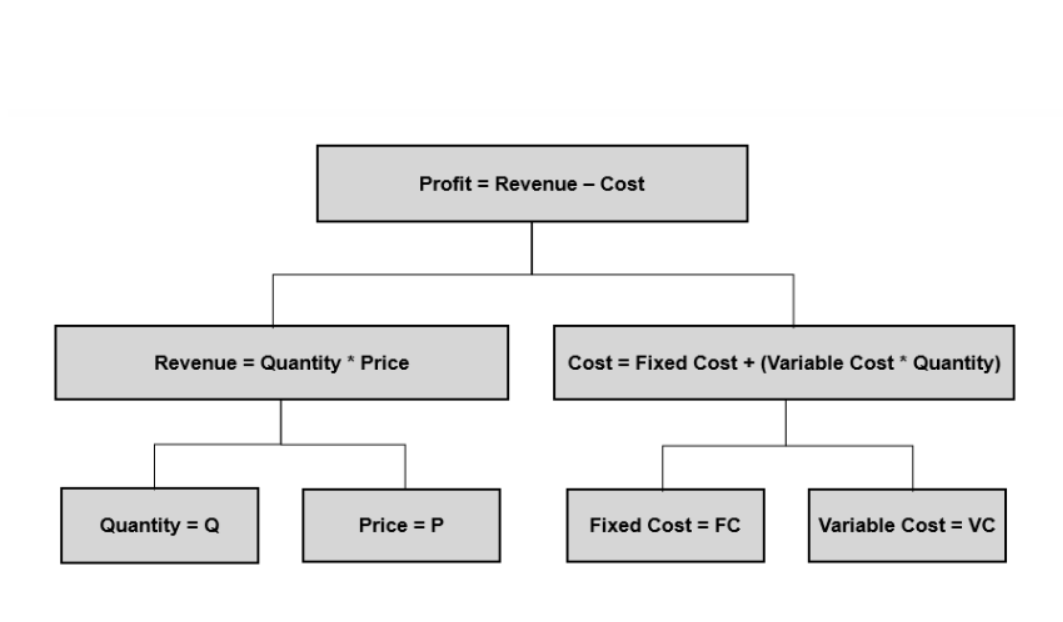
While this is a good point to start for your case interview (especially taken together with the clarifying questions), we will notice that this approach will need more tailoring to the case - for example the quantity of coffee will be determined by the market for coffee drinkers in Cambridge, which we have to determine based on preference. We are in England so a lot of people will be drinking tea but we are in a university town so perhaps more people than average are drinking coffee as it provides a better boost when studying. All these are some much needed case-tailored hypotheses that we can make based on the initial approach.
Just by looking at this case we might be tempted to say that we can just take a profitability case and apply it without any issues. However, this generic framework is just a starting point and in reality we would need to tailor it much further in the way we had started to do in order to get to a satisfactory answer. For example, the framework for this specific case interview doesn’t cover aspects such as the customer’s expertise: does the friend have any knowledge of the coffee business, such as where to source coffee and how to prepare it? Also, we could argue there may be some legal factors to consider here, such as any approvals that they might need from the city council to run a coffee shop on site, or some specific trade licences that are not really covered in the basic profitability framework.
Let’s take a different case , however, from the McKinsey website. In this scenario, the candidate is being asked to identify some factors in order to choose where to focus the client’s conservation efforts. Immediately we can realise that this case doesn’t lend itself to any pre-packaged framework and we will need to come up with something from scratch - and take a look at McKinsey’s answer of the areas to focus on:
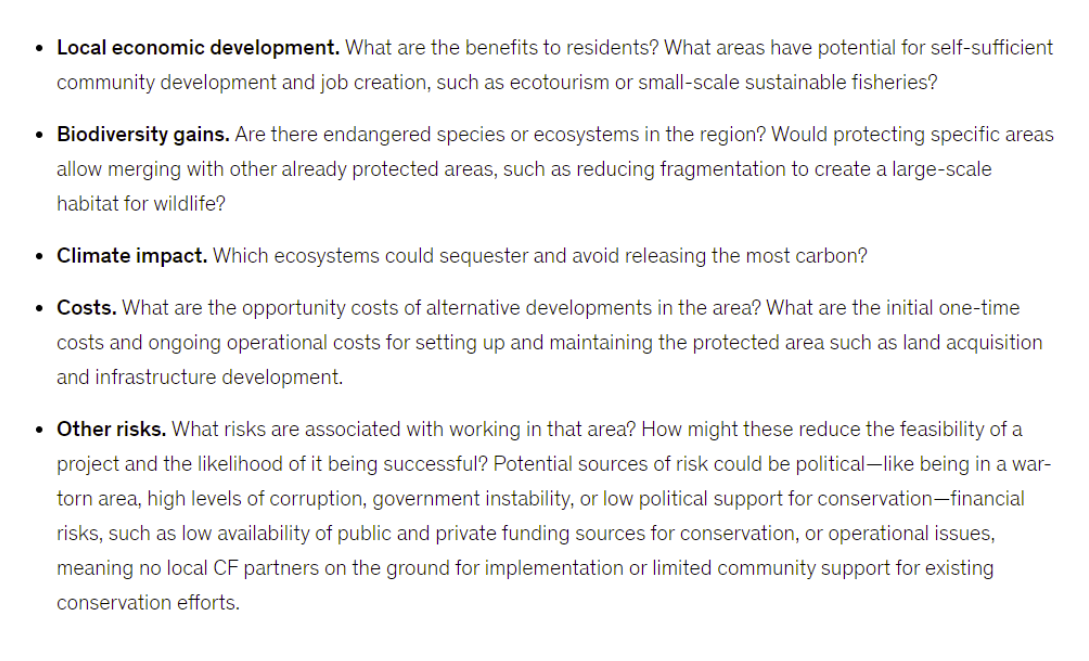
We notice immediately that this framework is 100% tailored to the case - of course there are elements which we encounter in other cases, such as costs and risks but again these are applied in an organic way. It’s pretty clear that while no standard framework would work in this case, the aforementioned concepts - costs and risks - and the way to approach them (a.k.a building blocks ) are fundamentally similar throughout cases (with the obvious specificities of each case).
In what follows, we’ll give a brief description of each building block starting from the Bain example discussed previously, in order to give you a general idea of what they are and their adaptability, but you should make sure to follow the link to the in-depth articles to learn all their ins and outs.
6.1 Estimates and segmentation
This building block will come into play mostly when you’re thinking about the market for a certain product (but make sure to read the full article for more details). Let’s take our Bain Cambridge coffee example. As we mentioned under the quantity bucket we need to understand what the market size for coffee in Cambridge would be - so we can make an estimation based on segmentation .
The key to a good estimation is the ability to logically break down the problem into more manageable pieces. This will generally mean segmenting a wider population to find a particular target group. We can start off with the population of Cambridge - which we estimate at 100.000. In reality the population is closer to 150.000 but that doesn’t matter - the estimation has to be reasonable and not accurate , so unless the interviewer gives you a reason to reconsider you can follow your instinct. We can divide that into people who do and don’t drink coffee. Given our arguments before, we can conclude that 80% of those, so 80.000 drink coffee. Then we can further segment into those who drink regularly - let’s say every day - and those who drink occasionally - let’s say once a week. Based on the assumptions before about the student population needing coffee to function, and with Cambridge having a high student population, we can assume that 80% of those drinking coffee are regular drinkers, so that would be 64.000 regular drinkers and 16.000 occasional drinkers. We can then decide whom we want to target what our strategy needs to be:
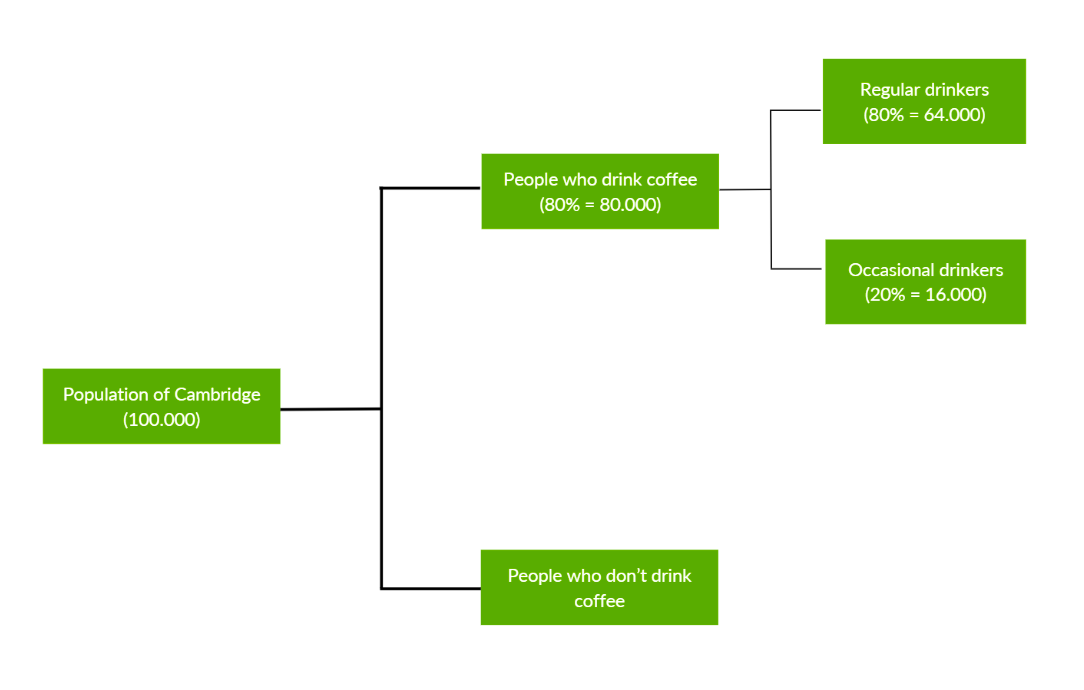
This type of estimation and segmentation can be applied to any case specifics - hence why it is a building block.
6.2 Profitability
We had several looks at this building block so far (see an in-depth look here ) as it will show up in most case interivew scenarios, since profit is a key element in any company’s strategy. As we have seen, the starting point to this analysis is to consider both the costs and revenues of a company, and try to determine whether revenues need to be improved or whether costs need to be lowered. In the coffee example, the revenues are dictated by the average price per coffe x the number of coffees sold , whereas costs can be split into fixed and variable .
Some examples of fixed costs would be the rent for the stores and the cost of the personnel and utilities, while the most obvious variable costs would be the coffee beans used and the takeaway containers (when needed). We may further split revenues in this case into Main revenues - i.e. the sales of coffee - and Ancillary revenues , which can be divided into Sales of food products (sales of pastries, sandwiches etc., each with the same price x quantity schema) and Revenues from events - i.e renting out the coffee shop to events and catering for the events themselves. Bear in mind that revenues will be heavily influenced by the penetration rate , i.e. the share of the market which we can capture.
6.3 Pricing
Helping a company determine how much they should charge for their goods or services is another theme that comes up frequently in cases. While it may seem less complicated than the other building blocks, we assure you it’s not - you will have to understand and consider several factors, such as the costs a company is incurring, their general strategic positioning, availability, market trends as well as the customers’ willingness to pay (or WTP in short) - so make sure to check out our in-depth guide here .
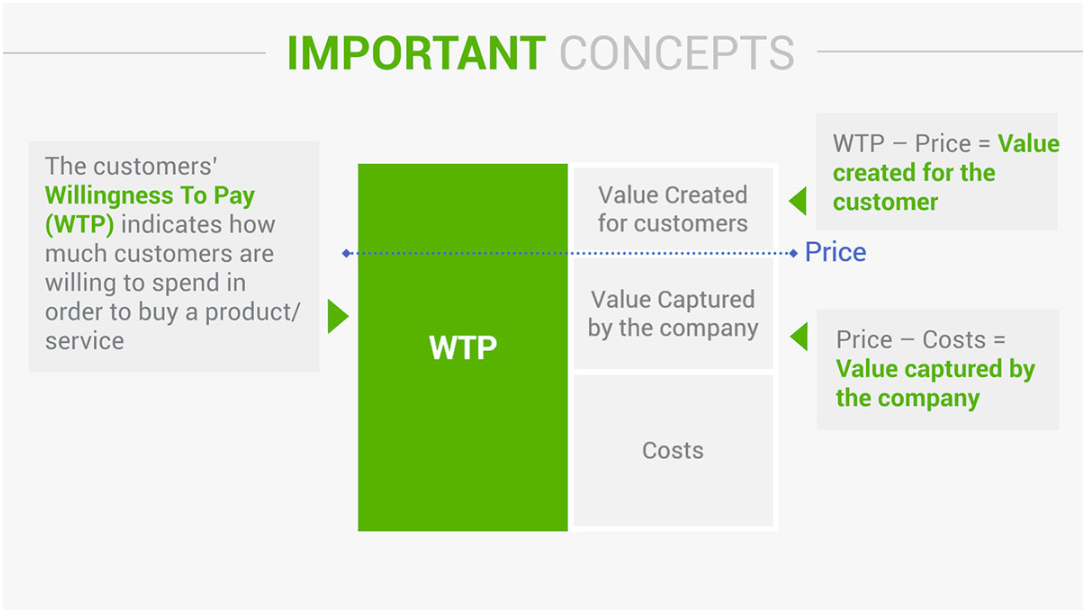
In our example, we may determine that the cost per cup (coffee beans, staff, rent) is £1. We want to be student friendly so we should consider how much students would want to pay for a coffee as well as how much are competitors are charging. Based on those factors, it would be reasonable to charge on average £2 per cup of coffee. It’s true that our competitors are charging £3 but they are targeting mostly the adult market, whose willingness to pay is higher, so their pricing model takes that into account as well as the lower volume of customers in that demographic.
6.4. Valuation
A variant of the pricing building block, a valuation problem generally asks the candidate to determine how much a client should pay for a specific company (the target of an acquisition) as well as what other factors to consider. The two most important factors (but not the only ones - for a comprehensive review see our Valuation article ) to consider are the net present value (in consulting interviews usually in perpetuity) and the synergies .
In short, the net present value of a company is how much profit it currently brings in, divided by how much that cash flow will depreciate in the future and can be represented with the equation below:
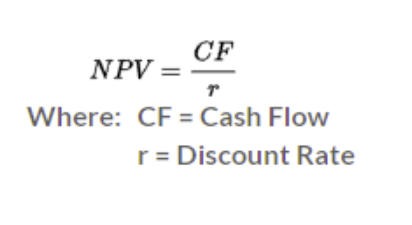
The synergies refer to what could be achieved should the companies operate as one, and can be divided into cost and revenue synergies .
Let’s expand our coffee example a bit to understand these. Imagine that our friend manages to open a chain of coffee shops in Cambridge and in the future considers acquiring a chain of take-out restaurants. The most straightforward example of revenue synergies would be cross-selling, in this case selling coffee in the restaurants as well as in the dedicated stores, and thus getting an immediate boost in market share by using the existing customers of the restaurant chain. A cost synergy would be merging the delivery services of the two businesses to deliver both food and coffee, thus avoiding redundancies and reducing costs associated with twice the number of drivers and vehicles.
6.5. Competitive interaction
This component of cases deals with situations where the market in which a company is operating changes and the company must decide what to do. These changes often have to do with a new player entering the market (again for more details make sure to dive into the Competitive Interaction article ).
Let’s assume that our Cambridge coffee shop has now become a chain and has flagged up to other competitors that Cambridge is a blooming market for coffee. As such, Starbucks has decided to open a few stores in Cambridge themselves, to test this market. The question which might be posed to a candidate is what should our coffee chain do. One way (and a MECE one) to approach the problem is to decide between doing something and doing nothing . We might consider merging with another coffee chain and pooling our resources or playing to our strengths and repositioning ourselves as ‘your student-friendly, shop around the corner’. Just as easily we may just wait the situation out and see whether indeed Starbucks is cutting into our market share - after all, the advantages of our product and services might speak for themselves and Starbucks might end up tanking. Both of these are viable options if argued right and depending on the further specifics of the case.
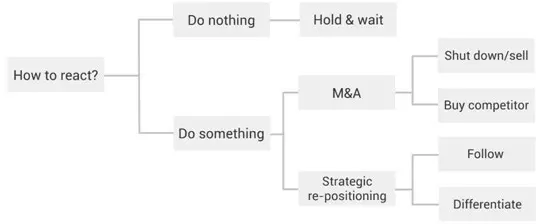
6.6. Special cases
Most cases deal with private sectors, where the overarching objective entails profit in some form. However, as hinted before, there are cases which deal with other sectors where there are other KPIs in place . The former will usually contain one or several of these building blocks whereas the latter will very likely have neither. This latter category is arguably the one that will stretch your analytical and organisational skills to the limit, since there will be very little familiarity that you can fall back on (McKinsey famously employs such cases in their interview process).
So how do we tackle the structure for such cases? The short answer would be starting from first principles and using the problem driven structure outlined above, but let’s look at a quick example in the form of a McKinsey case :
The first question addressed to the candidate is the following:

This is in fact asking us to build a structure for the case. So what should we have in mind here? Most importantly, we should start with a structure that is MECE and we should remember to do that by considering all the stakeholders . They are on the one hand the government and affiliated institutions and on the other the population. We might then consider which issues might arise for each shareholder and what the benefits for them would be, as well as the risks. This approach is illustrated in the answer McKinsey provides as well:
More than anything, this type of case shows us how important it is to practise and build different types of structures, and think about MECE ways of segmenting the problem.
7. How Do I prepare for case interviews
In consulting fashion, the overall preparation can be structured into theoretical preparation and practical preparation , with each category then being subdivided into individual prep and prep with a partner .
As a general rule, the level and intensity of the preparation will differ based on your background - naturally if you have a business background (and have been part of a consulting club or something similar) your preparation will be less intensive than if you’re starting from scratch. The way we suggest you go about it is to start with theoretical preparation , which means learning about case interviews, business and basic consulting concepts (you can do this using free resources - such as the ones we provide - or if you want a more through preparation you can consider joining our Case Academy as well).
You can then move on to the practical preparation which should start with doing solo cases and focusing on areas of improvement, and then move on to preparation with a partner , which should be another candidate or - ideally - an ex-consultant.
Let’s go into more details with respect to each type of preparation.
7.1. Solo practice
The two most important areas of focus in sole preparation are:
- Mental math
As we mentioned briefly, the best use of your time is to focus on solving cases. You can start with cases listed on MBB sites since they are clearly stated and have worked solutions as well (e.g. Bain is a good place to start) and then move to more complex cases (our Case Library also offers a range of cases of different complexities). To build your confidence, start out on easier case questions, work through with the solutions, and don't worry about time. As you get better, you can move on to more difficult cases and try to get through them more quickly. You should practice around eight case studies on your own to build your confidence.
Another important area of practice is your mental mathematics as this skill will considerably increase your confidence and is neglected by many applicants - much to their immediate regret in the case interview. Find our mental math tool here or in our course, and practice at least ten minutes per day, from day one until the day before the interview.
7.2. Preparation with a partner
There are aspects of a case interview - such as asking clarifying questions - which you cannot do alone and this is why, after you feel comfortable, you should move on to practice with another person. There are two options here:
- Practicing with a peer
- Practicing with an ex-consultant
In theory they can be complementary - especially if you’re peer is also preparing for consulting interviews - and each have advantages and disadvantages. A peer is likely to practice with you for free for longer, however you may end up reinforcing some bad habits or unable to get actionable feedback. A consultant will be able to provide you the latter but having their help for the same number of hours as a peer will come at a higher cost. Let’s look at each option in more detail.
7.2.1. Peer preparation
Once you have worked through eight cases solo, you should be ready to simulate the case interview more closely and start working with another person.
Here, many candidates turn to peer practice - that is, doing mock case interviews with friends, classmates or others also applying to consulting. If you’re in university, and especially in business school, there will very likely be a consulting club for you to join and do lots of case practice with. If you don’t have anyone to practice, though, or if you just want to get a bit more volume in with others, our free meeting board lets you find fellow applicants from around the world with whom to practice. We recommend practicing around 10 to 15 ‘live’ cases to really get to a point where you feel comfortable.
7.2.2. Preparation with a consultant
You can do a lot practising by yourself and with peers. However, nothing will bring up your skills so quickly and profoundly as working with a real consultant.
Perhaps think about it like boxing. You can practice drills and work on punch bags all you want, but at some point you need to get into the ring and do some actual sparring if you ever want to be ready to fight.
Practicing with an ex consultant is essentialy a simulation of a case interview. Of course, it isn’t possible to secure the time of experienced top-tier consultants for free. However, when considering whether you should invest to boost your chances of success, it is worth considering the difference in your salary over even just a few years between getting into a top-tier firm versus a second-tier one. In the light of thousands in increased annual earnings (easily accumulating into millions over multiple years), it becomes clear that getting expert interview help really is one of the best investments you can make in your own future.
Should you decide to make this step, MyConsultingCoach can help, offering bespoke mentoring programmes , where you are paired with a 5+ year experienced, ex-MBB mentor of your choosing, who will then oversee your whole case interview preparation from start to finish - giving you your best possible chance of landing a job!
7.3. Practice for online interviews
Standard preparation for interview case studies will carry directly over to online cases.
However, if you want to do some more specific prep, you can work through cases solo to a timer and using a calculator and/or Excel (online cases generally allow calculators and second computers to help you, whilst these are banned in live case interviews).
Older PST-style questions also make great prep, but a particularly good simulation is the self-assessment tests included in our Case Academy course . These multiple choice business questions conducted with a strict time limit are great preparation for the current crop of online cases.
7.4. Fit interviews
As we’ve noted, even something billed as a case interview is very likely to contain a fit interview as a subset.
We have an article on fit interviews and also include a full set of lessons on how to answer fit questions properly as a subset of our comprehensive Case Academy course .
Here though, the important thing to convey is that you take preparing for fit questions every bit as seriously as you do case prep.
Since they sound the same as you might encounter when interviewing for other industries, the temptation is to regard these as “just normal interview questions”.
However, consulting firms take your answers to these questions a good deal more seriously than elsewhere.
This isn’t just for fluffy “corporate culture” reasons. The long hours and close teamwork, as well as the client-facing nature of management consulting, mean that your personality and ability to get on with others is going to be a big part of making you a tolerable and effective co-worker.
If you know you’ll have to spend 14+ hour working days with someone you hire and that your annual bonus depends on them not alienating clients, you better believe you’ll pay attention to their character in interview.
There are also hard-nosed financial reasons for the likes of McKinsey, Bain and BCG to drill down so hard on your answers.
In particular, top consultancies have huge issues with staff retention. The average management consultant only stays with these firms for around two years before they have moved on to a new industry.
In some cases, consultants bail out because they can’t keep up with the arduous consulting lifestyle of long hours and endless travel. In many instances, though, departing consultants are lured away by exit opportunities - such as the well trodden paths towards internal strategy roles, private equity or becoming a start-up founder.
Indeed, many individuals will intentionally use a two year stint in consulting as something like an MBA they are getting paid for - giving them accelerated exposure to the business world and letting them pivot into something new.
Consulting firms want to get a decent return on investment for training new recruits. Thus, they want hires who not only intend to stick with consulting longer-term, but also have a temperament that makes this feasible and an overall career trajectory where it just makes sense for them to stay put.
This should hammer home the point that, if you want to get an offer, you need to be fully prepared to answer fit questions - and to do so excellently - any time you have a case interview.
8. Interview day - what to expect, with tips
Of course, all this theory is well and good, but a lot of readers might be concerned about what exactly to expect in real life . It’s perfectly reasonable to want to get as clear a picture as possible here - we all want to know what we are going up against when we face a new challenge!
Indeed, it is important to think about your interview in more holistic terms, rather than just focusing on small aspects of analysis. Getting everything exactly correct is less important than the overall approach you take to reasoning and how you communicate - and candidates often lose sight of this fact.
In this section, then, we’ll run through the case interview experience from start to finish, directing you to resources with more details where appropriate. As a supplement to this, the following video from Bain is excellent. It portrays an abridged version of a case interview, but is very useful as a guide to what to expect - not just from Bain, but from McKinsey, BCG and any other high-level consulting firm.
8.1. Getting started
Though you might be shown through to the office by a staff member, usually your interviewer will come and collect you from a waiting area. Either way, when you first encounter them, you should greet your interviewer with a warm smile and a handshake (unless they do not offer their hand). Be confident without verging into arrogance. You will be asked to take a seat in the interviewer’s office, where the case interview can then begin.
8.1.1. First impressions
In reality, your assessment begins before you even sit down at your interviewer’s desk. Whether at a conscious level or not, the impression you make within the first few seconds of meeting your interviewer is likely to significantly inform the final hiring decision (again, whether consciously or not).
Your presentation and how you hold yourself and behave are all important . If this seems strange, consider that, if hired, you will be personally responsible for many clients’ impressions of the firm. These things are part of the job! Much of material on the fit interview is useful here, whilst we also cover first impressions and presentation generally in our article on what to wear to interview .
As we have noted above, your interview might start with a fit segment - that is, with the interviewer asking questions about your experiences, your soft skills, and motivation to want to join consulting generally and that firm in particular. In short, the kinds of things a case study can’t tell them about you. We have a fit interview article and course to get you up to speed here.
8.1.2. Down to business
Following an initial conversation, your interviewer will introduce your case study , providing a prompt for the question you have to answer. You will have a pen and paper in front of you and should (neatly) note down the salient pieces of information (keep this up throughout the interview).
It is crucial here that you don’t delve into analysis or calculations straight away . Case prompts can be tricky and easy to misunderstand, especially when you are under pressure. Rather, ask any questions you need to fully understand the case question and then validate that understanding with the interviewer before you kick off any analysis. Better to eliminate mistakes now than experience that sinking feeling of realising you have gotten the whole thing wrong halfway through your case!
This process is covered in our article on identifying the problem and in greater detail in our Case Academy lesson on that subject.
8.1.3. Analysis
Once you understand the problem, you should take a few seconds to set your thoughts in order and draw up an initial structure for how you want to proceed. You might benefit from utilising one or more of our building blocks here to make a strong start. Present this to your interviewer and get their approval before you get into the nuts and bolts of analysis.
We cover the mechanics of how to structure your problem and lead the analysis in our articles here and here and more thoroughly in the MCC Case Academy . What it is important to convey here, though, is that your case interview is supposed to be a conversation rather than a written exam . Your interviewer takes a role closer to a co-worker than an invigilator and you should be conversing with them throughout.
Indeed, how you communicate with your interviewer and explain your rationale is a crucial element of how you will be assessed. Case questions in general, are not posed to see if you can produce the correct answer, but rather to see how you think . Your interviewer wants to see you approach the case in a structured, rational fashion. The only way they are going to know your thought processes, though, is if you tell them!
To demonstrate this point, here is another excellent video from Bain, where candidates are compared.
Note that multiple different answers to each question are considered acceptable and that Bain is primarily concerned with the thought processes of the candidate’s exhibit .
Another reason why communication is absolutely essential to case interview success is the simple reason that you will not have all the facts you need to complete your analysis at the outset. Rather, you will usually have to ask the interviewer for additional data throughout the case to allow you to proceed .
NB: Don't be let down by your math!
Your ability to quickly and accurately interpret these charts and other figures under pressure is one of the skills that is being assessed. You will also need to make any calculations with the same speed and accuracy (without a calculator!). As such, be sure that you are up to speed on your consulting math .
8.1.4. Recommendation
Finally, you will be asked to present a recommendation. This should be delivered in a brief, top-down "elevator pitch" format , as if you are speaking to a time-pressured CEO. Again here, how you communicate will be just as important as the details of what you say, and you should aim to speak clearly and with confidence.
For more detail on how to give the perfect recommendation, take a look at our articles on the Pyramid Principle and providing recommendations , as well the relevant lesson within MCC Academy .
8.1.5. Wrapping up
After your case is complete, there might be a few more fit questions - including a chance for you to ask some questions of the interviewer . This is your opportunity to make a good parting impression.
We deal with the details in our fit interview resources. However, it is always worth bearing in mind just how many candidates your interviewers are going to see giving similar answers to the same questions in the same office. A pretty obvious pre-requisite to being considered for a job is that your interviewer remembers you in the first place. Whilst you shouldn't do something stupid just to be noticed, asking interesting parting questions is a good way to be remembered.
Now, with the interview wrapped up, it’s time to shake hands, thank the interviewer for their time and leave the room .
You might have other case interviews or tests that day or you might be heading home. Either way, if know that you did all you could to prepare, you can leave content in the knowledge that you have the best possible chance of receiving an email with a job offer. This is our mission at MCC - to provide all the resources you need to realise your full potential and land your dream consulting job!
8.2. Remote and one-way interview tips
Zoom case interviews and “one-way” automated fit interviews are becoming more common as selection processes are increasingly remote, with these new formats being accompanied by their own unique challenges.
Obviously you won’t have to worry about lobbies and shaking hands for a video interview. However, a lot remains the same. You still need to do the same prep in terms of getting good at case cracking and expressing your fit answers. The specific considerations around remote case interviews are, in effect, around making sure you come across as effectively as you would in person.
8.2.1. Connection
It sounds trivial, but a successful video case interview of any kind presupposes a functioning computer with a stable and sufficient internet connection.
Absolutely don’t forget to have your laptop plugged in, as your battery will definitely let you down mid-interview. Similarly, make sure any housemates or family know not to use the microwave, vacuum cleaner or anything else that makes wifi cut out (or makes a lot of noise, obviously)
If you have to connect on a platform you don’t use much (for example, if it’s on Teams and you’re used to Zoom), make sure you have the up to date version of the app in advance, rather than having to wait for an obligatory download and end up late to join. Whilst you’re at it, make sure you’re familiar with the controls etc. At the risk of being made fun of, don’t be afraid to have a practice call with a friend.
8.2.2. Dress
You might get guidance on a slightly more relaxed dress code for a Zoom interview. However, if in doubt, dress as you would for the real thing (see our article here ).
Either way, always remember that presentation is part of what you are being assessed on - the firm needs to know you can be presentable for clients. Taking this stuff seriously also shows respect for your interviewer and their time in interviewing you.
8.2.3. Lighting
An aspect of presentation that you have to devote some thought to for a Zoom case interview is your lighting.
Hopefully, you long ago nailed a lighting set-up during the Covid lockdowns. However, make sure to check your lighting in advance with your webcam - bearing in mind what time if day your case interview actually is. If your case interview is late afternoon, don’t just check in the morning. Make sure you aren’t going to be blinded from light coming in a window behind your screen, or that you end up with the weird shadow stripes from blinds all over your face.
Natural light is always best, but if there won’t be much of that during your interview, you’ll likely want to experiment with moving some lamps around.
8.2.4. Clarity
The actual stories you tell in an automated “one-way” fit interview will be the same as for a live equivalent. If anything, things should be easier, as you can rattle off a practised monologue without an interviewer interrupting you to ask for clarifications.
You can probably also assume that the algorithm assessing your performance is sufficiently capable that it will be observing you at much the same level as a human interviewer. However, it is probably still worth speaking as clearly as possible with these kinds of interviews and paying extra attention to your lighting to ensure that your face is clearly visible.
No doubt the AIs scoring these interviews are improving all the time, but you still want to make their job as easy as possible. Just think about the same things as you would with a live Zoom case interview, but more so.
9. How we can help
There are lots of great free resources on this site to get you started with preparation, from all our articles on case solving and consulting skills to our free case library and peer practice meeting board .
To step your preparation up a notch, though, our Case Academy course will give you everything you need to know to solve the most complex of cases - whether those are in live case interviews, with chatbots, written tests or any other format.
Whatever kind of case you end up facing, nothing will bring up your skillset faster than the kind of acute, actionable feedback you can get from a mock case interview a real, MBB consultant. Whilst it's possible to get by without this kind of coaching, it does tend to be the biggest single difference maker for successful candidates.
You can find out more on our coaching page:
Explore Coaching
Of course, for those looking for a truly comprehensive programme, with a 5+ year experienced MBB consultant overseeing their entire prep personally, from networking and applications right through to your offer, we have our mentoring programmes.
You can read more here:
Comprehensive Mentoring
Account not confirmed
Access all the online resources you need for success in your case and fit interviews.
Build a successful application with our step-by-step resume advice videos, examples, and templates.
- Resources home
- Applications
- Interview tips
- Management consulting industry guide
- Top routes for joining McKinsey, BCG and Bain in 2023
- The top-10 management consulting firms
- How to practice case interviews alone
- Tips for last-minute case interview prep
Thank you for your review!
Free interview prep material in your inbox
WHAT'S INCLUDED?
You're subscribed!
What’s included?
28 emails packed with tips. 8 full cases with solutions (incl. FlashFash). Plus sample case and fit interview videos.
Case Interview: The Free Preparation Guide (2024)
The case interview is a challenging interview format that simulates the job of a management consultant , testing candidates across a wide range of problem-solving dimensions.
McKinsey, BCG and Bain – along with other top consulting firms – use the case interview because it’s a statistically proven predictor of how well a candidate will perform in the role. The format is not only used by management consulting firms. Other types of organizations – like tech companies, financial services institutions, and non-profits – often use case interviews to assess candidates who are interviewing for roles focused on shaping strategic initiatives.
If you’re preparing to face a case interview, you may be feeling a little apprehensive. The format is notoriously demanding and unlike any other type of recruitment assessment you may have experienced before. However, with the right preparation and investment of time and effort, it is possible to master.
In this guide, we break down everything you need to know about the case interview, outlining exactly what you need to do to prepare effectively and ace the case.
Key takeaways
- The classic case interview format follows the same steps that a management consultant would encounter on a client project. The interview is a little like a role-play where the interviewer plays the role of a client and the candidate plays the part of the consultant hired to solve the problem.
- Some firms occasionally deviate from the classic case interview format. Popular alternatives include written case studies – which require candidates to review paper documents and then prepare and deliver a presentation – and market sizing case interviews, which require candidates to estimate a number.
- Case interviews test candidates against a set of six problem-solving dimensions: structuring, math, judgment and insights, creativity, synthesis, and case leadership. The interviewer uses a scorecard to assess the candidate’s performance in each of these areas.
- Case interview questions can be about almost any type of challenge or opportunity. However, our research indicates that there are 10 types of questions that are asked most frequently at top consulting firms. These include questions on profit improvement, revenue growth, and market entry.
- To do well in a case interview, it’s vital to create custom interview structures that meet the conditions of the ‘AIM’ test. It helps to have a good working knowledge of key case interview frameworks, but this alone is not sufficient.
- A strong grasp of case math is also crucial when it comes to case interview performance. While only high-school level math skills are required, it’s an aspect of the case interview that many candidates find challenging.
- Successful candidates are able to summarize their findings effectively. They also demonstrate strong case leadership by progressing through the case proactively and remaining focused on its overarching objectives.
- To prepare for a case interview, it’s essential to learn every problem-solving skill that will be assessed. We teach all of these skills in our Interview Prep Course , which contains all the video lectures, sample interviews, case material, and practice tools you’ll need to ace any case interview.
- Most candidates who go on to receive an offer from a top consulting firm like McKinsey, BCG or Bain complete at least 25 live practice sessions with a partner before their interview. You’ll find over 100 high-quality cases in our Case Library and a diverse community of candidates available for practice in our Practice Room .
- Some candidates choose to supplement their preparation by working with a coach who has been an interviewer at a top consulting firm. Here at CaseCoach, our coaches have all been handpicked from the alumni of top firms such as McKinsey, BCG and Bain.
- Although the world’s top consulting firms all test candidates using similar methods, none of them approach the interview process in exactly the same way. If you’re preparing to interview at a top consulting firm, it’s important to do your research and find out what you can expect.
An introduction to the case interview
The case interview format, the classic case interview.
The vast majority of case interviews follow the same steps that management consultants encounter on real client projects.
- Brief: The interviewer gives the candidate a brief for the case. They explain the context in which the client is operating, and outline the challenge they’re facing.
- Clarification: The candidate then has the chance to ask clarifying questions. They might do this to ensure they’ve understood the context of the problem correctly or to confirm the client’s goals.
- Reflection: The candidate takes 60 to 90 seconds or so to reflect and lay out a structured approach to solving the case.
- Analysis: The candidate and interviewer then work through the case together, carrying out analyses and moving toward a recommendation. This is the part of the case where you’ll be handling numerical questions, reviewing exhibits, coming up with creative ideas, and so on. It comprises the vast majority of the time you’ll spend on the case.
- Synthesis: The case concludes with the candidate synthesizing their findings and making an overall recommendation to the client.
So what does this unique interview format look and feel like? In reality, a consulting case interview is a little like a role-play. The interviewer plays the role of a manager or client, and the candidate plays the part of the consultant hired to solve the problem. However, a case interview shouldn’t feel like a performance. The most successful candidates treat it as a natural conversation between two professional people.
In the video below you can see an example of exceptional case interview performance in action. The candidate and interviewer in the video are both former McKinsey interviewers.
Interviewer-led vs candidate-led cases
Although the classic case interview has an established format and assesses a specific set of skills, cases can be delivered in different ways. Some are more candidate-led, while others are more interviewer-led
In a candidate-led case, the candidate is in the driver’s seat and is free to explore different aspects of the problem. Interviewers don’t tell candidates what to focus on next. Instead, they provide additional information – like an exhibit or a new fact – when asked. The candidate then analyzes the information and suggests next steps to get to the answer.
In an interviewer-led case, the interviewer may interrupt the candidate and ask them to either perform a specific investigation or focus on a different aspect of the problem. This doesn’t mean the interview is going badly; the interviewer is simply following a script. As a result, in an interviewer-led case, candidates are less likely to take the wrong path.
It’s difficult to predict which style of case you’ll receive. Some firms are known for using one style of interview more frequently than another. However, in practice, most interviews fall somewhere between the two extremes, depending on the style of the interviewer and the case material they’re using. You should therefore always be ready to suggest next steps and have a view about how to get to the answer.
Other case interview formats
While the classic case interview is most common, there are a couple of other interview formats that top consulting firms use from time to time:
The written case study
Some management consulting firms use written case studies to simulate the experience of carrying out consulting work even more accurately than the classic, verbal case interview. In some locations, BCG and Bain have been known to adopt this approach for a small minority of candidates.
In written cases, candidates review a series of paper documents and then structure the problem, run some numbers, generate ideas and, finally, deliver a short presentation. You can learn more in our article on how to crack written case studies .
Market sizing case interviews
Management consulting firms and other employers sometimes use market sizing questions – also known as estimation questions – as a standalone interview format to assess candidates on a wide range of problem-solving dimensions.
In a market sizing interview, you’ll be asked to estimate a number. This might be something like the revenue of a sandwich store or how many ATMs there are in a certain city. The ability to size a market is also a skill required for solving many case interview questions. You can learn more in our article on how to nail market sizing case interviews .
Some key differences to expect
While case interviews are highly codified, it’s important to remember that every interview is unique.
In the final round of interviews, for example, cases may feel less scripted than they did in the first stage. Partners – who are part of the interviewing group in the final round – often use the same case for years at a time. This means they can deliver it without a script and, as a result, tend to give candidates more room to take the lead. You can learn more in our article on the differences between a first and final-round interview at McKinsey, BCG and Bain .
In addition, each firm or office might bring their own nuance or style to the classic case interview format. It’s important to do your research and find out what you can expect from the interview experience at your target firm or office. You can learn more in our article on how the interviews at McKinsey, BCG and Bain differ .
The skills assessed in case interviews
Case interviews are primarily about testing a set of problem-solving skills. The interviewer uses a scorecard to assess a candidate’s performance in the following dimensions:
- Structuring: This is the ability to break problems down into logical drivers. It’s most obviously required at the beginning of a case, where you can pause and take a moment to come up with an approach. But it’s also tested each time you have to consider a new aspect of the problem.
- Math: Most cases contain a quantitative component, such as estimation questions, break-even questions, or other calculations. To do well in this dimension, you need to lay out a clear and efficient approach, run calculations quickly and accurately, and then state their implications for the case.
- Judgment and insights: This dimension is about extracting insights from data, usually by interpreting information in a chart. Performing well in this area involves processing new information quickly, prioritizing what’s important, and connecting your findings to develop sound recommendations.
- Creativity: Cases often have a creative thinking component. Sharing numerous, varied and sound ideas – ideally in a structured way – can help you succeed here.
- Synthesis: This is all about wrapping up the case with a clear and practical recommendation, and delivering it convincingly.
- Case leadership: This dimension is about progressing through the case efficiently and staying focused on its objectives. Case leadership involves gathering facts effectively and building on new findings to develop a recommendation. It’s a particularly important dimension in candidate-led cases.
Questions to expect
If you’re preparing to interview at a top management consulting firm like McKinsey, BCG or Bain, you’re probably curious about the kind of case interview questions you can expect to receive.
To identify the most common case interview questions , we surveyed CaseCoach users who interviewed at either McKinsey, BCG or Bain for a generalist role in 2023. We found that of the 260+ case interviews reported by respondents:
- 20% focused on profit improvement
- 15% focused on revenue growth
- 12% focused on market entry
- 10% focused on cost cutting
- 9% focused on process optimization
These topics align with the typical challenges and opportunities faced by CEOs. Because the job of a management consultant is to help CEOs find solutions to these problems, it’s vital for candidates to demonstrate that they understand the issues behind these questions.
However, while there are some recurring topics, the context and nuances of each individual case mean that no two case questions are the same. Increasingly, firms are testing candidates on questions that fall outside of these recurring topics. One way they’re doing this is by focusing on non-traditional areas, like the public sector. If you’re interviewing for a generalist management consulting role, it’s therefore important to be ready for almost any type of case question.
If you’re interviewing for a role that’s focused on a specific industry or function, like financial services , you’ll likely be given a case focused on that particular area.
How to ace the case
Case interviews require you to think on your feet to solve a complex problem that you’ve never seen before, while being assessed against a number of problem-solving dimensions. Here’s what you need to do to rise to the challenge and ace the case:
1. Create case interview structures that meet the AIM test
Of all the case interview assessment dimensions, structuring is perhaps the most challenging, particularly for those who are just starting out. It requires candidates to propose a prioritized and insightful approach to the case that’s composed of a comprehensive set of independent drivers. Structuring plays a foundational role in the interview, setting the course for the entire conversation.
So, what does good case structuring look like? An effective structure should meet the conditions of the ‘AIM’ test. ‘AIM’ stands for:
- Answer-focused: The structure should identify the client’s goal and the question to solve. It should also provide an approach to answering that question.
- Insightful: The structure should be tailored to the specifics of the client or to the problem in question. You shouldn’t be able to apply it to another case of the same type.
- MECE: This is a well-known acronym among consultants. It stands for ‘mutually exclusive and collectively exhaustive’. In plain English, if a structure is ‘MECE’ it has been broken down into an exhaustive set of independent drivers.
2. Know key case interview frameworks
In a case interview, you’ll be asked to structure a variety of problems. There are a number of frameworks that can help you do this, whether the problem you’re structuring corresponds to a common case question or a different topic entirely:
Business frameworks
You can use established business frameworks to craft custom structures for the most common types of case questions. These include frameworks for mastering profitability questions , answering revenue growth questions and nailing market sizing questions .
Academic frameworks
For unusual case questions that don’t relate to an obvious business framework, it can be helpful to draw on an academic framework like supply and demand, ‘the three Cs’, or Porter’s Five Forces. You can learn more about all of these in our ultimate guide to case interview frameworks . The article includes other business and academic frameworks that you can use to craft custom structures for case questions.
Logical frameworks
Finally, logical frameworks can help you look at the big picture in order to structure your approach. These options can be particularly useful when you’re faced with an unusual case question that doesn’t lend itself to a business or academic framework. Some examples of logical frameworks include:
- Structuring with equations: This approach is most helpful for quantitative case questions. Listen out for introductions that focus on a number. These cases can often be broken down into an equation and then structured along its variables.
- Structuring based on hypotheses: This approach is most helpful for structuring qualitative cases. It involves laying out what you most need to believe in order to validate a specific recommendation. These beliefs form your set of key hypotheses, which you then test as you progress through the case.
- Structuring with root causes: This approach works well for structuring cases that require identifying the reasons for a problem. It involves laying out its potential causes in a way that is mutually exclusive and collectively exhaustive (i.e. MECE).
How to apply these frameworks
While business, academic, and logical frameworks can be helpful when it comes to structuring a problem, learning how to use them correctly is a skill in itself. Simply applying a framework to a case interview question in a ‘cookie-cutter’ fashion is not enough. To impress your interviewer and pass the AIM test, your structure will need to be heavily tailored to the situation at hand. In fact, many case questions can be best answered by combining different frameworks.
Ultimately, interviewers want to understand how your mind works and see you think on your feet. You’ll therefore need to demonstrate that you can propose a custom case interview structure to any question.
3. Be comfortable with simple math
Management consulting firms expect you to navigate mathematical problems confidently and reliably in case interviews. Regardless of your academic background or past experience, you’ll need to be able to set an approach to solve the problem, perform calculations quickly and accurately, and state the implications of your solution.
The good news is that you’ll only be required to demonstrate a high-school level of math skills in case interviews. However, with no calculators allowed and an interviewer looking over your shoulder, it’s natural to find this aspect of the experience a little intimidating.
So, what can you expect from case math? The problems you’ll be asked to solve may take the form of straight calculations, exhibits that require calculations, word problems, and estimation questions.
To do well in this part of the case interview, you’ll need to have a strong understanding of:
- The four operations: addition, subtraction, multiplication, and division
- Key math concepts such as fractions, percentages, and weighted averages
- Business math concepts such as income statements, investments, and valuations
To stand out to your interviewer, you’ll also need to work through math problems confidently and efficiently. Here are our top tips for doing this:
- Keep track of zeros: Case questions often involve large numbers, sometimes in the millions or even billions. Keeping close track of your zeros is therefore crucial. We recommend either counting the zeros in your calculation, using scientific notation, or assigning letter units to zeros.
- Simplify your calculations: This will help you work through problems quickly and efficiently while reducing the potential for mistakes. One way of simplifying calculations is by rounding numbers up or down to make them more ‘friendly’.
- Memorize frequently-used fractions: Some fraction values are used so frequently in case math that knowing them – along with their percentage value and decimal conversions – can save you significant time. We recommend memorizing the fraction and corresponding percentage and decimal values of 1/2, 1/3, all the way through to 1/10.
You can learn more in our guide to mastering case interview math .
4. Summarize your findings
Synthesis is a key skill assessed by interviewers, predominantly at the end of a case interview. You need to provide a clear and sound recommendation that answers the overall question convincingly. You must also describe the key supporting points that informed your recommendation and then outline any further steps you would advise the client to take.
When it comes to concluding cases effectively, this four-step framework can be extremely helpful:
- Quickly play the case question back to your interviewer.
- Answer the question directly and briefly by distilling your response into a single sentence, if possible.
- List the points that support your conclusion.
- Outline the next steps that you recommend to the client.
You can learn more in our article on how to conclude a case study interview .
5. Bring it all together with strong case leadership
Case leadership, more than any other dimension, will give your interviewer an indication of how independently you could handle your workstream as a consultant. It’s a particularly important skill in candidate-led cases, where you’ll set the course of the discussion without the interviewer steering you in a particular direction.
Demonstrating strong case leadership means progressing the case efficiently and staying focused on its overarching objectives. Using a ‘tracker page’ to capture your structure and organize your notes throughout the case will help you in this regard.
Another aspect of case leadership is gathering facts effectively. This includes making reasonable assumptions, requesting missing information, and asking probing questions.
Finally, you’ll be expected to build on new findings to develop your recommendation, adapt your approach, and suggest next steps.
Effective case leadership is all about showing your interviewer that you have a strong command of the problem-solving process. After investigating each key driver in your structure, you need to be able to articulate where you are in your overall approach to solving the problem, and what the next steps should be.
To do this, we recommend using a five-step process to handle every kind of analysis you conduct during the case, whether you’re responding to a numerical question, the data in an exhibit, or something else.
Here’s what that five-step process looks like:
- Set your approach. Define what you’re going to do upfront. It’s particularly important to be explicit here, especially if the analysis is in any way complex or ambiguous.
- Conduct your analysis. Your approach here will vary according to the kind of question you’re working through.
- State your findings. You may also want to make a note of your findings on your tracker page.
- State the implications of your findings. Explain how they impact both your answer to the question and the client’s broader goal.
- Suggest next steps. Your findings will sometimes change how you want to approach the rest of the case. This may mean altering your initial structure and editing it on your tracker page.
6. Be your best on the day
When the day of your interview comes around, you’ll want to be at your very best. But what exactly does this mean?
First, you should present yourself in a professional manner. It goes without saying that you should arrive on time but, ideally, you should plan to arrive early. You should also come equipped with the right material: a pen, squared A4 or letter-size paper pad, and copies of your resume. It’s also vital to dress appropriately for the occasion. Usually, this means wearing formal business dress, but this means different attires in different locations. We recommend doing some research to find out what consultants wear at your target firm and office.
To be at your best on the day of your interview, you must be well rested. Sadly, tiredness is one of the most common reasons for underperformance in consulting interviews. The day before is not the time to cram in further preparation. Instead, aim to have a quiet day and to get plenty of sleep at night.
Ultimately, consulting firms want to hire people who can represent the firm and interact with clients at every level, from the shop floor to the C-suite. Successful candidates treat the case interview as an opportunity to play the role of a management consultant advising a client (i.e. the interviewer). This means exhibiting a great deal of confidence and credibility, together with effective communication and an engaging attitude. It’s vital to stay focused on the overall problem and to drive the resolution of the case while being receptive to the interviewer’s input.
There are a lot of balls to juggle in a case interview, with the added pressure of a potentially life-changing outcome, but successful candidates don’t let their nerves get the better of them. We’ve provided some helpful hints and tips in our article on handling the stress of consulting interviews .
Being your best on the day of your interview requires extensive preparation. It means mastering each dimension of the case interview scorecard to the extent that the skills become second nature to you. It also means completing sufficient case practice to be able to focus on the big picture of the case you’re solving, rather than on simply demonstrating a set of skills.
How to prepare for case interview success
Delivering a standard of performance worthy of an offer from a top firm requires extensive case interview prep. In our experience, most successful candidates invest around 60 hours – or 10 hours each week over a six-week period – in their preparation. Failing to put this effort in is among the most common reasons why many candidates are unsuccessful.
Here’s what effective case interview preparation involves:
Learning the skills
In a case interview, your performance is assessed against a set of common problem-solving dimensions. To recap, these are structuring, math, judgment and insights, creativity, synthesis, and case leadership. It’s important to:
- gain a precise understanding of the expectations on each of these skills
- learn the techniques that will allow you to meet these expectations
- practice until your performance meets the required standard
We teach all these skills in our Interview Prep Course . In our bite-sized video lectures, we map out each of the key skills assessed in a case, and explain what you need to know to demonstrate each skill. We also share our tips on how to improve in each dimension, going above and beyond the advice we’ve included in this article.
In addition, our Interview Prep Course includes many more sample interviews that show real candidates – who went on to join top consulting firms – solving cases. Former consulting interviewers explain what the candidates did well on each dimension and where they could have improved.
Math is a critical prerequisite to handling cases and is something you should be comfortable with before you begin practicing. Our Case Math Course – provided as part of the Interview Prep Course – will help you brush up your skills. It contains 21 video lectures that cover everything you need to know, including the four operations, key math concepts, our pro tips, and business math.
After watching all our Interview Prep and Case Math video lectures, we recommend heading to the ‘Drills’ area of CaseCoach, where you can start practicing specific skills. Drills are interactive exercises that pose rapid-fire questions and provide instant feedback. They help you build your skills and confidence in specific case dimensions quickly, allowing you to make the most of your live case practice with partners. Our Interview Prep Course includes a comprehensive set of drills in four key areas: structuring, calculation, case math and chart interpretation.
When it comes to succeeding in a case interview, nothing beats live practice with a partner. Most candidates who go on to receive an offer from a top consulting firm like McKinsey, BCG or Bain complete at least 25 live practice sessions before their interview.
To practice live cases with a partner, you’ll need access to both case material and practice partners. In our Case Library , you’ll find over 100 cases – complete with solutions – developed by former management consultants. You can download eight of these cases right away by creating a free CaseCoach account. You’ll find a diverse community of fellow candidates who are all available for case interview practice in our Practice Room , where we facilitate over 3,000 practice sessions a week.
You can learn more in our article on how to practice case interviews .
Working with a coach
Some candidates choose to supplement their preparations by working with a consulting interview coach who has been an interviewer at a top firm.
These coaches have the skills and experience to gauge your level of performance and help you identify your areas of strength and weakness. They can also provide you with accurate and helpful feedback on your case-solving skills. This insight can help you accelerate your preparation and improve your performance. Getting used to interviewing with a professional should also help to reduce the stress of the consulting interview experience.
Here at CaseCoach, our coaches are all former consultants and interviewers who have been handpicked from the alumni of top firms such as McKinsey, BCG and Bain.
Do your research
Although employers who use case interviews all test candidates using similar methods, none of them approach the interview process in exactly the same way.
For instance, if you expect to interview with McKinsey, Bain or BCG, it’s helpful to know that these firms all give cases of similar complexity. However, there are some key differences. For example:
- Bain has been known to use estimation questions, such as market sizing, in interviews for its most junior (i.e. Associate Consultant level) roles.
- BCG and Bain occasionally use written cases.
- When it comes to the ‘fit’ interview, McKinsey uses its Personal Experience Interview format, while most Bain offices now use a ‘behavioral interview’ . Only BCG consistently uses the classic fit interview format .
Other differences include the number of rounds of interviews each firm conducts, and their preference for using interviewer-led or candidate-led cases. Wherever you interview, it’s vital to do your research and find out what you might be able to expect.
When it comes to getting ready for the case interview, knowing what you will be assessed on, learning how to succeed, and having access to the best practice resources can all go a long way. Now, you need to put in the hard work and prepare! Good luck.
Continue to learn

Explore other resources
Search resources, we value your privacy.
We are using cookies to give you the best experience on our website. By clicking "Accept all", you consent to our use of cookies. You can read our Privacy Information to learn more about how we use cookies.
What Is a Case Study?
What is a case study interview, how to prep for a case study interview, case study interview example questions, during the case study interview.
- Share on Twitter Share on Twitter
- Share on Facebook Share on Facebook
- Share on LinkedIn Share on LinkedIn

Forage puts students first. Our blog articles are written independently by our editorial team. They have not been paid for or sponsored by our partners. See our full editorial guidelines .
Table of Contents
A case study interview isn’t your average interview. While most interviews ask you to give examples of how you use your skills on the job, in a case study interview, you’ll use those skills in front of the interviewer to solve a real-life problem.
It’s like auditioning for the school play. But instead of showing you can sing and dance, you’re using a case interview to show how you provide innovative solutions to pressing business problems. Not sure how to get ready for this kind of interview? We’ve got you covered. This guide explains how to prep for a case study interview.
Case studies are used across a variety of industries — everything from business to medicine. They are an in-depth examination, analysis, and critique of a real-world scenario the company experienced. People discuss the situation and explore what they learned while forming new solutions to try when they face a similar situation in the future and hope to improve their performance.
For example, doctors and nurses use case studies to improve how they diagnose and treat patients. Using real patient information, the medical team analyzes the case to see what the team may have missed and why they missed it. Learning from these errors helps the team better prepare for similar cases in the future to improve patient care.
While many industries use case studies to iterate and improve their performance, not every company uses case study interviews. This type of interview is very common at consulting companies (no matter what kind of consulting it is). But it’s not unusual for companies outside of consulting to use case interviews for marketing or operations roles.
In a case study interview, you’re given a real-world situation the company has faced and are tasked with analyzing it and suggesting a course of action.

Future Innovator in Training
Experience what it's like to work as a consultant in this free course from Accenture. Help your client redesign a web page and improve the user experience.
Avg. Time: 5-6 hours
Skills you’ll build: Prioritizing, planning, data analysis, error spotting, communication, strategic thinking
Businesses use case study interviews to assess your abilities in real-time. While you’ll probably draw on a variety of skills, most case study interviews assess:
- Strategic thinking
- Analytical skills
- Common sense
The advantage of a case study interview is that the interviewer can evaluate your ability in each of these areas and see how you’ll actually use them on the job.
What Is a Fit Interview?
Some people use “case study interview” and “fit interview” interchangeably. While a fit interview and a case study interview both ask behavioral interview questions , they are not the same thing.
A case study interview assesses your ability to do the job. It primarily evaluates how you approach business problems and use your skills to solve them. A fit interview is about company culture fit. The interviewer asks questions that assess how well you’ll fit into the company, like asking you questions about what motivates you or how you lead .
Fit and case interviews are important parts of the evaluation process. Getting the job done is just as critical as getting along with coworkers and supporting the company’s mission. Depending on where you interview, you may have one fit interview and one case study interview, or the fit interview may be a smaller part of the case study interview.
What You’ll Learn in a Case Study Interview
A case study interview allows the hiring manager to see your skills in action and how you approach business challenges. But it also teaches you a lot about the company (even if you’re doing most of the talking).
In a sense, you’re behaving as an employee during a case study interview. This gives you a peek behind the curtain, allowing you to see the company’s inner workings, like how they approach business problems and what they expect from you and your performance.
For example, you may offer a novel approach to solving a problem during a case interview. How does the interviewer react to it? Are they impressed? Surprised? Is there a scowl or frown on their face? Their reaction gives you insights into how the company will likely receive your solutions.
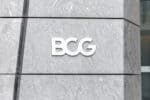
Introduction to Strategy Consulting
Discover what consulting is all about in this free course from BCG. Learn how to reframe questions and challenge assumptions.
Avg. Time: 2 hours
Skills you’ll build: Critical thinking, creativity, brainstorming
Depending on the specific company, you may have the case study interview questions in advance, but you may not. Whether you do or don’t, here’s how to prepare for a case study interview.
Conduct Deep Research
Good interview prep for any interview means researching the company. That includes things like learning more about the company’s mission and the challenges the industry faces. But when you’re preparing for a case study interview, your research needs to go deeper.
When you answer a case study question, your answer has to be specific to the company’s clients or business objectives. For example, if you’re interviewing for a role in strategy consulting , your answer shouldn’t focus on aspects of human resources consulting (unless it’s particularly relevant).
Your research needs to include the kinds of clients the company works with and what types of problems the company solves. For example, the company may only consult for Fortune 100 companies that need accounting advice. Keep these facts in mind as you prepare for the interview.
Case Study Interview Formats
There are four types of case study interview formats:
- Candidate-led: The interviewer asks you a specific question (or gives you a prompt), and you walk the interviewer through a detailed answer.
- Employer-led: The interviewer leads you through a series of specific (and predetermined) prompts and questions, no matter your answers.
- Presentation: You’re given a problem in advance to create and present a detailed case study.
- Video: Similar to a presentation case study interview, you’ll create a video presentation of the case study.
Most companies will tell you in advance which style of case study interview you should prepare for. But if they don’t, reach out to your recruiter or check the company’s website. Many include the essential details you need to prepare for the case study interview.
Seek Out Company-Specific Tips
Speaking of companies and their websites, not only do many companies that use case study interviews tell you the format, they often include helpful tips and tricks to help candidates prepare. This includes what to expect, what the company is looking for skill-wise, and what kinds of responses they want. They may even have a few practice questions and videos you can use to help you prep.
Unlike other common interview questions , it’s not as easy to prepare an answer to case study interview questions. Even though you know it’s a case study interview, you don’t necessarily know the specifics of the case or what problems you’ll be asked to solve.

Cybersecurity
Work through a case experience in this free course from PwC Switzerland. Create a pitch, conduct a risk assessment, and explain your findings.
Skills you’ll build: Risk management frameworks, cause analysis, risk impact assessment, system security
That said, it’s likely your case study interview questions will cover one or several of these concepts:
- Entering new markets
- Increasing profits
- Cutting costs
- Turnarounds
- Mergers and acquisitions
- Pricing strategy
- Developing new products
- Industry analysis
- Competitive response
While there are many ways to answer case study interview questions, a few basic prep tips can help you get ready for every question.
In addition to what you usually bring to a job interview , make sure you bring a notepad and pen or pencil to a case study interview. Taking notes will help you better understand the questions and formulate your answers. It also gives you a place to calculate numbers and figures if you need to. Not every case study interview allows calculators, so you’ll need to be ready to do your calculations manually.
Ask Specific Questions
As you’re working through the case study, you can and should ask any clarifying questions you need. The interviewer wants to hear specific, detailed answers that solve the problem. So, whenever you’re unclear, ask a follow-up question to not only get what you need but to give the interviewer what they need.
That said, your question(s) should be very specific. You need to verify exactly what the interview is asking so you can create an appropriate answer. Say the interviewer gives you a broad question: The client’s revenue is falling. How do you help them increase it? You can follow up with a very specific question or two to make sure you understand what the interviewer is asking:
You’re asking how I would help the client raise revenue, correct? Are you also asking how I would help them increase their profit and cut costs?
>>Related: 5 Top Questions to Ask in an Interview (and Why You Should Ask Them)
Talk Them Through It
A big part of the case study interview is seeing you in action. However, in this case, “see” really means “how you think.” Since the interviewer can’t hear your inner monologue, you’ll need to practice thinking out loud.
While the interviewer wants to hear your solution, they also want to hear how you got there. That means talking through your entire thought process. Instead of saying, “I’d do X,” you have to explain how you arrived at your decision while you’re getting there.
Because not everyone thinks out loud, it may feel unnatural to you, and you likely won’t be expected to do it on the job. But it’s crucial to practice this skill — and it is a skill — because the interviewer is expecting you to do it in a case study interview.
Want to give a case study a shot? Try out a Forage consulting virtual simulation program and gain the skills you’ll need to ace a case study interview.
Image credit: Canva

Related Posts
Interview angst here’s what not to say in an interview, how to prep for consulting interview questions, 11 financial analyst interview questions (and answers), upskill with forage.

Gain job skills you can talk about in interviews.
- Crimson Careers
- For Employers
- Harvard College
- Harvard Kenneth C. Griffin Graduate School of Arts & Sciences
- Harvard Extension School
- Premed / Pre-Health
- Families & Supporters
- Faculty & Staff
- Prospective Students
- First Generation / Low Income
- International Students
- Students of Color
- Students with Disabilities
- Undocumented Students
- Explore Interests & Make Career Decisions
- Create a Resume/CV or Cover Letter
- Expand Your Network
- Engage with Employers
- Search for a Job
- Find an Internship
- January Experiences (College)
- Find & Apply for Summer Opportunities Funding
- Prepare for an Interview
- Negotiate an Offer
- Apply to Graduate or Professional School
- Access Resources
- AI for Professional Development and Exploration
- Arts & Entertainment
- Business & Entrepreneurship
- Climate, Sustainability, Environment, Energy
- Government, Int’l Relations, Education, Law, Nonprofits
- Life Sciences & Health
- Technology & Engineering
- Still Exploring
- Talk to an Advisor

How to Succeed in a Case Study Interview
- Share This: Share How to Succeed in a Case Study Interview on Facebook Share How to Succeed in a Case Study Interview on LinkedIn Share How to Succeed in a Case Study Interview on X
Instructor: Jena Viviano
You’ve nailed the first few rounds of interviews, and now you’ve been invited to participate in a case study interview. Curious about what this next stage of the process looks like? In this course, Jena Viviano breaks it down for you, explaining the basic components of a case study interview, how to prepare, and what to do to project confidence and engage your interviewer. Learn how case study interview questions are used and why employers find them beneficial. Discover the key elements that interviewers use to evaluate your answers. Plus, learn how to formulate key questions to dig deeper into the case, develop your own framework for every case study answer, and craft a conclusion with supporting rationale that’s concise and clear. Jena also provides tips for quelling your performance anxiety, as well as sample case study questions that give you a better understanding of what to expect.
How to Approach a Case Study - A Structured 4-Step Approach
- Last Updated February, 2023
The Internet is filled with frameworks on how to approach a case study. But which one will help you ace your case and land an offer at a top consulting firm?
At My Consulting Offer, former Bain, BCG, and McKinsey consultants have developed a proven 4-step approach that will help you tackle any type of case study. We’v helped over 600 recruits land the consulting jobs of their dream.
Want to know the secret? Keep reading!
In this article, we’ll walk you through our 4-step approach and talk about what the interviewer expects at each step, including:
- How to approach a case study.
- Clarifying the client’s objectives.
- Framing a logical structure.
- Making sense of the provided information.
- Giving a strong recommendation.
Let’s get started!
Approaching a Case Study
Analyzing the right case information, case interview opening: getting to know the key objective, concluding your case with a strong recommendation, framing a customized problem-solving structure.
A case interview always starts with a prompt. A prompt is the initial information about the case provided by the interviewer. It gives you a brief background of the client’s problem and the key objective.
Here’s an example:
“Your client today is an NYC-based violinist. She’s been saving up for her wedding, but she broke her leg and can’t leave her apartment. She’s got to find a new plan for coming up with her wedding savings now and needs help.”
In the above example, we get to know the background and the objective.
Background: Our client Maria is an NYC-based violinist and has been saving for her wedding.
Objective: Find ways for the client to increase her savings for her wedding without leaving her apartment.
After the prompt is given, you’re expected to drive the case forward. Our 4-step approach will help you do just that.
- Opening – Understand and reconfirm the objective and ask clarifying questions.
- Structure – Develop a problem-solving structure to answer the key questions.
- Analysis – Dive deeper into analyzing relevant issues and use data provided by your interviewer to make conclusions.
- Recommendation – Give a strong actionable recommendation by tying together the insights.
Let’s dive into each step of the 4-step guide so you can solve cases like a pro!
The first step to solving any problem is to know the key objective a.k.a. the “north star” which will help you guide the case in the right direction.
This seemingly simple, but it’s where many interviewees fail. They think the prompt has given them all the relevant information, so they rush to start solving the problem.
But, as you saw in the prompt, the objective is touched upon but isn’t clear or measurable . You got to know that the client is looking for ways to increase her wedding savings while staying in her apartment with a broken leg.
We still don’t know what the target is and how much of it is already saved. Additionally, as there were no clarifying questions asked, no other details were shared by the interviewer.
Nail the case & fit interview with strategies from former MBB Interviewers that have helped 89.6% of our clients pass the case interview.
What should the Case Opening Look Like?
It’s important to ask questions like:
- What does success look like for the client? Does she have a target in mind for her wedding?
- How was she making money before she broke her leg?
- What are her income streams?
- Is she willing to cut her expenses to increase savings or is she looking only for ways to increase her income?
These questions help us understand the following:
Tangible or Measurable Objective – What is the target in the client’s mind?
Additional Information – prior income sources, income source while stuck in her apartment, her focus on increasing income rather than reducing costs.
What does the interviewer expect from you in the case opening?
- Restate the prompt in your own words
- Confirm the key objective
- Ask a few key clarifying questions (3-5) to know more about the overarching context of the case – making sure you understand the client’s product, business model, or geographic focus
Now let’s learn how to create a comprehensive and customized problem-solving structure.
The internet is filled with problem-solving approaches and frameworks, like:
- The BCG 2 x 2 Matrix
- The Profitability Formula
- McKinsey’s 7S Framework
- Porter’s 5 Forces
These frameworks help break business problems into smaller parts that can be analyzed to figure out a solution. But as these frameworks are generic, it might feel like they are being force-fitted to the problem in your case. No standard framework will ever fit all situations.
Creating a case-specific problem-solving structure isn’t difficult and with the right approach, you can create it with ease.
How to Create a Customized Structure
Start with the key objective, increasing Maria’s savings for her wedding. How can we break this problem down into sub-parts? If you were using a generic framework, you might use the 3C + P framework and break the problem into:
- Competitors
You could then think of questions in each bucket that would help Maria understand potential opportunities to expand her income.
But, with this approach, you wouldn’t be likely to stand out! Lots of candidates will approach this case with the same 4 buckets. This is why a customized approach is important.
While creating your structure, there are a few things that you should do to ensure that your structure touches on all relevant points and helps you to drive the case forward. Your structure should be:
- Logical – Each bucket in the structure should logically align with the key objective.
- Personalized – As you are creating the buckets, personalize them to the case at hand.
- MECE – MECE stands for “ Mutually exclusive, Collectively exhaustive .” This helps you ensure that there are no overlapping buckets and you cover all the key aspects of the problem.
- Depth – As you dig deeper into each bucket, ask yourself if you have covered all possible questions in the bucket. Create sub-buckets of the main buckets wherever necessary.
You can read more about structuring your analysis of business problems in our article on issue trees .

What does a Good vs. Great Structure Look Like?
Comparing the two structures above, we can see that Candidate B has created a better structure than Candidate A. Although Candidate A covered all important aspects, Candidate B has personalized their structure to Maria’s problem.
Communicating the structure in an easy-to-understand manner is as important as creating a robust structure. When communicating the structure:
- Ensure that the interviewer can follow your structure.
- Communicate one level at a time.
- Use a numbered list to walk through the structure.
After walking the interviewer through the structure, you should choose the bucket that should be explored first to answer the key question. You could say something like –
“Now that we have walked through the opportunities for increasing her revenue, I’d like to dive into the skills Maria has that she could leverage.”
The interviewer could either agree or disagree with the first bucket that you want to dig deeper into. Some companies, like McKinsey, use interviewer-led case interviews and will lead you through the case following a specified path. Others, like Bain and BCG, will let you lead the case and just nudge you if you seem to be veering off-path. In either case, you’ll need to start by brainstorming and providing ideas on the first bucket or you’ll need to analyze data and derive conclusions.
There are 3 main types of analysis you may need to do to answer the key question:
Brainstorming
Market sizing, exhibit reading.
Let’s see how each of these would help us drive the case forward and derive conclusions.
In a brainstorming exercise, a strong candidate will generate 8-10 ideas bucketed into categories. In the current case example, you could be asked for ideas on how Maria could make more money.
One set of categories you could use to generate ideas follows what we call the “X-not X” approach. Essentially, you start with a bucket like “playing music” and generate ideas in that bucket. Then switch to “not playing” and generate ideas for this bucket. This will help you in generating at least 2x ideas you otherwise would and will look more impressive to your interviewer because it is MECE and structured.
Let’s see how brainstorming plays out in our case example.
“Maria likes your approach and wants to start right away. Because she is currently not making any money, she would like some ideas. What are some ideas you have on how she could make money? She only wants to focus on leveraging her violin talents.”
The above example shows how you could use the “X-not X” approach to generate a lot of ideas – and how you could even further structure the ideas into “online” and “offline” categories to make it an exceptional brainstorming example.
You may also be expected to calculate the size of a market for your client’s product or service – after all, one of the most important things to know before pursuing an opportunity is the size of that opportunity. In the current example, you could be asked to calculate the income that Maria could earn by offering online violin classes.
There are 2 approaches to market sizing:
- Top-down: This is used when there are no constraints. In this approach, you start with the overall population that may be interested in the product or service and slice it down based on the segments of the market most likely to purchase. The top-down approach is best for national and global markets.
- Bottom-up: This approach is used when there are some constraints, like supply constraints, a limited number of hours, etc. In this approach, you start with the limiting factor and try to estimate the maximum that can be achieved based on the constraints.
Let’s see how we can use market sizing to help our client.
“Maria likes the ideas you came up with. She thought about being a violin teacher at one point since she had a great one when she started as a kid and is curious, how much could she make if she were to teach one-on-one Zoom classes for the next month? She wants to start small before she goes to group classes and, in the beginning, it will be just her teaching.”
Here’s an example of how you could work through this question:
The above shows how you could estimate the income which our client can expect to make in the first month.
Follow up your analysis by giving your answer the “sniff test.” Does it seem right at a high level? Here we see that $4,000 is the estimated first month’s income, but as this would be the first time Maria will be taking online classes, she won’t be working at full capacity from the start. Her earnings will probably be lower than $4,000.
But, in the long run, it’s a good idea to start offering lessons because at full capacity, Maria will be able to earn $8,000 per month.
In case interviews, you’ll be expected to derive conclusions based on tables or charts provided by your interviewer. In the current example, you could be asked to help the client prioritize which type of client should she target for her violin classes.
Let’s see what data is available and how we can conclude which segment to go after.
“Maria is happy to know that you think providing 1:1 violin lessons over Zoom is a viable idea.
She knows that a lot of people are interested in violin lessons, but to make sure she can tailor her marketing and lessons, she is interested in only going after one or two segments.
Which one should she go after?”
The first step to deriving insights from an exhibit is to read it thoroughly and ideally interpret it aloud as you go for your interviewer. This chart has data about willingness to pay and competitiveness across various segments. It gives an idea about the level of competition from other violin instructors. The market size of each segment is portrayed using the size of the circle. At first glance, it might seem that the client should go ahead with the segment which has the lowest competition and highest willingness to pay, which is the “Adult-Advanced” segment. But, that segment has a really small market size and Maria would need extensive teaching experience to cater to advanced students.
This is the first time Maria is getting into this market, but she also wants to have a high earning potential. The optimum segment would be one with a good market size and a reasonable trade-off between willingness to pay and competitiveness.
Based on this, Maria should go with the “college-intermediate” and “adult-intermediate” segments. She would be able to cater to both these segments with ease. Additionally, the combined market size is considerable and the relative trade-off of competitiveness and willingness to pay is suitable as well.
What does the interviewer expect when you are doing analysis and deriving insights?
- Pause to think about the structure for marking sizing or ideas for brainstorming. If you’re asked to read an exhibit, take a moment to understand it and lay out what it says to your interviewer before interpreting the data it provides.
- Offer insights into your client’s problem as the data presents them and draw conclusions.
- Drive the case forward based on the insights. What does this data mean for solving your client’s problem?
Maria came to you with a problem in hand and won’t be thrilled to just get the insights in bits or pieces. Pull your problem-solving together for her with a persuasive recommendation.
Think of the case interview as baking an amazing cake. While the structure and derived insights form the main ingredients for baking the cake, the recommendation is like the cherry on top. It helps in creating a lasting positive impression.
Similar to the opening of the case, the recommendation can seem relatively straightforward, but it is definitely nuanced. MCO’s 5R framework could help you deliver great recommendations for every case.
How should you present your recommendations?
MCO’s 5R Framework:
- Recap: As consultants, you deal with CXO (e.g., CEO, CFO) level clients who are busy with many projects, so recapping the problem you’re solving is essential to set the tone of the meeting.
- Recommendation: State your recommendations clearly without any additional detail to showcase clarity.
- Reasons: Follow this with logical reasons for your recommendations to provide context and show the credibility of the recommendations.
- Risks: Every decision has risks associated with it. Just lay them out so the client knows what to watch out for during implementation.
- Retain: End the recommendations with key next steps to pursue the opportunity, ensuring continuous engagement with the client.
Let’s see how to give a strong recommendation for our case example.
“Your client calls you and wants to know what you recommend.”
What does the interviewer expect when closing the case?
- Keep the recommendation clear and succinct keeping the audience in mind.
- Explain everything with a reason and point out risks associated with the recommendation.
- Be presentable and communicate the recommendations with confidence.
- Ensure that the next steps are clearly laid out.
A final note: Not all cases have a “Right” and “Wrong” answer. In some, the math is very cut and dry but in others, there is a mix of evidence and it is a judgment call on what to recommend. Remember that a well-defended recommendation is more important than the “exact right answer.”
– – – – –
In this article, we’ve provided frameworks and tips to ace the different sections of a case interview. You are now equipped with the knowledge to:
- Approach a case study.
- Clarify client objectives.
- Frame a structure for effective problem-solving.
- Analyze the right information.
- Give a recommendation.
Apply these tips by practicing sample cases with case partners as much as possible so you’ll be ready to ace your next consulting case interview.
Happy casing!
Still have questions?
If you have more questions about how to approach a case interview, leave them in the comments below. One of My Consulting Offer’s case coaches will answer them.
Other people preparing for consulting case interviews the following pages helpful:
- Our Ultimate Guide to Case Interview Prep
- Case Interview Frameworks
- Issue Trees
- MECE Case Structures
- Case Interview Examples
- Case Interview Formulas
Help with Case Study Interview Prep
Thanks for turning to My Consulting Offer for advice on case study interview prep. My Consulting Offer has helped almost 89.6% of the people we’ve worked with get a job in management consulting. We want you to be successful in your consulting interviews too. For example, here is how Sharmeen was able to get her offer at BCG.
We want you to be successful in your consulting interviews too.
If you want to learn more about how to ace your case interviews, schedule a free call with a member of our team. We’ll show you how you get an offer without spending hundreds of hours preparing.
Leave a Comment Cancel reply
Save my name, email, and website in this browser for the next time I comment.
© My CONSULTING Offer
3 Top Strategies to Master the Case Interview in Under a Week
We are sharing our powerful strategies to pass the case interview even if you have no business background, zero casing experience, or only have a week to prepare.
No thanks, I don't want free strategies to get into consulting.
We are excited to invite you to the online event., where should we send you the calendar invite and login information.

- May 13, 2020
A Quick Guide to Preparing for a Case Study Interview
Recruiting & Careers Social Influencer
Reviewed by Chris Leitch

Invited to participate in a case study interview but not sure about the best ways to get ready for it?
As you always want to be at your very best when interviewing with a company, the case study interview requires a bit more preparation than recognising some of the common types of job interviews .
While you’ll still need to impress a prospective employer with strong research, confident interview responses and a professional appearance , the case study interview tests your knowledge and abilities through a spontaneous, analytical exercise. It examines how you approach problem-solving with the pressure of handling a situation without previous knowledge of any details or context.
Although the consulting industry utilises it as an essential part of the hiring process, the case study interview can be also found in many other environments, including startups, government and corporate organisations. It measures a candidate’s analytical, logic reasoning and communication abilities while under pressure.
In this guide, we will cover what you need to know to successfully prepare for a case study interview.
Case Study Interviews Explained
Even if you’ve never participated in one, it’s likely you’ve heard stories about the case study interview format. The case study puts you, the candidate, on the spot to solve a business problem posed by the interviewers.
Case study interview questions cover a wide range of topics and do not look for a single ‘right’ answer. Instead, the format gives the interviewers a look at how you respond spontaneously while applying problem-solving skills to create a solution to the business challenge presented.
For example, an exercise might ask what the potential market size is for a vegan food company within a prospective city and if setting up shop within the region would be worth it. The case study may not share all the details to help you reach an answer, but it should prompt you to ask questions that help you structure your thought process.
What to Expect in a Case Study Interview
The ways by which a case study interview is conducted will vary by company. However, this format bears unique characteristics:
- You’ll receive an introduction to the business problem, its relevant details and other information that lend to setting context. Some companies may choose to share a briefing document for you to read, while others may prefer to communicate the scenario in conversation.
- Information about the business problem will be, to some degree, vague. While the problem may cover complex business concepts, expect that the information will provide a high-level description of the scenario – not detailed reports with specific facts and figures. Case study interviews present such information in general terms for a reason. They’re meant to provide just enough information so that you can choose how to approach your line of questioning to solve the problem.
- The discussion about the business problem will be led by either the interviewer or the candidate. You need to be prepared for both situations. Who leads the conversation about the business problem is important, as it reveals the direction the discussion will take.
In interviewer-led sessions, the interviewer seeks to gauge the quality of your approach as it relates to a specific part of the business problem. They control the dialogue, focusing on a series of tough questions unlike those considered to be difficult in other interview formats . The interviewer sticks to a line of questioning that refers to details and themes relevant to the business problem, and evaluates how you comprehend, interpret and recommend actions within this specific domain.
On the hand, candidate-led conversations evaluate your ability to understand a business problem comprehensively, and from multiple points of view. Consultants play different roles on projects. Their actions cover various levels of activity, from analysing the business facts and data, creating the solutions and communicating directly with the clients on the overall strategy and approach. You’ll need to show strong methodology to guide others in your process.
Candidate-led sessions are challenging because they give you the freedom to explain your best approach to tackle the entire problem, but without receiving the input or comments of others to help guide a conversation along.
How to Prepare for a Case Study Interview
As you might find these interviews to be difficult, intense and downright nerve-wracking , you can succeed in a case study interview through thoughtful preparation. Here are five tips to help you ace the interview:
1. Demonstrate Your Analytical, Reasoning and Communication Skills
While recapping key details of the business problem is important, the case study interview measures much more than your ability to recall the facts. It showcases how you think on your feet as you seek out information to determine your course of action.
While you might be comfortable sketching out a framework or a mathematical formula that helps you identify the way you wish to solve the problem, this interview format also tests your ability to explain the reasoning in a clear and believable manner to others.
To be successful in a case study interview, you must demonstrate the skill to process information quantitatively, as well as speak about your rationale and decisions convincingly.
2. Get Ready to Play an Active Role in the Discussion
Case study interviews require a high level of engagement. While other interviews might have you responding to questions with rehearsed answers, the case study interview presents a situation that is dynamic and unpredictable.
You’ll want to approach the session with an active disposition. This typically includes taking notes, documenting your observations and ideas, sketching out diagrams and charts, and asking follow-up questions throughout the interview .
3. Identify the Type of Problem Posed to You
Jobseekers may find that there are common themes that appear when covering the type of business problems found in case study interviews. Eight of the most common exercises explore these questions:
- Maths – eg: ‘How many more units do we need to sell to double the profit?’
- Market size – eg: ‘How big is the market size within the US for smart wearable devices?’
- Framework/Issue tree - eg: ‘Identify the factors you would consider in addressing the problem.’
- Data-chart insights – eg: ‘What story do the numbers tell about the operations of this business?’
- Value proposition – eg: ‘What factors do customers look for in choosing a mobile phone carrier?’
- Business valuation – eg: ‘Just how much is this company worth today, and would it change if acquired by our competitor?’
- Hypothesis – eg: ‘What are some possible reasons that explain this trend?’
- Brain teaser – eg: ‘How many tennis balls can you fit in an area that is twice the size of a football field?’
There is not a single approach that solves all business problems. By identifying the type of problem you’re encountering, you’ll be able to quickly determine the most appropriate method to apply.
For example, you might discover that a maths problem will rely on the knowledge of specific formulas and expressions, while a hypothesis question calls for a closer look at the root causes behind an issue.
4. Organise a Framework that Helps You Solve the Problem
Having a good framework to apply to a problem is the key to doing well in a case study interview. You want to show that you understand a business issue well enough to formulate recommendations or insights that address the problem. As there isn’t one right answer to such a problem, your interviewer will be interested to hear about the thought process you applied to arrive at your decisions.
The process may involve a range of problem-solving skills and methods, including the use of mathematical formulas, first-hand knowledge about an industry and decision-tree flowcharts that guide through questions you’ve applied to the issue.
It’s helpful to write down your framework and refer to it as needed. By having the steps outlined, you’ll be able to explain your recommendations in a clear and confident manner so that the rationale used in your analysis appears sound.
5. Practise, Practise, Practise!
Prepare for the case study interview by engaging in mock practice sessions before the big day. While it’s important to spend time putting together the methods you’ll use to analyse a business problem, enlisting the help of a friend or two familiar with this interview format is essential.
You’ll want to find case study examples online and share your selections with those helping you practise. Your friends should read the materials before the practice sessions and play the role of the interviewer.
By conducting a practice session as if it were the real thing, your friends will help you work through the awkwardness and spontaneity of the case study interview and develop the confidence to perform successfully.
By following these tips, you’ll be ready to show off your analytical, communication and problem-solving skills, all important to the case study interview. However, don’t limit your preparation only to the guidance given for this specific style; rather, you’ll want to make sure you continue the things that served you well for other interview formats, including making a good first impression and avoiding interview faux pas .
By combining those behaviours with the preparation, mindset and practice needed to solve business problems on your feet, you’ll put yourself in a great position to succeed at a case study interview.
Have you ever found yourself in a case study interview? What advice do you have to give? Let us know in the comments section below!
Interview Preparation
Interview Formats
Finding a Job

Case Interview Prep – Useful Tips and Frameworks
Without case interview prep, you have no chance of getting a job offer from a consulting firm . And since preparing for case interviews is very different from preparing for a normal job interview, we've put together a detailed guide that takes you step-by-step through your case interview preparation. You can find the 9 ultimate case interview prep tips , different frameworks you can apply to the most common cases, and helpful expert tips from our case coaches. We have also provided a pdf with 5 case studies for you to download for free .
If you have not read the case interview guide and firstly need some more general information on case interviews, make sure to read it first and then come back here to get more detailed tips on how to prepare for the actual case interview and solve it with confidence in front of your interviewer !
- 1. Case Interview Preparation: 9 Tips for a Successful Case Prep
- 1.1 Learn the Theory
By reading this article, you have already taken the first step of getting to know what case interviews are all about. Well done! You can now proceed by learning the theory you need to know to solve them. In general, you should learn how to:
- Identify your case type (e.g. Market sizing , Market entry , Profitability , Growth )
- Structure your thoughts (e.g. Issue tree , MECE , Pyramid principle )
- Use business analysis tools (e.g. ABC analysis , Breakeven , Benchmarking )
- Define common terms of business (e.g. NPV , CAGR , Fixed and variable cost )
In our Case Interview Basics , you can find all the necessary basics.
- 1.2 Gradually Develop your Business Intuition
As you need to have good business sense to successfully pass your case interview, you should dedicate some time before gradually building up your business intuition. The earlier you start doing this, the easier it will come to you. All you have to do is make it a habit of regularly reading business publications or magazines. You can choose new insights from McKinsey , Bain , and BCG or find other sources that appeal to you. While you do that, try to develop a basic knowledge of business, strategy, and industries , such as retail, airlines, telecom, banking, natural resources, and tech.
- 1.3 Bring your Mental Math up to Speed
All case interviews involve doing math without a calculator which is why brushing up your math skills should be a constant part of your daily prep plan . Practice until you are a hundred percent comfortable doing basic additions, subtractions, divisions, multiplications, and growth rate calculations in your head. Read our article on Fast Math and make use of our mental math tool in order to practice your efficiency. This will greatly ease the pressure if confronted with a math problem in your interview.
Knowing the shortcuts for a wide range of calculations will help you simplify math problems. For example, break down complex math problems into multiple smaller operations:
= (100 - 3) x (50 + 3)
= 5000 + 300 - 150 - 9
- 1.4 Practice Makes Perfect
Take a look at our vast Case Library with which you’ll be prepared for all possible case types. Our case collection includes cases that have been used in case interviews in the past. Solving cases on your own can give you a first feeling for them, but the only way to improve the skills you need to pass your interview is to put yourself in a case interview situation. Find a few outstanding candidates you can practice with and practice cases on a regular basis . The more perspectives you can get, the better. Feedback will help you improve.
On PrepLounge, the world’s largest case interview community awaits you. Simply schedule or accept a mock interview with another candidate on our Meeting Board ! Here is how it works:
- Schedule: After you and your case partner have confirmed the mock interview on the Meeting Board, your meeting is set and should be visible on your dashboard.
- Communication: We recommend you directly get in touch with your case partner to confirm your method of communication during the interview (e.g. Skype) and case preferences.
- Interview: During the back-to-back meeting you will take turns with your case partner in order to play both interviewer and interviewee roles. Don’t neglect the part of the session where you play the interviewer role . It will help you notice points of importance and adapt your approach accordingly.
- Case: There will be two PrepLounge cases randomly selected by default, but you can also change them and pick one of our other 190+ cases or use your own case.
- Feedback: This is the most important part of your mock interview as it helps you to improve your case performance. Please give valuable feedback to your case partner. You would want them to do the same!
- 1.5 Get Support from Experts
To make your case interview preparation as effective as possible, we recommend you also invest in coaching sessions with experienced top consultants. Our experience shows that this will be worth it, as it significantly increases your chance of getting your dream job offer (by four to be exact). Our experts know exactly what interviewers want and can work with you on every aspect of your case performance , whether it is structure, personal fit, confidence, or communication. They can even give you valuable networking tips and help you get a referral.
We offer you a transparent list of coaches , including their professional and educational backgrounds, top skills, individual approaches, reviews, and recommendation rates. This allows you to individually choose the perfect experts for your coaching sessions . You may also benefit from our C oachingPlus Package that comes with an overall discount.
- 1.6 Learn and Keep Track of your Progress
You can do as many cases as you like, but if you do not learn from them, you will not going to improve your case performance . This is why you should do the following: At the end of each case that you solve, whether it is on your own, with a case partner or expert, write down in your own words what mistakes you have made and what you learned. After a few days, redo the case and apply your learnings to ensure that you are making progress. Keeping track of your improvements will keep you motivated and make sure that you don’t repeat the same mistakes .
- 1.7 Don’t Forget About the Personal Fit
It doesn’t matter how much you ace the case, but if you are not a personal fit for the company, you will not get the job offer. After all, consulting is a people’s business , that includes teamwork and spending a lot of time with your colleagues. In order to ace the personal fit part of the interview, it is important that you understand what an interviewer is looking for in a candidate to decide that he or she is a personal fit. Typically, the interviewer has three key questions in mind.
Then, you have to learn how to convey to the interviewer that you comply with what he or she is looking for. Practice your answers to personal fit questions with other candidates or experts:
- Why management consulting ?
- Why company x?
- Why should we hire you?
- Tell me about yourself!
- Give me an example of a time that you have led a group to achieve a difficult goal!
- Find more Stress Questions
- 1.8 Practice Confidence
The more you practice, the more confident you will automatically feel. However, feeling confident is not equal to seeming confident. Sometimes you can come across as insecure without even noticing and this can be due to minor communication style habits. Therefore, you should ask your PrepLounge case partner or expert to take your verbal and non-verbal communication into account and to give you feedback on your level of confidence or insecurity . Try to focus on the following aspects during your practice:
- Sound of your voice. A monotone voice or speaking too fast gives an impression of insecurity and a poor communication style. To avoid that, you can listen to podcasts with great speakers for about 30 minutes to one hour per day. After a couple of days, you will start to speak in a similar manner, as you will absorb their communication style.
- Smile. Smiling can be a powerful element to show that you enjoy the interview (and interviewer) and are not afraid. You can force smiles (obviously not too much) in case you get feedback that you seem too serious.
- Eye contact. You should do not need to constantly look the interviewer in the eyes, but you should not look away when he or she asks you something and you should not stare, either.
- Ability to break the ice. Confident people are not afraid to start small talks with interviewers from the beginning. Keeping silent creates less connection and may be considered a sign of lack of confidence.
- Posture. You should try to keep straight in the chair most of the time. Leaning too much towards the interviewer can be seen as a lack of confidence.
- 1.9 Take Breaks
In total you should prepare for well over 50 hours in up to a 6-week time period , practicing on a daily basis. This can be exhausting, and we know that a lot of candidates struggle with a lack of motivation and focus , especially after an intense period of case prep. This is usually because they forgot to implement regular breaks in their prep plan. Professional athletes will always take time to rest to give their muscles time to regenerate, and so should you for your brain muscle. A good strategy is to develop an evening and morning routine that gives you time to relax and maximizes your energy level for the prep during the day. Here are some examples of what you can do:
- 15-20 minutes of exercise in the morning or evening
- A cold shower in the morning
- Meditation or writing a journal
- Define three important things to do for the next day and allocate the time for all activities while doing the most important ones first
- No social media one hour after you wake up and before you go to sleep
- Get enough sleep (at least 7 hours)
- Take breaks between each case or intense case practice session and do something totally different (e.g. workout, play video games)
- 2. Case Interview Frameworks
There is no magic formula that can be applied to every case but there are frameworks and methods that can be learned; with practice, you can ensure you are able to answer any case that you come up against.
Anyone that has started delving into case interviews will likely have come across the frameworks designed by Victor Cheng. These are effective frameworks that have been adapted from widely published frameworks such as porters five forces . These can generally be applied to most case studies and learning them should definitely feature in your preparation.
Most firms are wise to these frameworks now and will even mark you down for applying one blindly . They want to see you think on your feet rather than apply a learned response. Using these frameworks is a great foundation that you can build upon, sometimes just changing the headings is enough to show you are able to create a bespoke solution.
- 2.1 Types of Frameworks
There are three key framework types that can help tackle the toughest of case interviews . Whilst it is possible to learn particular frameworks prior to interviews, using frameworks from memory can result in being penalized by the interviewer. Deploying one of the following framework types with bespoke parameters is all that is required to develop an exceptional answer.
The three framework types are; bucket, issue tree, and matrix. All three allow for a methodical approach but are more effective when used to answer different types of questions.
Issue tree: Great for profitability questions and any market sizing elements. Each ‘root’ of the tree allows for the isolation of the problem and clear analysis. Often this is used in conjunction with a bucket framework.
Matrix: Usually taking the form of a table but sometimes a pair of the axis (BCG matrix). This framework is great when having to draw comparisons such as in competitor analysis or M&A suitability. The key is to use only the minimum necessary parameters in order to make a clean and simple comparison.
Bucket: The most commonly used framework, it is very good for finding the root cause and developing a good idea of the bigger picture. Laying this framework out at the start also provides a checklist to work through which should prevent any unexpected mental blocks.
- 2.2 Five Key Frameworks
- 2.2.1 Profitability Framework
This framework takes the form of an issue tree (sometimes referred to as a logic tree), it isolates the clients' profitability problem into its key components. Following its branches, it is easy to identify where the issue lies and visualize where it fits into the bigger picture. The branches of this issue tree satisfy the MECE principle and therefore if followed correctly, it should lead you to the cause.
Often a case will require you to identify the root cause of an issue and then subsequently recommend solutions. In this scenario, it is likely that a bucket framework will be required for the solution section.
A profitability question will normally contain a sentence such as “PepsiCo has experienced declining profits” and therefore should be easily recognizable. Any case involving profits or one of its components (revenues and costs) will require a profitability framework.

Three equations to learn:
1. Profits = revenue – costs
2. Revenue = units x price
3. Costs = Variable costs + Fixed costs
Profits = revenue – costs
This is the overarching equation that you are looking at but as always you must dig deeper into each component of the equation to find the crux of the issue.
Revenue = units x price
Units can be increased by increasing the number of customers buying the current products (usually sales & marketing) or by increasing the number of products purchased by the current customer base (upselling).
Increasing the price of a product is usually the quickest way to increase profits but this will affect the number of units that can be sold at that price, the magnitude of the effect will depend on the elasticity of demand and alternatives available to the consumer.
Costs = variable costs + fixed costs
To increase profits variable costs can be reduced by reducing the costs of inputs per unit. Increasing buying power or increasing efficiency on a per unit basis, such as automating steps of the manufacturing process, are ways of achieving this.
Fixed costs can be reduced by removing unnecessary costs or by maximizing the efficiency of current resources. Relocating the office to a cheaper location is an example of reducing fixed costs directly and increasing manufacturing production to 100% from 80% capacity would reduce the fixed cost per unit.
- 2.2.2 General Framework
Developed on a framework made popular by Victor Cheng, this general-purpose framework is capable of being adapted to the majority of case interview questions. This framework can be an alternative to the growth and market entry frameworks below if you are short of preparation time and cannot learn all the suggested frameworks.
This case interview framework primarily serves as a checklist to ensure you cover all the relevant elements in the case. It is still important to remain disciplined and methodical by exhausting each point before moving on to the next.

a) Consumer:
Useful mnemonic: Whales Wave With Police Constables
Who – the demographic of the customer base e.g age, gender, individuals, businesses, etc.
What – the products they are buying and reason for buying this product e.g stapler to help organize paperwork
Where – the location of the customer base e.g UK, Europe, global
Price – the prices that customers have been paying
Consumer risk – how concentrated are these customers, what effect will lose certain customers have on total revenues? (Usually fewer customers = higher risk)
b) Client:
Useful mnemonic: Every Dog Is Four
Expertise – What the client is capable of and where their limitations are e.g great at manufacturing clothes cheaply but bad at luxury design?
Distribution channels – How is the client getting their product in front of customers? e.g wholesale, retail, direct to consumer, e-commerce, etc.
Intangibles – does the client possess anything intangible that may affect the strategic decision? such as strong brand recognition or intellectual property.
Financial Situation – what financial resources does the client have to make the necessary investments or absorb the cost if the project fails?
c) Product:
Useful mnemonic: Why Eight Children Started Laughing
What – the details of the product the client sells
The elasticity of demand – how much of a necessity is the product to consumers? For example, petrol has a high elasticity of demand for those with petrol cars it’s a necessity.
Compliments – are there any existing compliments to the product? e.g a phone case compliments a phone
Substitutes – are there any indirect competitors (especially emerging ones) such as tablets were to the laptop market (different products competing for the same consumers).
Lifecycle – how long does the product last? When will consumers be purchasing again? E.g a sandwich may have a lifecycle of 24 hours but a car is more like 5 years.
d) Market:
Useful mnemonic: My Children Tried Saying Rebellious
Market share – the breakdown of competitors and their respective market shares of the target market.
Competitor observations – the competitor's response to the same situation or anything notable in how they differ from the client.
The threat of new entrants – what is going to prevent another entrant to the market and what effect would this have?
Supplier risk – how concentrated are the suppliers, what effect would lose the current supplier have? (usually few suppliers = higher risk)
Regulations – are there any regulations that have or will have an effect on the client?
- 2.2.3 Pricing Framework
Whilst pricing cases are less common it's sensible to know at least the basics of pricing strategies. Without the basics, it would be easy to flunk the case unnecessarily. The three common pricing strategies are cost-based, value-based, and competitor-based.
Cost-based pricing: The addition of a target profit margin to the full unit cost.
Value-based pricing: The value that the product provides to the consumer. Usually worked out via a cost-saving, additional benefits over and above existing products or similar.
Competitor-based pricing: Taken from what competitors are charging and what this product offers in comparison.

- 2.2.4 Market Entry Framework
This market entry case interview framework is a development of the general framework, it places more emphasis on the strategy of understanding the target market and market capture. It is still possible to answer these questions with the general framework but it is likely to convey a lack of originality to the interviewer.
Market entry questions usually explicitly state the intentions to enter a new market such as “Bosch is looking to enter the South American market”, making them easily recognizable.

a) Market:
Useful mnemonic: Small Childish People Prefer Marrying Red-heads
Size – what is the size of the target market?
Customers - who are the customers and what are their needs and preferences?
Product types – what products is the market receptive to? Do changes need to be made to existing products?
Profitability – are the current players in the market profitable and by how much?
Market share – what is the current market structure of its participants?
Regulations – are there any regulations that could affect the client from successfully entering?
b) Financials:
Useful mnemonic: Fighting Is Overly Exuberant
Financial situation – what financial resources does the client have to make the necessary investments or absorb the cost if the project fails.
Investment required – to enter the market what initial costs are there? E.g building manufacturing facilities.
Ongoing costs – what costs will be incurred following the initial investment of entering?
Expected revenue & ROI – what is the expected return from entering the market?
c) Client capabilities:
Useful mnemonic: Children Eat Children Maltesers
Expertise – what the client is capable of and where are their limitations? e.g great at manufacturing clothes cheaply but bad at luxury design.
Entry experience – has the client entered a market before?
Market entrants – has anyone entered the market before? If so, does the client have the same capabilities?
d) Entry strategy:
Useful mnemonic: Tall People Try Oranges
Timing – when is the best time to enter?
Pilot – will a pilot be used (99% yes) and what size will it be? Who will participate?
Type – how will the expansion be executed? Self-built, M&A, Joint venture?
Operation location – will the new operation be run from head office or the new location?
- 2.2.5 Growth Strategy Framework
This growth framework is an alternative to using a combination of profitability and general frameworks. It simplifies the question of growth nicely by segmenting the problem into internal and external factors.
During a growth strategy case, it is important to remain pragmatic. It is easy to get carried away with elaborate ideas such as ‘build an app’ but hard to offer sensible ideas with real potential for the client and their current operations. This isn’t to say you should not offer all of the ideas in the beginning but then choose which ones you would recommend they explore further based on the situation in front of you. This is a good chance to show good business acumen.

a) Internal
Current situation - what is the financial health, growth and profitability of the company today?
Drivers of financial performance - for this particular company what impacts profitability the most?
b) External
Industry - what is going on in the industry? (market share, growth rates, new entrants)
Customers - who are the customers and what have their historical buying trends been?
Competitors - who are they and what have they been doing? How have they grown themselves
- 2.3 The Best Frameworks When Solving Cases
A framework may help you to solve the business problem in your case interview in a more structured and concise way. You should know the most common types of cases in order to determine which might be a suitable framework you can apply. Our coaches Guennael and Vlad explain their approaches:
What does a framework really have to do? Basically, 3 things :
First, be MECE (Mutually Exclusive, Collectively Exhaustive); Second, help you go through the case in a structured and methodical way to not only allow you find the best answer; Third, convince your interviewer that your success is repeatable and that you will crack this case and the next and the next.
Back when I was prepping for my BCG interview, I ended up falling back on just two frameworks, which I'd then tweak to fit the actual case: First, a version of the profitability model (Profit = Revenue - Cost, and Revenue = Price x Quantity); Second, a basic version of (Product, Price, Client, Competition, Company). Are these 2 frameworks optimal in every instance? No, they are not. Did they do the trick? I have used them in the 10+ practice cases with former BCGers, as well as in my 5 BCG cases... and I got in, so there's that :) I would even argue that every case can be solved by using either or both of these frameworks. Learn them, keep them in your back pocket, and be ready to use them. If you find a better one, great! But I'd rather you started with an "ok" framework and focused on solving the problem than spending 30 seconds at the beginning of the case to find the "perfect" framework , failed, and found yourself having to think on the fly as your start the solving process.
There is no one-fits-all structure. You should have some patterns in mind for specific case types, however, you should change them depending on the:
- Additional details of the case
Below you can find a list of the most common case types and some high-level recommendations on structuring:
- Market sizing - structuring from the supply or demand side. Structuring using a formula or using an issue tree
- Profitability - basic profitability framework. Remember about different revenue streams and product mix
- Market context cases (Market Entry, New product, Acquisition, etc). Always start with the big picture "market". Finish with something the specific strategy to answer the objective of the case (e.g. "Entry strategy" - for market entry. "Exit Strategy" for PE case. "Go-to-market strategy" for a new product case). Structure it as if you are defining the work streams for the real project.
- Operational math problem (e.g. Should we increase the speed of an elevator or just buy a second one? How should we reduce the queues? Etc.) - Structuring as a process/value chain, with inflows, operations, and outflows
- Cost-cutting - I provided the recommendations on structuring it:
Structuring:
- What is the cost composition and what are the biggest costs
- Benchmarking of the biggest costs to find the improvement potential
- Process improvements to meet the benchmarks
- Costs and benefits of the proposed initiatives
The key concepts that you have to learn:
- Internal / external benchmarking
- Core processes (usually are optimized) and the supporting processes (usually are cut)
- Math structures (Frequency of operations * time per operation)
- Other useful structures (e.g. people - process - technology)
- Valuation - Purely financial structure with cash flows, growth rate, WACC / hurdle rate, etc.
- Synergies - revenue synergies (price, qty, mix) and cost synergies (value chain).
- Social/economics cases (e.g. How to improve the quality of life in the city? How to increase the revenues of the museum?) - huge variability. Practice 3-5 social cases before the interview
Besides that, there is a bunch of useful frameworks that you can apply in the middle of the case to find the root cause of a problem . E.g.
- People - Process - Technologies
- Capacity - Utilization - Output rate
- Product - Distribution - Marketing - Price
- Value-based pricing - competitive pricing - cost-based pricing
You will learn these frameworks while solving the cases. It's useful to have a bunch of them in mind to be able to identify the root cause quickly .
- 2.4 How You Should (Not) Use a Framework
With frameworks, you are structured in every case . They give you a helping hand and guide you like a red thread through your case. However, you should not be too fixated on specific frameworks. A framework should always be adapted to the respective situation. Our coach Sidi explains why:
You can (and should) get acquainted with all of these frameworks. But you should NOT use them as blueprints to structure your approach towards ANY given case! One big misconception that I, unfortunately, see with many many candidates needs to be called out again and again:
Structure DOES NOT equal frameworks!
The different frameworks that you can find in pertinent case literature provide a very good basic toolbox in terms of which areas to look into for certain types of problems. However, they are very poor regarding HOW TO APPROACH a case and HOW TO DRAFT A ROADMAP for solving the case. This approach and roadmap need to be rooted in a rigorous and specific logic. Unfortunately, the "framework learning philosophy" brought forward by, e.g., Case in Point, is the very reason why an overwhelming majority of candidates will not get an offer.
By and large, most (or probably all) casebooks on the market are teaching a fundamentally flawed way how to think about business/strategy / organizational problems! A framework as such is worth nothing if it is not embedded into the specific context of the situation! This means each element that you want to scrutinize ("building blocks" of the framework so to speak) needs to clearly relate to the question that you want to address! This principle should form the basis of any structure.
This is why you ALWAYS start from the specific question that you want to answer! From there, you define the criterion or criteria that need to be met to answer this core question in one way or another.
In 95% of cases, value creation will be the central element. Ultimately, this is nothing else than profit generation over a specific time frame. You then draw a driver tree for profitability to isolate the numerical drivers for your solution. And then, only after you have drawn out the driver tree, you can map out the relevant qualitative "framework elements" to the sub-branches. This approach, visualized by means of a rigorous driver tree, is much much clearer than any framework you will find in any case book. And, contrary to such frameworks, which are hanging in the air and do not logically relate back to the specific question, this is a bulletproof approach when done rigorously.
The caveat is: this requires time and qualified coaching to internalize. But ultimately, this is how consultants think about problems - how can we optimize for value creation?
- 2.5 How to Develop Your Own Framework in 4 Steps
In order to address unique issues in case interviews, it is important to develop your own frameworks . Our expert Benjamin gives you tips on how to do it:
1. (almost) Never use a standard framework taken from the books. Strategy consulting is about helping clients facing unique issues with a tailored answer. Forcing your approach in a standard framework is unlikely to be relevant
2. Project yourself in your client's shoes and show empathy for its problems. By doing so it will be much easier for you to understand what are the key topics to cover to formulate a recommendation and make sure you don't forget anything. I always ask myself "what would I do if this was my business and my own problem? What do I need to know/understand to make a decision ?"
3. Make sure every topic you want to cover is relevant for the final recommendation. A simple check is to ask yourself "If I spend time on this specific topic, and get some answers to my questions (ex. market sizing, competition, etc.), will this bring useful element for the final recommendation given my client's problematics"? If the answer is no, then you should drop this sub-issue.
4. Practice a lot, with any daily case you can set up on your own. The above tips are taken from my own experience doing my best to build MECE structures, but keep in mind that it takes a lot of practice to achieve a satisfying performance here. I have developed an exercise called structuring drills, that focus your effort on learning to build a structure. This is usually very appreciated by candidates.
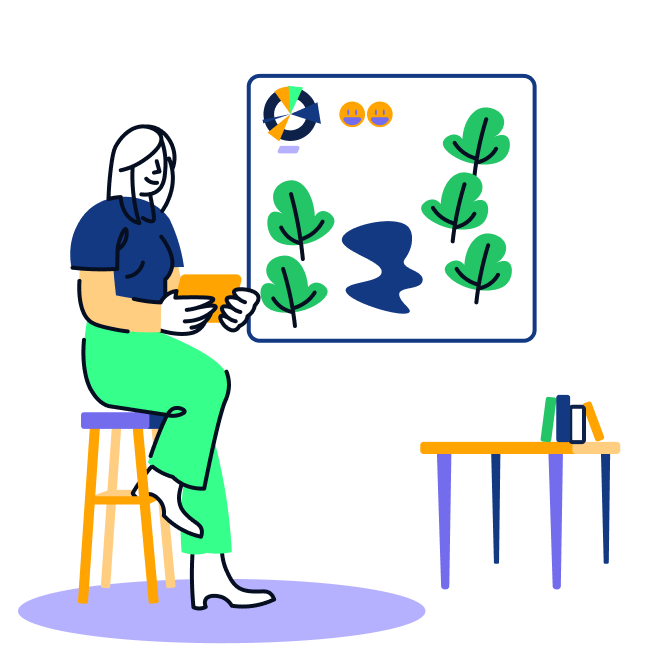
- 3. How to Solve a Case Study in 10 Steps [Infographic]
![how to pass case study interview How to Solve a Case Study in 10 Steps [Infographic]](https://www.preplounge.com/uploads/content-pages/69/1646742264-8knpi0peh1np.png)
Step 1: Listen actively and take notes. Write down every piece of information, especially numerical data.
Step 2: Restate the question. Pause, paraphrase and make sure you understand the problem statement by confirming with the interviewer.
Step 3: Clarify the objectives and identify the problem. Ask specific questions and double-check on objectives. Make sure you completely understand the problem.
Step 4: Write out your structure. Ask your interviewer for a minute to prepare your structure and organize your notes. Identify your case type and use an issue tree to customize your structure. The branches of your issue tree should be MECE.
Step 5: State your hypothesis. Now that you have set up the issue tree, your task is to test each branch to see if it is the root cause of the problem. Where to begin? A hypothesis based on an educated guess helps here. (e.g. "Since you have mentioned that revenues are more or less flat, my hypothesis is that the problem is mostly driven by the cost side of the business. If it is okay with you, I will start by […]")
Step 6: Think out loud. Sharing your thoughts allows the interviewer to interact. Refine or rebuild your hypothesis as you find out more.
Step 7: Gather more data in order to test your hypothesis. Proactively ask for relevant data and always segment it (e.g. using the ABC analysis ). Try to evaluate whether trends have been company-specific or industry-wide.
Step 8: Dig deeper while staying structured ( MECE !) throughout the case. Always refer to the structure you have set up at the beginning of the case but be flexible as the case evolves. If you conclude that your hypothesis is false, eliminate that branch and go to the next one. Summarize findings when switching major branches. If your test confirms your hypothesis, go deeper into that branch, and drill down to the lower levels until you identify all proven root causes.
Step 9: Choose a recommendation and use the Pyramid Principle to structure your conclusion. Ask for a minute to gather your thoughts and then state your recommendation. You need to deliver a one-minute, top-down, concise, structured, clear, and fact-based summary of your findings.
Step 10: Stand by your conclusion. Your interviewer will likely challenge your recommendation (either to see if you can handle pressure or to assess if you really believe in what you are saying).
- 4. PrepLounge: The Key to Your Success
To become the best, you must learn from the best. That is exactly what PrepLounge can offer you. The vast PrepLounge community makes it easy to find case partners with the same ambitions and goals as you. Whether you are looking for a professional case coach or other aspiring consultants, you will have no problem finding case partners in the build-up to your interview. Our PrepLounge coaches – from Bain to McKinsey – are uniquely qualified to provide you with insights into the mastery of a case interview.
Apart from case partners from every imaginable background, PrepLounge provides a colossal collection of online resources to give you the best preparation leading up to your case interview. We will provide you with questions and answers to the most important consulting case types and share in-depth knowledge for the best possible case interview preparation. You will be able to find case partners to practice online and always be on top of the latest insights and news regarding consulting jobs and top consulting firms .
As a PrepLounge member, you will receive access to all these perks. PrepLounge will accompany you all the way from your application through to your contract negotiation . You strongly diminish your chance of success without sufficient preparation. Invest in your future and give yourself the best chance at acing your case interview ! Exchange your experience with peers from all around the world in our Consulting Q&A . Join our case interview community today and embark on your journey into consulting!
- Get started right away and practice your first cases

Oliver Wyman Case: Full Electrons Ahead
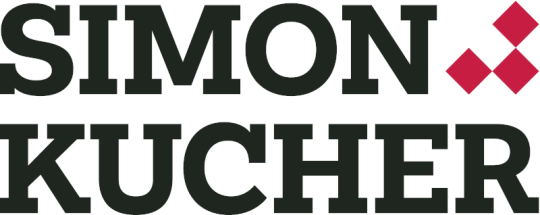
Simon-Kucher Case: GST Cruise Company

Deloitte Case: Footloose
Oliver wyman case: setting up a wine cellar.

zeb case: Quo vadis, customer?
Continue to learn.

BCG Case Interview Guide
Are you facing a BCG case interview? We have the ultimate preparation guide for you!

Consulting Industry Trends in 2023
Find out what will happen in the consulting industry in 2023.

The Difference Between MBB and the Big Four in Consulting
Dive into the world of the consulting industry now

- Select category
- General Feedback
- Case Interview Preparation
- Technical Problems
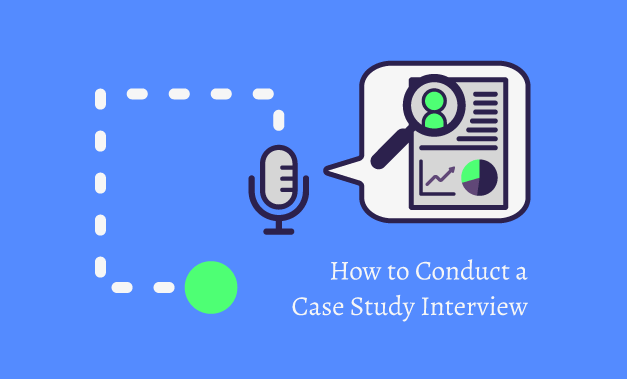
How to Conduct a Case Study Interview
Julian lumpkin.
- March 17, 2022
- Creating Case Studies
In this article, you’ll learn how to conduct a Case Study interview.
In a previous article, we discussed how to thoroughly prepare before interviewing a Case Study subject. Interview prep is an absolutely essential step to ensuring that you have an excellent Case Study, so before you interview your subject, make sure you’ve gathered the following key pieces of information:
- Your company’s value to the client
- Key success metrics from the client
- Background information about the client from internal stakeholders
Following the interview prep is the interview itself. This article identifies each step of the interview with your Case Study subject. It also offers specific questions and strategies you can use so you end up with a high-quality, successful Case Study interview.
Watch the four-minute video version of this article here , or just read on!
Review Case Study Interview Prep
Prior to your interview, review all the key information you gathered prior to your interview. The information will help shape some of your interview questions.
If you have any questions about the information, talk to your internal stakeholders. But remember: You don’t need to know all the same in-depth details that the interviewee does. Part of a successful interview is getting the Case Study subject to simplify the problem and solution so that anybody could understand. You just need enough knowledge to represent your company well and be able to ask thoughtful follow-up questions.
Clarify and Confirm Expectations About the Case Study Interview
Once you start the call and conclude the initial pleasantries, you’ll want to take the following actions before the interview gets underway.
State the goal of the Case Study interview
The person you’re interviewing is an expert on the subject or situation and may have overly technical explanations that will alienate and confuse the common reader. Remind the person you’re interviewing that you’re not doing a deep dive into the details. Instead, you’re looking for a very simple overview of the problem the person had and the solution your client provided. Setting this expectation early will help ensure you get a compelling story from the interviewee.
Estimate the length of the Case Study interview
We usually tell our interviewees something like the following: “This should be a fairly quick and painless process. We’ll just ask you a few questions about your experience with ABC Company. This generally takes about fifteen to twenty minutes, and no longer than thirty minutes.”
Remind the interviewee that the call is being recorded
It’s always respectful—and in some states required by law—to let everyone on the call know you’ll be recording the conversation.
Inform the interviewee that he or she will have an opportunity to review a draft
People are often nervous during interviews and may be concerned they’ll say something wrong. Help put your interviewee at ease by reminding him or her at the beginning of the call that he or she will have a chance to review the Case Study draft before it’s finalized.
Confirm permissions given (or not given)
Getting permission prior to the call is a key part of the interview prep process. Still, it may be helpful to confirm or discuss the permissions given. We’ve found that people who, prior to the interview, said they won’t allow you to use their name or likeness will actually change their mind if you ask on the call. It never hurts to ask politely one more time.
Ask Questions About the Problem or Situation
The best way to approach your interviewee’s problem or situation prior to receiving your company’s solution is to ask, “What was it like before working with us?”
Asking this question is going to reveal some surface-level issues. However, your job is to dig deeper.
When your interviewee refers to a problem, ask more questions about it. Ask what having those problems meant for the business, its bottom-line, and its employees in their day-to-day work.
As an example, if the interviewee says that the business’s content management system kept crashing, ask, “What problems did that cause for your team?”
As you ask these questions, you’ll uncover more in-depth problems, which is perfect—you’re effectively setting up your company’s solution.
Ask Questions About the Solution
You want to really connect the problems your interviewee had with the solutions your company provided.
Here are some great set-up questions to ask:
- How does your team use our product?
- In what ways does using our product change your day-to-day operations?
- How is this an improvement for you?
Asking these questions will get your interviewees excited about the solution provided. It usually doesn’t take much to connect the dots of how your company solved their problems.
Ask Questions About the Results
The ideal Results section is stuffed with specific metrics that demonstrate how your solution improved their business. If you have metrics like this, ask your interviewee questions like, “How did our product help save you fifty hours of work per month? How has that helped to improve your business/your day-to-day life?”
Clients often don’t have specific metrics to share, though, but this is okay. As a workaround, ask opinion-based questions instead of asking the interviewee to elaborate on metrics. For example, try something such as “I know you don’t have specific numbers for growth, but how does our product help you to grow as a company? Has it made you more efficient?”
While the responses aren’t as powerful as solid numbers in a results section, the interviewee will often provide strong quotes, which are a great substitute.
By following the steps outlined above, you’ll put your Case Study subject at ease and keep your interview focused on the issues. You’ll also collect all the pertinent information you need to write a solid first draft of your Case Study.
If you need further help writing your Case Studies, reach out to us at [email protected] .

Julian has focused his career on B2B sales and sales management, specifically bringing new technologies to market. After years as an elite sales rep, he began leading teams, specifically focused on coaching sales reps on how to be direct, credible, and respected throughout the sales process. Julian conceived of and designed SuccessKit when running an 18 person sales-team at Axial, a b2b startup, as a way to help sales reps have better conversations by utilizing customer success examples and other content more effectively.
Recent Posts
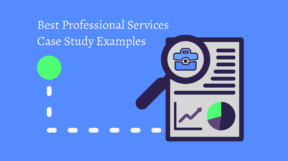
Best Professional Services Case Study Examples
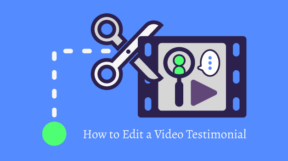
How to Edit a Video Testimonial
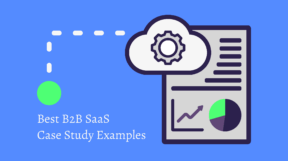
Best B2B SaaS Case Study Examples
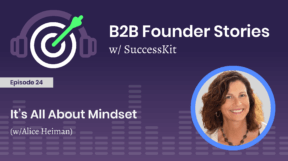
It’s All About Mindset (w/Alice Heiman) [PODCAST]
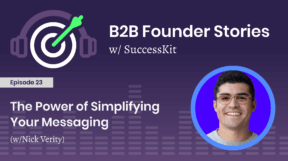
The Power of Simplifying Your Messaging (w/Nick Verity) [PODCAST]
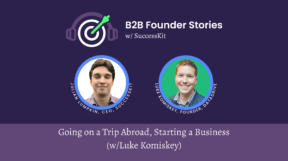
Going on a Trip Abroad, Starting a Business (w/Luke Komiskey) [PODCAST]
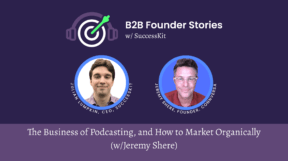
The Business of Podcasting, and How to Market Organically (w/Jeremy Shere) [PODCAST]
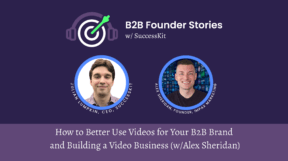
How to Better Use Videos for Your B2B Brand and Building a Video Business (w/Alex Sheridan) [PODCAST]
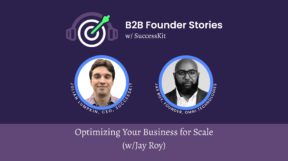
Optimizing Your Business for Scale (w/Jay Roy) [PODCAST]
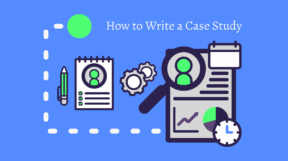
How to Write a Case Study
Leave a comment, leave a reply cancel reply.
Your email address will not be published. Required fields are marked *
Save my name, email, and website in this browser for the next time I comment.
What people are saying
Milo Sindell President, Skyline G
“If you’re looking for Case Studies, this is a really nice little organization to partner with. Our experience, frankly, has been excellent.”
Franklyn Peart Co-Founder, CentreStack
“We’re already recommending SuccessKit to our customers.”
John Morgan Director of Marketing, Elemental Machines
“The SuccessKit team has been great. We can tell them, ‘ABC Company had this problem,’ and they will document our solution.”
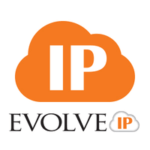
Don Mennig CEO, Evolve IP
“Julian and his team have done an excellent job for us. Definitely recommend working with them for Case Studies. ”
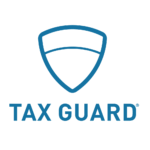
David Bohram Director of Marketing, Tax Guard
“I didn’t think it’d be successful to outsource Case Studies, but Julian and his team made it so easy.”
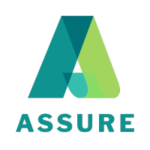
Erin Wathen Director of Branding and Events, Assure
“I really appreciate how SuccessKit takes the reins and produces such great results, allowing us to focus on what we need to do to grow the business.”
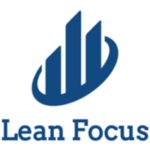
Damon Baker CEO, Lean Focus
“SuccessKit’s Case Studies give us a distinct advantage over our competition when prospects are comparing service providers.”
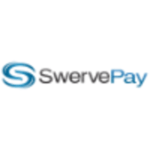
Chris Connor Sales Manager, SwervePay
“We’ve really appreciated the work that Julian and his team have done for us. Very happy with the results.”
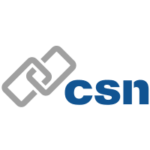
Shawn O’Daniels CEO, CSN
“SuccessKit figured out how to show the world what we do for our clients. I am blown away by the Case Study .”

James Dirksen CEO, DeepSurface Security
“This is just about the best Case Study I’ve ever seen.”

Christopher Levy CEO, BuyDRM
“The Case Study SuccessKit created for us was elite.”
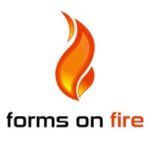
Kendall Kunz CEO, Forms On Fire
“SuccessKit made it easy for clients to see what other clients see, and it’s led to more sales.”

Phil Curtolo Vice President of Sales, Software Consulting Services
“SuccessKit takes the pain and suffering out of creating quality Case Studies.”

Luke Anemone CEO, COMMANDO
“Working with SuccessKit has been pivotal in growing our client base and giving potential advertisers really good content about what we can do.”

Linze Kay Lucas Business Analyst and SEO Consultant, Stellium SEO
“I cannot speak highly enough about my experience working with SuccessKit. They were completely respectful of my client’s time and needs, as well as my own.”

Joanie Berkery Marketing Director, Adapex
“SuccessKit really helped us build the framework and presentation for our Case Study.”

Troy Stein VP, Customer Advocacy, TechSmith
“Quality results. Authentic storytelling and quotes. Easy to work with. I’m signing up for more.”

Julie Matheney Associate Director of Digital Marketing, Feathr
“I highly recommend the SuccessKit team to anyone who’s looking to produce Case Studies.”
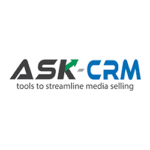
Robin Smith Founder and President, ASK-CRM
“We are definitely recommending SuccessKit to the peers that we work with and our existing clients.”
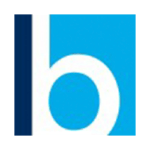
Ace Rosenstein President, Bravo Business Media
“I recommend SuccessKit due to the efficiency and the extreme price to value.”

Ari Haas Founder, Dijy
“The SuccessKit team knows what they’re doing. It’s easy to work with them, the end result is a beautiful product, and all parties involved feel super comfortable.”

Sidney Rogers Marketing Manager, Groove Technology Solutions
“The SuccessKit team is very professional, and they ensure that they take care of everything in a timely manner.”

Ashlyn Burgett Director of Marketing, Dedicated IT
“The SuccessKit team makes the Case Study process painless, and they have the expertise to create high-quality content that is invaluable to sales and marketing teams.”

Carly Brightwell Head of Marketing, North Labs
“If you need Case Studies for your business, we highly recommend SuccessKit. We recieved exactly want we asked for!”

Luke Komiskey Founder and Managing Director, DataDrive
“I love working with the SuccessKit team because they make it really easy for me to focus on my business while they produce Case Studies that drive our brand forward.”
Have a question? Reach out to us directly.
Center for Career Development

Case Interview Preparation
Case interviews are designed to test an applicant’s ability to solve business problems and demonstrate skills valued in the consulting field. Firms seek applicants who can think logically and strategically under pressure, give evidence of strong communication skills and exhibit the ability to work with a team to address often quickly changing priorities.
What is a case interview?
Interviewers present a hypothetical business challenge and assess how you explore the problem and conceptualize and structure a solution. As you process the case they are looking for key traits and skills. Interviewers assess how you:
- Listen to information about the business problem and probe deeply or broadly with thoughtful questions posed to the interviewer while building rapport
- Think out loud and express your ideas concisely, responding quickly and confidently, and deal with the pressure of the interview process
- Use quantitative and qualitative analysis to creatively and logically problem-solve
- Toggle between details and the big picture
- Communicate understanding of business concepts such as falling markets, introducing a new product or entering a new geographic area
Which traits are consulting firms seeking in candidates?
Interviewers use case interviews (and any behavioral interviews that may follow) to assess the skills listed above and your flexibility. They want to see how easily you can change direction, both in your understanding of client problems and your ability to navigate unpredictable situations with clients and others. The ability to get along with different personalities and to integrate into teams with new co-workers and client partners is an important skill.
Some positions require frequent travel to client sites. They seek candidates who can change venues frequently and work in unstructured work environments without an office or administrative support.
How long is a case interview?
A preliminary, first-round interview is typically one case for 30 minutes to an hour. Additional interviews may include several cases conducted by different professionals within a few hours.
How to prepare
Review multiple sources to gain information and insights. You should also prepare for behavioral interview questions, which may follow your case or be part of subsequent interviews. You can find preparation tips for behavioral interviewing in our interview guide , and library of resources includes more than 500 cases, nine video courses, 10,000 case drills, 11 industry primers, and 12 chatbot cases through Management Consulted .
Other strategies to prepare include:
- Review sample cases and outline your answers
- Practice mental math to work with quantitative data more easily
- Review brain teasers and practice solving them
- Practice case interviews with friends who you know are also applying to consulting opportunities
- Contact alumni who work in consulting (you can start by looking up alumni in Career Compass ) to learn more from them or practice cases with them
- Attend information sessions with consulting employers to learn about their case interview processes
- Study the consulting organization with which you are interviewing to understand their types of clients
- Keep current on business issues and financial markets to understand trends
- Be prepared to devote time over a number of weeks to become proficient with the different types of case interview questions
Where can I find more resources to help?
Management consulted.
All Princeton undergraduates, graduate students and alumni have free access to Management Consulted , a consulting and case interview prep resource.
Consulting companies' websites
Many of the top consulting firms offer their advice about case interview preparation. Some of them include interactive case practices which will give you a chance to walk through cases.
Videos and podcasts
Some of the major consulting firms have videos or YouTube videos of case interviews. Others may be created by former consultants, or firms who provide paid coaching services as well as free resources, such as podcasts and videos.
Firsthand is a tool to research employers, industries and other career subjects. Access is free for Princeton students courtesy of the Princeton University Library. The Firsthand Guide to the Case Interviews reviews case interview format, suggestions for preparation and evaluation tips.
Students and alumni have cited these books as being helpful:
- Case in Point (Marc Cosentino)
- Case Interview Secrets (Victor Cheng)
- Crack the Case System (David Orhvall)
- Cracking Case Interviews (Max Serrano & Jonathan Yarde)
Brain teasers/open-ended questions
Practice brain teasers, which require logical and quick-thinking to highlight problem-solving skills, attributes that are helpful for case interviewing. Brain teasers are not usually business-focused problems. An example would be: How many gas stations are there in the U.S.?
- Five Terrific Brain Teaser Questions (Indeed)
- How to Solve Google’s Crazy Open-Ended Interview Questions (Wired)
- 7 Insane Brain Teasers You Could Actually Encounter in an Interview (The Muse)
- How to Ace Guesstimate Interview Questions (Firsthand)
- How to Answer Brainteaser Interview Questions (Big Interview)
There are many consulting preparation-related websites that can help you navigate or practice case interviews. They typically provide free resources such as case walkthroughs, directories of consulting firms, annual consulting salaries data, but also have paid resources such as case interview prep assistance.
Consulting student groups and case competitions
Join Princeton student groups (e.g., Princeton University Graduate Consulting Club or Princeton University Nonprofit Consulting) to build connections and gain experience with consulting through speakers, projects and case competitions.
A case competition can be organized by student groups or consulting organizations. Teams of three to six tackle a real-world case by identifying key problems and providing a strategy for the client throughout a limited time period. In general, a group of representatives serves as judges, and they choose the best team(s) who may receive bragging rights, corporate gear or actual cash prizes.
Although case competition format or style may differ around the industry (e.g., finance, management consulting, healthcare), they all provide students with hands-on exposure to consulting with the opportunity to apply various skills (e.g., problem-solving, teamwork, critical thinking).
Related Resources

15 case interviews tips for McKinsey, BCG and Bain

If you are targeting a job in consulting, you probably already know what type of interviews to expect: a case.
In a case interview, your interviewer will ask you to solve a business problem. For instance, they might ask you how Coca-Cola could double their profit margin next year. Cases have got the reputation to be amongst the most challenging types of interviews and candidates tend to fear them. But it doesn't have to be that way.
Over the past few years, we've helped more than 20,000 candidates prepare for consulting interviews. We've learned about what works and what doesn't. We have also analysed all the case interview advice from McKinsey , BCG , Bain , Deloitte and other sources.
In this article we summarise the most important tips we have learned along the way. So let's get started!
Click here to practise 1-on-1 with MBB ex-interviewers
1. preparation tips.
It all starts with a good preparation. Here are a few tips you should follow to structure your consulting interview practice.
Tip #1: Start early
This might sound obvious, but case interviews can be challenging, so you should start preparing early. Some of the people we work with start studying up to 6 months before their interview. Starting that much in advance is not necessary to get an offer, but the earlier you start the higher your chances of getting an offer are.
Tip #2: Learn the fundamentals
The first thing you should do is learning the key concepts and core skills you need to get an offer in consulting. In other words, you need to learn the fundamentals. This website has many free resources you can use to do this. We recommend starting with our free case interview guide and our list of free case interview examples .
Tip #3: Practice with peers
Practicing with peers is useful to get live interview practice. This is something that is common on university campuses and is often organised by consulting societies.
If you are not already doing so, we definitely encourage you to find one or a couple of friends who are also preparing for consulting interviews and with whom you can practice. You will learn a lot both by playing the role of the interviewer and the candidate. Here's a list of consulting interview questions you can practice with.
Tip #4: Practice with experts
Practicing with peers will only get you so far. I f you really want the best possible preparation for your case interview, you'll also want to get feedback from ex-consultants who have experience running interviews at McKinsey, Bain, BCG, etc.
If you know anyone who fits that description, fantastic! But for most of us, it's tough to find the right connections to make this happen. And it might also be difficult to practice multiple hours with that person unless you know them really well.
Here's the good news. We've already made the connections for you. We’ve created a coaching service where you can do mock interviews 1-on-1 with ex-interviewers from MBB firms. Learn more and start scheduling sessions today.
Tip #5: Keep it up
Learning any new skill has got its ups and downs. Mastering case interviews is no different. Your performance probably won't be amazing on your first few cases. You will probably make mistakes even after you have practiced 15+ cases. Keep it up. It might take a while but everyone can make it to consulting by following the right step-by-step preparation plan.
2. Case interview tips
Now that you know how to approach your preparation, let's focus on a few tips that you should use during your actual case interview.
Tip #6: Listen carefully and ask clarification questions
At the beginning of the case, your interviewer will layout the situation of the company you are trying to help (e.g.: Coca-Cola's profits have decreased by 10% over the past 12 months). Your job in that part of the interview is to make sure that you understand the situation correctly by asking the right clarification questions (e.g.: in which countries have profits declined? And for which products?).
This is what partners at McKinsey and other firms do with clients. They sit down with them, listen carefully to the problem they have, and ask clarification questions before trying to solve the problem. They do this because it's impossible to solve a business problem you don't understand in details. And you should therefore follow a similar approach in your cases.
Tip #7: Structure, structure, structure
Once you understand the situation in detail, your interviewer will expect you to put together a framework that you will use to solve the problem your client is facing. For instance, if your client is facing a profits' issue, your interviewer will expect you to look into 1) potential revenue issues and 2) potential cost issues because profits issues can be due to one or both of these factors.
Consultants use frameworks and structure their thinking all the time because it's client-friendly. If you don't solve the problem in a structured way, your client will probably lose track of what you are doing and be unhappy. If you solve it in a structured way, they will know what you are working on at all times and feel that you have things under control. Interviews are the same. If you structure your approach and communicate in a structured way, you'll have a happy interviewer!
Tip #8: Don't reuse frameworks
One trap many candidates fall into is to reuse pre-existing frameworks in their interviews. As we explain in our case frameworks guide , interviewers will immediately notice if you do this and you will get penalised. Each case is unique, and you should therefore create a custom framework for every case you do. This might sound difficult but it actually isn't if you take the right approach.
Tip #9: Think before speaking
Consultants sell advice. Once you have said something it's hard to take it back. One of the things you learn as a junior consultant is to think first, decide how you are going to say what you want to say, and then finally say it. If you can do that well in your interviews it will truly set you apart. In practice, it means that you should take some time to organise your thoughts before speaking and that you should avoid jumping to conclusions.
Tip #10: Brush up your maths
Virtually all case interviews involve doing maths computations without a calculator. Having rusty maths at the beginning of your preparation is normal. But in our experience successful candidates take some time to brush up their maths when they start practicing. You should take the time to refresh your memory and be 100% comfortable doing basic additions, subtractions, divisions, multiplications and growth rate calculations mentally. We really encourage you to take the time to do this. Trust us, it's really worth it!
Tip #11: Draw conclusions
As we mentioned above, consultants get paid for their advice. One of the things clients hate is to pay a large sum of money and not get a clear answer about their problem. Even if they are halfway through the project, consultants avoid telling their clients: "We don't know yet." What they say instead is: "Based on what we have seen so far, our current hypothesis is that the profit decline you are experiencing is mainly driven by the Chinese market. We think this is the case for 3 reasons. Reason #1 is etc."
You need to do the same thing in your cases. At the end of the interview, your interviewer will ask for your conclusion. You can't dodge the question. You've got to give a clear answer with supporting arguments based on what you have learned doing the analysis. The trick is to caveat your answer with a sentence such as "Based on this initial analysis, etc." And to also highlight additional areas to explore to confirm that your current understanding is the right one.
Tip #12: Catch the hints
Finally, 99% of interviewers have good intentions. They're here to help you perform at your best. During your interviews they will give you hints about whether you are doing well or not. If they try to steer you in a direction, follow them, they're trying to help you. This might sound obvious but candidates sometimes get so stressed out that they don't pick up on the hints interviewers give them.
3. Fit / PEI questions tips
In addition to a case, your interviewer will also ask you one or two behavioural questions. Let's turn our attention to those and go through a few tips that you can use to impress your interviewer.
Tip #13: Research consulting / the company
The two most frequently asked fit questions you will come across are " Why consulting? " and " Why McKinsey? / Why BCG? / Why Bain? " You therefore need to do your research about consulting as well as the company and office your are interviewing for. Try to really understand whether consulting is a job you will enjoy doing. Try to meet consultants from the firm and office you are interviewing for. This will help you give genuine answers to these fit questions and will set you apart from other candidates.
Tip #14: Prepare for PEI questions
In addition to typical CV questions, consulting firms also ask personal experience interview questions . These questions are easy to recognise, they always start with: "Tell me about a time when..." They aim to test your soft skills such as your leadership or your ability to work in a team. A lot of candidates underestimate their importance and end up not preparing sufficiently for them. We recommend setting about 25% of your time to prepare for fit and PEI questions.
Tip #15: Try to convey confidence
We know this one is hard, but conveying confidence can make a big difference in your interviews. We all have doubts, and we are all stressed when we interview. It's perfectly normal. But you should try to keep these doubts and stress to yourself. You should try to look your interviewer in the eye and speak as confidently as possible. Conveying confidence is a core consulting skill and if you can do it in your interviews it will really take you a long way!
4. Conclusion
When it comes to preparing case interviews, it can seem like there's a lot to take in. Even when you've covered everything mentioned above, it's still hard to gauge your level and to be sure whether or not you're really ready to ace your interview.
That's one reason why mock interviews are so helpful. If you're interested, click below to browse from our many ex-interviewers from MBB firms, and book your mock interview at a time to suit you. Learn more and start scheduling sessions today.
Related articles:


Samantha Putterman, PolitiFact Samantha Putterman, PolitiFact
Leave your feedback
- Copy URL https://www.pbs.org/newshour/politics/fact-checking-j-d-vances-past-statements-and-relationship-with-trump
Fact-checking JD Vance’s past statements and relationship with Trump
This fact check originally appeared on PolitiFact .
Former President Donald Trump has selected Ohio Sen. J.D. Vance as his vice presidential running mate.
“After lengthy deliberation and thought, and considering the tremendous talents of many others, I have decided that the person best suited to assume the position of Vice President of the United States is Senator J.D. Vance of the Great State of Ohio,” Trump wrote July 15 on Truth Social.
Vance, 39, won his Senate seat in 2022 with Trump’s backing. He would be one of the youngest vice presidents in U.S. history.
But before becoming one of Trump’s fiercest allies and defenders, Vance sharply criticized the former president. During the 2016 presidential election, Vance wrote that he goes “back and forth between thinking Trump is a cynical a–hole like Nixon who wouldn’t be that bad (and might even prove useful) or that he’s America’s Hitler.”
WATCH: 2024 RNC delegates react to Trump shooting
He has since sounded a different tone including in defending Trump’s actions in the events leading up to and during the Jan. 6, 2021 attack on the U.S. Capitol. Vance was critical of Vice President Mike Pence’s handling of the 2020 election results certification and in an interview with Kaitlan Collins on CNN questioned whether the vice president’s life was actually endangered during the riots. Vance also vocally condemned what he sees as the tenor of political rhetoric, which he tied to an assassination attempt during Trump’s July 13 rally in Butler, Pennsylvania.
“The central premise of the Biden campaign is that President Donald Trump is an authoritarian fascist who must be stopped at all costs,” Vance posted on X shortly after the shooting. “That rhetoric led directly to President Trump’s attempted assassination.”
Who is J.D. Vance and what is his relationship with Trump?
Before winning his Senate seat in 2022, Vance worked as an investor, commentator and bestselling author.
Vance, who was born in Middleton, Ohio, served in the U.S. Marine Corps before attending Ohio State University and Yale Law School. He worked as a corporate lawyer before moving into the tech industry as a venture capitalist.
WATCH: JD Vance’s evolution from Trump critic to running mate
Vance rose to fame through his 2016 memoir “Hillbilly Elegy,” which describes his growing up in poverty and details the isolation, violence and drug addiction that often surrounds poor white communities in middle America.
When the book was released, Vance started talking to the media about issues important to people in his community — and started criticizing Trump.
Vance told ABC News in August 2016 that, although Trump successfully “diagnoses the problems” people are facing, he didn’t see Trump “offering many solutions.” In an October 2016 interview with journalist Charlie Rose, Vance said he was a “never-Trump guy.”
In another 2016 interview about his book, Vance told a reporter that, although his background would have made him a natural Trump supporter, “the reason, ultimately, that I am not … is because I think that (Trump) is the most-raw expression of a massive finger pointed at other people.”
Vance began to publicly change course when he launched his Senate campaign in 2021. He deleted tweets from 2016 that included him calling Trump “reprehensible” and an “idiot.” In another deleted tweet following the release of the “Access Hollywood” tape on which Trump said fame enabled him to grope women, Vance wrote: “Fellow Christians, everyone is watching us when we apologize for this man. Lord help us.”
He apologized about his Trump criticisms in a July 2021 Fox News interview, and asked people not to judge him based on what he had said. “I’ve been very open that I did say those critical things and I regret them, and I regret being wrong about the guy,” Vance said. “I think he was a good president, I think he made a lot of good decisions for people, and I think he took a lot of flak.”
In June, after news circulated that Vance was on Trump’s short list for vice president, Fox News host Bret Baier asked Vance about the comments. Vance said he was wrong about Trump. “He was a great president, and it’s one of the reasons why I’m working so hard to make sure he gets a second term,” he said.
Trump endorsed Vance in the Ohio GOP Senate primary, helping him win the race and the general election.
As a senator, Vance lobbied to defeat Ohio’s constitutional amendment that ensured access to abortion, calling it a “gut punch” after the measure passed.
After the hazardous East Palestine, Ohio, train derailment in 2023, which ignited a fire and led to evacuations and a controlled release of chemicals, Vance worked with Ohio’s senior senator, Democrat Sherrod Brown, to introduce rail safety legislation.
PolitiFact has fact-checked Vance 10 times. He’s received two Pants on Fire ratings, three Falses, two Mostly Falses and two Half Trues. He also received one Mostly True rating before he was a politician in 2018.
In March, Vance echoed a popular Republican talking point, saying that “100% of net job creation under the Biden administration has gone to the foreign-born.” We rated that Mostly False. Since Biden took office in early 2021, the number of foreign-born Americans who are employed has risen by about 5.6 million. But over the same time period, the number of native-born Americans employed has increased by almost 7.4 million. We rated False Vance’s claim in February that the $95 million Ukraine supplemental aid package included a “hidden impeachment clause against President Trump.” The measure doesn’t mention impeachment.
Because it’s the president’s job to spend congressionally appropriated funds, experts said whoever is elected president next will be responsible for spending the money allocated in the law. It doesn’t target former Trump; it would apply the same way to Biden, should he be reelected.
On immigration, Vance falsely claimed in 2022 that Biden’s “open border” meant that “more Democrat voters were “pouring into this country.” Immigrants who cross the border illegally cannot vote in federal elections. The process for immigrants to become citizens and therefore gain the right to vote can take a decade or longer.
PolitiFact also addressed controversial comments Vance made in 2021, surfaced during his Senate run, about rape being “inconvenient.”
Vance didn’t directly say “rape is inconvenient.” But when he was asked in an interview whether laws should allow people to get abortions if they were victims of rape or incest, he said that society shouldn’t view a pregnancy or birth resulting from rape or incest as “inconvenient.”
In the interview, which occurred before the U.S. Supreme Court overturned Roe v. Wade in 2022, Vance was also asked whether anti-abortion laws should include rape and incest exceptions. “Two wrongs don’t make a right,” he said in response. “At the end of day, we are talking about an unborn baby. What kind of society do we want to have? A society that looks at unborn babies as inconveniences to be discarded?”
When asked again about the exceptions, Vance said: “The question portrays a certain presumption that is wrong. It’s not whether a woman should be forced to bring a child to term, it’s whether a child should be allowed to live, even though the circumstances of that child’s birth are somehow inconvenient or a problem to the society.”
Since being on Trump’s vice presidential short list, Vance has expressed a more moderate view on abortion.
On July 7 on NBC’s “Meet the Press,” for example, Vance said he supports access to the abortion pill mifepristone after the Supreme Court dismissed the case against it — echoing what Trump said days before during the presidential debate.
Support Provided By: Learn more
Educate your inbox
Subscribe to Here’s the Deal, our politics newsletter for analysis you won’t find anywhere else.
Thank you. Please check your inbox to confirm.


Five Tax Takeaways from 2024 State Legislative Sessions
July 18, 2024
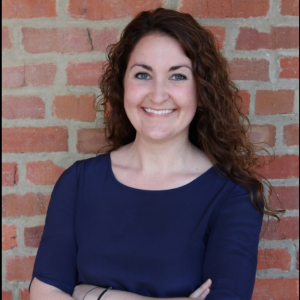
Aidan Davis State Policy Director
State lawmakers across the country navigated budget challenges and slowing revenue growth in 2024. This challenge was made worse by the winding down of temporary federal pandemic aid, coinciding with deep, permanent tax cuts . The impact of those tax cuts becomes clearer as they weigh on the ability of places like Arizona and Ohio to fund crucial public services.
Tough decisions must now be made to make up for lost revenue and fully fund key priorities like education, transportation, and health care. Fortunately, evidence-based tax policies can ensure that wealthy families and corporations pay their share toward the public services that benefit us all.
As we reflect on this year’s state legislative sessions, there are a few clear takeaways.
1. Major tax cuts were largely rejected, but states continue to chip away at income taxes.
This year brought smaller tax cuts than the past few years as tax-cutting plans were scaled back so lawmakers could balance state budgets. Many permanent income tax rate cuts that passed were measured by roughly a tenth of a percentage point (in Georgia, Idaho, Iowa, Kansas, South Carolina, and Utah). Half of those –Georgia, Iowa, and South Carolina – sped up cuts already on the books.
A handful of other states pushed through deeper income tax cuts. Arkansas passed a 0.5 percent top income tax rate cut – its fourth rate cut in less than two years. Kansas condensed its income tax brackets and lowered rates (cutting their top rate by 0.12 percentage points in the process). And West Virginia lawmakers announced the state’s personal income tax cut trigger will reduce each bracket’s rate by 4 percent – this results in a percentage point reduction ranging from 0.1 to 0.2, with larger rate cuts going to higher tax brackets. Those cuts come as the governor discusses a potential special session to focus on further tax cuts.
Kentucky’s debate, however, is beginning to shift in a different direction as lawmakers have started to question the feasibility of a law that would eventually eliminate the state’s individual income tax. The budget cuts required by such a move would be drastic and deeply unpopular.
Hawai’i also stands apart for its unusual approach to tax cutting this year: it did not cut tax rates, but did reshuffle brackets and increase the state’s standard deduction, setting the state up for a staggering $1.4 billion annual revenue loss by 2031, when the policies are fully phased in.
Narrowing the income tax base was also a part of the story this year in Kansas and West Virginia where lawmakers provided full tax exemptions for Social Security income, joining a long list of states that have rushed to provide carveouts to high-income seniors in recent years. And four states—Arkansas, Georgia, Idaho, and Utah—reduced corporate income tax rates levied on business profits. The rate reductions ranged from 0.1 to 0.5 percent, with Arkansas passing the deepest cut. By contrast, New Mexico and New Jersey strengthened their corporate taxes by raising rates on business profits.
2. More states focused on cutting property taxes, but lawmakers are largely missing the point.
Property tax cuts were hotly debated this year, with concerns over housing affordability and property tax affordability front and center. But lawmakers largely failed to deliver effective solutions to these problems.
The property tax cuts that passed in Arkansas, Colorado, Kansas, Georgia, and Wyoming, and that were under consideration in Florida, Nebraska, and elsewhere , were disconnected from ability to pay. This is a missed opportunity for lawmakers who have more targeted options at their fingertips: especially property tax circuit breaker s that can keep property tax payments at a manageable share of household budgets for low- and middle-income families.
3. States continued cutting taxes on groceries.
This year lawmakers in Illinois and Oklahoma removed groceries from their state sales tax bases. These actions continue a trend of states moving to reduce or eliminate taxes on grocery purchases, following state-level elimination in Virginia, a phasedown to elimination in Kansas, and reductions in Alabama, Arkansas, Tennessee, and Utah (pending voter approval) in recent years.
In Oklahoma, groceries were exempted from the state’s 4.5 percent sales tax, which will result in nearly $420 million in annual lost revenue. In Illinois, groceries were already subject to a reduced rate (1 percent instead of 6.25 percent) and lawmakers decided this year to remove the tax entirely.
Reducing or fully exempting grocery taxes reduces the overall regressivity of state and local tax systems. Too often, however, lawmakers pursue grocery tax exemptions without adequate consideration of their cost and whether more targeted options are available for aiding families most impacted by grocery taxes. Refundable tax credits for low-income families such as Earned Income Tax Credits (EITCs), Child Tax Credits (CTCs), and sales tax credits can help food-insecure families as much or more at a lower cost because they do not require giving tax cuts to high-income shoppers and out-of-state visitors.
4. More states discussed cracking down on corporate tax avoidance.
This year marks the second year in a row that Worldwide Combined Reporting , also known as complete reporting, passed a state’s legislative chamber. This makes clear that lawmakers and advocates are becoming more interested in stopping widespread tax avoidance by multinational corporations. Minnesota lawmakers led the charge in 2023 and Maryland lawmakers grabbed the baton in 2024. In addition to Maryland, the policy was also discussed in states as varied as Hawai’i, New Hampshire, Oregon, Tennessee, and Vermont this year.
Enacting this policy would be a huge step toward eliminating state corporate tax avoidance , as it neutralizes a wide array of tax-planning strategies corporations use to pretend their U.S. profits were generated overseas, outside the reach of state tax authorities. And, fortunately for lawmakers, the policy would be a natural extension of features that already exist in state tax law, as more than a dozen states and the District of Columbia currently allow or require companies to file returns that include some profits booked in foreign countries.
5. States continued creating and improving effective tax credits for families and children.
Public investments and family economic well-being are inextricably connected. Over the years, states have chosen to bolster support for low- and middle-income families through refundable tax credits that directly lift after-tax incomes.
This year alone, the District of Columbia and Colorado stand out for their moves to do more for children in their communities. D.C. passed a new fully refundable Child Tax Credit that will provide $420 per child under age 6 in low- and moderate-income families. And Colorado lawmakers passed a Family Affordability Tax Credit that, subject to state economic conditions, builds upon their existing refundable Child Tax Credit. The new credit provides a benefit of up to $3,200 in years of strong economic growth for children under 17 in families earning less than $95,000 a year. In New York, lawmakers opted to provide another one-time boost to the state’s Empire State Child Credit.
Colorado lawmakers also boosted their state Earned Income Tax Credit (EITC) to 50 percent of the federal amount in 2024, 35 percent in 2025, and a baseline of 25 percent in the following years with an option to raise it higher, depending on state economic conditions. Lawmakers in Illinois also provided a child bonus for children under 12 who benefit from the state’s EITC. Those qualifying working families will see a 20 percent increase to the state Earned Income Credit in 2024 and a 40 percent increase in 2025 and beyond.
Full Archive
All Blog Posts
Related Content
Reality interrupts the fever dream of income tax elimination in kentucky, property tax circuit breakers can help states create more equitable tax codes, scotus rejects expansion of trump’s corporate tax cuts, leaves broader tax questions for another day.

Chappell Roan’s Tour Wardrobe Is a Case Study in How to Build a Pop Star
Stylist Genesis Webb on crafting the singer's signature aesthetic
It’s been an unusually rich summer for pop music , but the 26-year-old pop singer has still managed to break through, thanks to what feels like a genuinely new blend of powerhouse vocals, queer pride , and high-camp style. Her origin story feels tailor-made for a moment when audiences prize authenticity but are also looking for escapism: Talented Midwestern girl flees sheltered Christian upbringing for L.A., writes a bunch of sad songs for a label that doesn’t quite know what to do with her, has a queer awakening, and is reborn on a new label as a glitter-spangled, face-painted phoenix, rising from the ashes with an album of bangers about sex, love, and dancing.
Like her pop foremothers, she couldn’t do it without a finely honed look, which means she couldn’t do it without her stylist, the also-26-year-old Genesis Webb . “She brings the element of glam drag, and then I bring an element of more punk club kid,” Webb recently explained to Bazaar .

Webb met Roan at a V magazine shoot, where the two bonded over being from the Midwest and growing up far outside the industry. “Coming from more lower-class backgrounds, it just kind of brings this sense of familiarity in a space like that. And she’s also such a girl’s girl, and I was one of the only girls on the set,” the stylist said. But what really stood out for Webb was Roan’s clarity of vision. “I’d worked with a couple people prior who were way bigger than her and who didn’t really have a lot of opinions. But she had this really specific thing that she wanted to do.”
That specific thing pays tribute to drag queens and pageant queens, horror movies and historic pop divas. It wasn’t exactly Webb’s personal aesthetic, which skews to the darker side: She’s more likely to wear black shredded garments and bleach her eyebrows. The first thing you notice about her is the big rosary tattoo inked up her neck, which she says she got to ensure she would never “work a normal job.” But she vibed with Roan’s appreciation for what she calls “Midwest trashy glam,” and Roan admired the racks of vintage Webb brought to the shoot.
Now, if you happen to be a scholar of Weird Pop Girl Aesthetics, you might recall that Lady Gaga met her own frequent fashion director and co-world-builder, designer Nicola Formichetti, on a V magazine shoot back in 2009. This might not be a coincidence worth mentioning, except that when Webb met Roan, the stylist was there as Formichetti’s assistant . Chappell Roan is clearly working in Gaga’s wake; she has the theatrics, the giant voice, the queer fan base that she’s here to serve. But she also warbles like Kate Bush, flouts convention like Madonna, and dances like nobody’s watching like Robyn.

As Roan’s stylist, Webb’s fashion influences are just as informed and thoughtful. She pulls from twisted old films like John Waters’s 1972 filth extravaganza Pink Flamingos (tagline: “An exercise in poor taste”) and the 2003 club-kid-murderer drama Party Monster . At one point, she references an Elton John look from 1980. She describes herself as “anti-fashion,” but worships at the antlered altar of Alexander McQueen.

“I watch his shows to this day, and I’ve seen them a million times, but I literally shed a tear because of how beautiful it is,” Webb says. “I love Rick Owens and Yohji Yamamoto, that very dark and long silhouette. Personally, I like a lot of black, but then there are designers who have recently taken over my brain, like Viktor & Rolf or Thom Browne. I love that Chappell World is opening me up to, like, ‘Oh, we can do a little color, we can add more, take more risks.’ And I’ve just gained a huge appreciation for the campy theatrical aspect not being so dark, like McQueen.”
Her breadth of pop culture references, she says, came from Tumblr, her main escape when she was coming of age in Oklahoma City and feeling alienated from everyone around her. “Anything weird, I just wanted to suck it up because I was in a space that did not allow a lot of that. Tumblr was so valuable. It introduced me to things like Party Monster or Kids , Harmony Korine.” Kids today, Webb points out, are absorbing pop culture at a much more frenetic pace than she was a decade ago. “It’s like you can barely keep up with what’s being put out, so why would these kids try to find [things] from the past? I like bringing the references for the kids [in Chappell’s outfits], so they can be like, ‘Who the fuck is this? Who’s Divine?’ ”

But if the Chappell Roan concert experience is for the kids, it’s also for, well, everybody else. “She cultivates such a huge queer space—obviously, having drag queens open—and it’s just such an amazing and safe experience,” Webb says. ‘And then I think just adding on the ’90s, ’80s, also queer references to bring it all together just works really well, and gives it the ability to jump across generations.” On TikTok, fans have rallied around a video of a white-haired older man belting out Roan’s hit “Pink Pony Club” from the balcony at a show. Webb says he’s the uncle of Roan’s drummer Lucy, but the point remains: Roan has created a space for the 26-year-olds and the Pink Pony Pawpaws.
Webb is aware that the fans are reading into every look, searching for hidden meanings. “It’s crazy,” she says. “We have to do more. People really think we’re doing the Muppets. I love it. It’s funny.” So is it true she’s been basing Roan’s looks on iconic Miss Piggy moments , as the meme suggests? She laughs: “On the record? It’s just divine intervention.”
Below, Webb breaks down four recent Chappell Roan looks.
Governors Ball
New york city, june 9, 2024.

“That one was super collaborative. I sent Chappell a reference of a Playboy Bunny coming out of a cake, and she was like, ‘Let’s do an apple. We should have it be a bong, a smoking apple.’ The Statue of Liberty came naturally. It’s so camp and obviously so New York, and Elton John’s done it. And I had saved that Monique Fei dress for a long time, because of the butt opening.
“She’s so game. She wants to do everything. I even made attachments for the belt, because I thought she might not want her butt out. And she was like, ‘Can we take these off?’ ”
Kentuckiana Pride
Louisville, june 15, 2024.

“Our makeup artist, Andrew , he’s from Kentucky and he’s a club kid; his looks are insane. So for him to do the Divine look in Kentucky, it all made sense. And then at the bridge of ‘Casual,’ these fireworks just went off . It was for a baseball game or something. It was just serendipity. But like a lot of the trajectory we’ve had, it felt like it was meant to be happening. It really feels magical, to be honest.”
Boston Calling
Boston, may 26, 2024.

“The band is in old vintage outfits that I got from the liquidation sale of a costume house in L.A. And then for Chappell, the reference was this old cowgirl leotard that I’ve had saved since even before working with her. Zana Bayne made it; she’s just such an amazing artist. Lacey Dalimonte made the custom coat, with trinkets on the collar that are customized for her. It even has a little Divine trinket.”
Manchester, Tennessee, June 16, 2024

“This really amazing latex company, Aimless Gallery , reached out to me and wanted to do full looks for everyone, for nothing, just because of their belief in us. I had wanted to do the Party Monster nurse look for Halloween for so long. It was just a really sick queer reference that I feel like people who are younger haven’t seen. I went to Bonnaroo in 2014, when I was 16, and I was showing everyone that movie. So to be back in the same place, seeing those looks, it brought it full circle. I was crying the whole time.”
Izzy Grinspan is Bazaar's digital director. Previously, she was the deputy style editor at New York magazine's The Cut, and before that, she ran the gone-but-not-forgotten shopping website Racked.

Art, Books & Music

Go BTS of Ciara’s Summer Tour With Missy Elliott

Suki Waterhouse Talks Motherhood and Her New Album

All About Sabrina Carpenter’s “Short n’ Sweet”

Linda C. Harrison on Newark’s Artistic Legacy

No One Sees the World Quite Like Amaarae

Bazaar Book Chat June Pick: ”The Safekeep”

It’s the Summer of Pop Girl Reconciliation

11 Queer Artists on Their Music That Moves Them

Curator Mashonda Tifrere Is Here to Build a Legacy

Jennie Gets Sporty in New Adidas Sneaker Campaign

The Queer Awakening of “Bridgerton”

Hacking the Case Interview

While last-minute case interview prep is not ideal, sometimes that is the only option that you have. Perhaps you decided to apply to consulting last minute. Or perhaps you simply didn’t have the time to start preparing for case interviews early.
It typically takes candidates 60 to 80 hours to prepare for case interviews, which is about 6 to 8 weeks of preparation. However, many candidates find themselves in situations where they only have one month, one week, or even one day to prepare.
What is the best way to prepare for consulting case interviews last minute?
In this article, we’ll outline the exact preparation steps you should take to maximize the likelihood of passing your first round interviews in the most efficient way.
We’ll look at three different timelines that you may have:
- How to prepare for case interviews in a day
- How to prepare for case interviews in a week
- How to prepare for case interviews in a month
As a caveat, we will be recommending a lot of our own resources for you to use because they are specifically written to teach you case interviews as quickly and efficiently as possible. We will also list other case prep resources that people have found helpful, but know that these might not be as efficient to use given the limited amount of time you have.
If you’re looking for a quick summary of what to do: We've developed a comprehensive, step-by-step case interview course designed to teach the most effective case interview strategies and save you hundreds of hours of prep time.
Some of our students have passed their first round consulting interviews with less than a week of prep. However, know that this will depend on your starting competency levels for communication, math, and business intuition.
If you’re looking for a step-by-step shortcut to learn case interviews quickly, enroll in our case interview course . These insider strategies from a former Bain interviewer helped 30,000+ land consulting offers while saving hundreds of hours of prep time.
How to Prepare for Case Interviews in a Day
If you have only one day to prepare for case interviews, try to empty your schedule as much as possible because there will be a lot of material to cram.
We’ll assume that you have eight hours to dedicate to preparing for case interviews.
Hour 0 : Try to schedule 1-2 live cases with a case partner for later in the day (optional)
The very first thing you should do is try to schedule a mock case with a case partner later that day. If you do not have a case partner to practice with, then you can skip this optional step.
It is always best to get at least one or two live practice cases to best simulate a real case interview. However, this is not always possible, especially if you only have one day to prepare.
Ideally, your case partner would be a current or former consultant since these people know exactly how to give case interviews. The next best option is practicing with someone who is also interviewing for consulting and has been practicing cases heavily.
Spend a few minutes sending a few emails or text messages to friends, classmates, or colleagues. The few minutes of effort is worth the potential upside.
Hour 0 – 2: Read Hacking the Case Interview
Begin your case interview prep by reading the first eleven chapters of Hacking the Case Interview . You can get the eBook on Amazon for instant access on your computer by using Amazon’s built-in browser eBook reader. There is also a paperback version, but could take 2-3 days for delivery.
This is the most concise and efficient case interview prep book in the market. These chapters will take you about two hours to read.
This book breaks the case interview down into its nine different steps or components. It then covers each of the steps in detail to teach you exactly what you need to do and say. The book focuses on teaching intuitive, robust strategies that require minimal memorization.
By the end of these two hours, you’ll understand:
- How to kick off a case interview by asking the right clarifying questions, summarizing the case background information, and verifying the objective
- How to create structured and tailored frameworks for any case
- How to answer the three types of quantitative questions
- How to answer the two types of qualitative questions
- How to deliver a strong recommendation
Hour 2 – 4: Do 5 practice cases on your own
After reading the book, the next two hours will be spent working through the five practice cases included in the book. These cases are written in a way such that you can complete these on your own without a case partner.
These practice cases will also cover the most common types of cases you’ll see in consulting first round interviews.
Each case should take about 20 – 25 minutes to complete. You’ll also want to spend about 10 minutes after finishing the case to review your answers and compare them to the book’s answers.
The most important thing is that you do not complete these practice cases in silence as if you were taking an exam. Pretend that there is an interviewer in the room.
When you finish developing your framework, practice presenting it out loud. When doing case math , walk the imaginary interviewer through each step of your calculations. For qualitative questions, answer them out loud and anticipate potential objections or follow-up questions an interviewer may ask.
The better you can simulate a live interview, the more high-quality and effective your practice will be.
Hour 4 - 6: Identify areas of the case that you struggle with and focus on improving those weak points
Now that you have an understanding of what solving a case interview is like, reflect and look back on the 5 practice cases you previously did.
What parts of the case interview did you struggle the most with?
- Creating a framework
- Solving market sizing problems
- Solving profitability or breakeven questions
- Interpreting charts and graphs
- Answering brainstorming questions
- Answering business judgment questions
- Delivering a recommendation
You want to focus on practicing the specific components of the case that you struggle with. To do this, we recommend using The Ultimate Case Interview Workbook . It contains over 65+ practice problems for each type of question listed above. It also contains 15 more practice cases that you can do on your own.
You can get the eBook on Amazon for instant access on your computer. There is also a paperback version, but again it could take 2-3 days for delivery.
If you’d rather use free resources, use this list of free practice cases by consulting firm . The ones we recommend are:
- McKinsey practice cases (4 cases)
- BCG practice cases (2 cases)
- Bain practice cases (2 cases)
- Deloitte practice cases (6 cases)
During these two hours, split your time between working on practice problems that focus on a specific type of case interview question and practicing full-length cases. How you use your time will depend on what you feel are your biggest weaknesses.
If you are doing practice cases, pick one area of the case interview you want to focus on. When doing the case, focus on nailing that particular part. Work on improving your biggest weaknesses first.
Hour 6 – 7: Practice one or two cases with a case partner. If you are not able to find a case partner, continue practicing cases on your own.
Remember in Hour 0 when you spent a few minutes emailing or texting people to schedule mock case interviews? Now is the time to do them.
Since you’ve done quite a few number of practice cases by now, you should be able to do well enough in live practice cases such that your partner can provide meaningful and actionable feedback.
When doing these live practice cases, make sure that your partner is spending at least 10 – 15 minutes after each case giving you feedback.
If you were not able to find a case partner to practice with, continue working on practice problems and practice cases from the previous step.
Hour 7 – 8: Prepare answers to other consulting interview questions
At this point, you will have significantly improved your case interview skills. There is much more that you can practice, but you should spend some time preparing for the other common interview questions you could be asked in your first round consulting interview.
These are:
- The “why are you interested in consulting?” question
- The “why are you interested in this firm?” question
- Behavioral or fit interview questions
For the first type of question, read this “why consulting? ” article to learn how to develop a compelling and unique answer.
For the second type of question, research the firm that you are applying for and identify three reasons why you are interested in working at the firm. Use the same structure as the structure you used to answer the “why consulting?” interview question.
For the last type of question, read this complete consulting behavioral interview questions guide and prepare your 6 – 8 stories to answer these types of questions.
If you want to learn how to answer 98% of consulting behavioral and fit questions in just a few hours, check out our comprehensive behavioral interview course .
How to Prepare for Case Interviews in a Week
If you have one week to prepare for case interviews, try to free up as much time as possible on your calendar. We’ll assume that you have about four hours each day to dedicate to preparing for case interviews.
We recommend using the Hacking the Case Interview Course to expedite your learning process. It has 15 – 25 hours of content that you can complete over the course of the week. We will also recommend other resources to use if you choose not to use the course.
Day 1: Learn case interview strategies and schedule practice cases
Go through Module 1 – 4 in the Hacking the Case Interview Course, which covers an introduction to case interviews, understanding the case background and objective, and structuring a framework. These modules include practice problems which you should complete as well.
If you are not using the Hacking the Case Interview Course, read the first seven chapters of the Hacking the Case Interview book .
Once you finish, you should know exactly how to:
- Synthesize case background information clearly and concisely
- Ask appropriate clarifying questions
- Create structured frameworks
- Kick off the case
On Day 1, you should also spend time scheduling practice cases with a case partner for Days 3 – 7. You should try to schedule 1 – 2 cases on each of these five days.
Day 2: Finish learning case interview strategies
Go through Module 5 – 10 in the Hacking the Case Interview Course, which covers solving quantitative problems, answering qualitative questions, delivering a recommendation, and key case interview principles. These modules include practice problems which you should complete as well.
If you are not using the Hacking the Case Interview Course, read chapters eight through eleven of the Hacking the Case Interview book.
Once you finish, you should know exactly how to:
- Solve market sizing questions
- Solve profitability or breakeven questions
- Interpret charts and graphs
- Answer brainstorming questions
- Answer business judgment questions
- Deliver a clear, concise recommendation
If you haven’t successfully scheduled practice cases with a case partner for Days 3 – 7, try to finalize the scheduling today.
Day 3: Begin practicing cases and identify your weaknesses
From Days 3 – 7, you will do a total of 4 practice cases each day, which includes cases that you do by yourself and cases that you do with a partner.
So, if you have one case scheduled with a partner, do another 3 practice cases by yourself that day. If you have two cases scheduled with a partner, do another two. If you have no cases scheduled with a partner, you will need to do all 4 cases by yourself.
By the end of the week, you will have done 20 practice cases.
If you can't find anyone to do practice case interviews with, you can always schedule a 1:1 case coaching session with us through our case coaching service .
The Hacking the Case Interview Course has 20 full-length practice cases that you can use. You will likely not need any more than these 20 cases given that you have one week to prepare for your interviews.
If you have not enrolled in the course, you can use this list of practice cases provided by consulting firms . However, know that not all of these practice cases will be high-quality. We recommend doing the practice cases from McKinsey, BCG, Bain, and Deloitte.
After completing your four practice cases for the day, reflect and look back on these cases. You need to pull together a comprehensive, detailed list of all of your improvement opportunities.
If you did practice cases with a partner, they should be able to provide you with feedback that helps you identify your improvement areas. Else, you will need to be introspective on your case interview performance.
Day 4: Continue practicing cases, focusing on improving your frameworks
On Day 4, you’ll do another 4 practice cases. For these cases, focus on improving your frameworks. Use the following rubric to assess your frameworks:
- Does your framework have at least 3 – 4 major elements?
- Are all of the elements of your framework relevant to the case?
- Does your framework cover all of the important areas needed to solve the case?
- Are your framework elements mutually exclusive from each other?
The goal for the day is to finish developing and refining your framework structuring skills. Check out our complete case interview rubric .
Day 5: Continue practicing cases, focusing on improving your case math
On Day 5, you’ll do another 4 practice cases. For these cases, focus on improving your case math. Use the following rubric to assess your case math:
- Are you structuring your approach before doing math calculations?
- Is your approach clear and efficient?
- Are you performing math calculations smoothly and efficiently?
- Are you correctly interpreting graphs, charts, and tables?
- Are you tying your answers to quantitative questions back to the case objective?
The goal for the day is to finish developing and refining your case math skills.
Day 6: Continue practicing cases, focusing on improving your answers to qualitative questions
On Day 6, you’ll do another 4 practice cases. For these cases, focus on improving your answers to qualitative questions. Use the following rubric to assess your qualitative skills:
- Are you structuring your answers to qualitative questions?
- Is your structure mutually exclusive and completely exhaustive?
- Are you brainstorming a sufficient number of ideas?
- Are you brainstorming ideas that are high-quality or creative?
- Are your answers reasonable from a business perspective?
- Are you tying your answers to qualitative questions back to the case objective?
The goal for the day is to finish developing and refining your qualitative case skills.
Day 7: Continue practicing cases, focusing on improving your case conclusion. Prepare for other consulting interview questions
On Day 7, you’ll do another 4 practice cases. For these cases, focus on improving your final case conclusion. Use the following rubric to assess your case conclusion:
- Does your conclusion start with a firm recommendation?
- Is your conclusion structured and clear?
- Do you provide sufficient support for your recommendation?
- Do you include potential next steps?
The goal for the day is to finish developing and refining your case synthesis and recommendation skills.
Finally, you’ll spend time preparing answers to three other consulting interview questions you are likely to get asked:
If you want to learn how to answer 98% of behavioral and fit questions in just a few hours, we highly recommend that you check out our behavioral interview course .
How to Prepare for Case Interviews in a Month
With one month to prepare, you may be able to achieve the 60 to 80 hours of case interview prep needed to excel in case interviews. We’ll assume that you have about two hours each day to dedicate to preparing for case interviews.
Week 1: Learn the right case interview strategies
We’ve mentioned this several times in this article already, but we recommend learning your case interview strategies through the Hacking the Case Interview book or course . Since you have an entire month to prepare, it also may be worth reading and learning strategies from a different author.
The other book we recommend is Case Interview Secrets . It provides great explanations of essential case interview concepts, such as the hypothesis, issue true or framework, drill-down analysis, and synthesis.
Week 2: Begin practicing cases regularly, keeping a comprehensive, detailed list of improvement areas
In Week 2, you’ll be doing 2 practice cases a day, for a total of 14 practice cases.
You may want to do the first few cases by yourself to get comfortable with solving cases before practicing with a partner. However, it is best to practice cases with a partner to best simulate a real interview.
The goal of this week is to get comfortable and familiar with case interviews. In your 14 practice cases, you should be exposed to many different industries. You should also be exposed to many types of cases such as profitability, market entry, mergers and acquisitions, pricing, and operations cases.
While doing these cases, keep a comprehensive and detailed list of improvement areas. Your case partner should be providing sufficient feedback to you at the end of every case.
Week 3: Continue practicing cases and refining your weaknesses
In Week 3, you’ll be increasing your practice by doing 3 cases a day for a total of 21 cases this week.
For these 21 cases, you want to focus on improving your weaknesses. Whether that it is on structuring a framework, solving quantitative problems, answering qualitative questions, or delivering a recommendation, pick one area to work on in each case that you do.
Working on improving everything at once is difficult and inefficient. It is better to focus on improving one specific thing before moving onto the next improvement area.
If you feel that you are very weak in one particular area, it may be worth focusing on doing practice problems specific to that area in addition to doing full cases. Again, we recommend The Ultimate Case Interview Workbook for this.
Week 4: Complete your case interview prep and prepare for the other consulting interview questions you will be asked
In Week 4, you’ll be practicing 2 cases a day for a total of 14 cases. By the end of your month of case prep, you will have done a total of 49 cases.
For this week, you should continue to focus on solving cases smoothly and efficiently, but you may also want to work on practicing demonstrating fit with the firm you are interviewing for.
Although most consulting firms look for a similar set of qualities among candidates, different firms place a heavier emphasis on some qualities than others
For example:
- Bain values collaboration and camaraderie
- BCG values creativity and intellect
- McKinsey values executive presence and leadership
During the case interview, there will be opportunities for you to demonstrate these qualities if you prepare yourself for this.
In addition, Week 4 should be spent preparing your answers to the other consulting interview questions you could be asked:
Recommended Last-Minute Case Interview Prep Resources
Here are the resources we recommend to land your dream consulting job:
For help landing consulting interviews
- Resume Review & Editing : Transform your resume into one that will get you multiple consulting interviews
For help passing case interviews
- Comprehensive Case Interview Course (our #1 recommendation): The only resource you need. Whether you have no business background, rusty math skills, or are short on time, this step-by-step course will transform you into a top 1% caser that lands multiple consulting offers.
- Case Interview Coaching : Personalized, one-on-one coaching with a former Bain interviewer.
- Hacking the Case Interview Book (available on Amazon): Perfect for beginners that are short on time. Transform yourself from a stressed-out case interview newbie to a confident intermediate in under a week. Some readers finish this book in a day and can already tackle tough cases.
- The Ultimate Case Interview Workbook (available on Amazon): Perfect for intermediates struggling with frameworks, case math, or generating business insights. No need to find a case partner – these drills, practice problems, and full-length cases can all be done by yourself.
For help passing consulting behavioral & fit interviews
- Behavioral & Fit Interview Course : Be prepared for 98% of behavioral and fit questions in just a few hours. We'll teach you exactly how to draft answers that will impress your interviewer.
Land Multiple Consulting Offers
Complete, step-by-step case interview course. 30,000+ happy customers.
Information
- Author Services
Initiatives
You are accessing a machine-readable page. In order to be human-readable, please install an RSS reader.
All articles published by MDPI are made immediately available worldwide under an open access license. No special permission is required to reuse all or part of the article published by MDPI, including figures and tables. For articles published under an open access Creative Common CC BY license, any part of the article may be reused without permission provided that the original article is clearly cited. For more information, please refer to https://www.mdpi.com/openaccess .
Feature papers represent the most advanced research with significant potential for high impact in the field. A Feature Paper should be a substantial original Article that involves several techniques or approaches, provides an outlook for future research directions and describes possible research applications.
Feature papers are submitted upon individual invitation or recommendation by the scientific editors and must receive positive feedback from the reviewers.
Editor’s Choice articles are based on recommendations by the scientific editors of MDPI journals from around the world. Editors select a small number of articles recently published in the journal that they believe will be particularly interesting to readers, or important in the respective research area. The aim is to provide a snapshot of some of the most exciting work published in the various research areas of the journal.
Original Submission Date Received: .
- Active Journals
- Find a Journal
- Proceedings Series
- For Authors
- For Reviewers
- For Editors
- For Librarians
- For Publishers
- For Societies
- For Conference Organizers
- Open Access Policy
- Institutional Open Access Program
- Special Issues Guidelines
- Editorial Process
- Research and Publication Ethics
- Article Processing Charges
- Testimonials
- Preprints.org
- SciProfiles
- Encyclopedia

Article Menu

- Subscribe SciFeed
- Recommended Articles
- Google Scholar
- on Google Scholar
- Table of Contents
Find support for a specific problem in the support section of our website.
Please let us know what you think of our products and services.
Visit our dedicated information section to learn more about MDPI.
JSmol Viewer
The relationship between smart working and workplace social capital: an italian case study on work sustainability.

1. Introduction
2. literature review, 2.1. smart working: advantages and disadvantages, 2.2. workplace social capital and smart working: what is the relationship, 3. materials and methods, 3.1. method, 3.2. objectives.
- Understanding the types of changes perceived by the members of the Company regarding their working methods.
- Exploring the perception of the members of the Company about the advantages and disadvantages of smart working.
- Investigating the Company members’ perceptions of the changes caused by smart working on the WSC.
3.4. Procedures
3.5. sample, 3.6. data analysis method, 5. discussion, 6. conclusions, 7. future implications, author contributions, institutional review board statement, informed consent statement, data availability statement, conflicts of interest, appendix a. semi-structured interview outline.
- Barrero, J.M. Why Working from Home Will Stick ; Centre for Economic Performance, LSE: London, UK, 2021. [ Google Scholar ] [ CrossRef ]
- Sostero, M.; Milasi, S.; Hurley, J.P.; Fernández-Macías, E.; Bisello, M. Teleworkability and the COVID-19 Crisis: A New Digital Divide? RePEc: Research Papers in Economics. 2020. Available online: https://www.econstor.eu/bitstream/10419/231337/1/jrc-wplet202005.pdf (accessed on 12 February 2023).
- Eurofound Ahrendt, D.; Cabrita, J.; Clerici, E. Living, Working and COVID-19, Publications Office. 2020. Available online: https://data.europa.eu/doi/10.2806/467608 (accessed on 12 February 2023).
- The Research of the Smart Working Observatory. 2023. Available online: https://www.osservatori.net/it/ricerche/osservatori-attivi/smart-working (accessed on 28 January 2024).
- Torre, T. Ora lo si Chiama Lavoro Ibrido. Impresa Progetto-Electronic Journal of Management. 2022. Available online: https://www.impresaprogetto.it/sites/impresaprogetto.it/files/articles/ipejm-editoriale_2022-2_0.pdf (accessed on 28 January 2024).
- Angelici, M.; Profeta, P. Smart Working: Work Flexibility without Constraints. Manag. Sci. 2024 , 70 , 1680–1705. [ Google Scholar ] [ CrossRef ]
- Sottimano, I.; Bergamaschi, E. Agile Work and Psychosocial Risk: Investigation of Workers’ Perception of the Advantages and Disadvantages of Smart-Working Related to Work Stress and Identification of Corrective Measures. 2022. Available online: https://hdl.handle.net/2318/1849370 (accessed on 4 March 2023).
- Galanti, T.; Guidetti, G.; Mazzei, E.; Zappalà, S.; Toscano, F. Work from home during the COVID-19 outbreak. J. Occup. Environ. Med. 2021 , 63 , 426–432. [ Google Scholar ] [ CrossRef ] [ PubMed ]
- Battiston, F.; Amico, E.; Barrat, A.; Bianconi, G.; Ferraz de Arruda, G.; Franceschiello, B.; Iacopini, I.; Kéfi, S.; Latora, V.; Moreno, Y.; et al. The physics of higher-order interactions in complex systems. Nat. Phys. 2021 , 17 , 1093–1098. [ Google Scholar ] [ CrossRef ]
- Ipsen, C.; van Veldhoven, M.; Kirchner, K.; Hansen, J.P. Six Key Advantages and Disadvantages of Working from Home in Europe during COVID-19. Int. J. Environ. Res. Public Health 2021 , 18 , 1826. [ Google Scholar ] [ CrossRef ] [ PubMed ]
- Simenenko, O.; Lentjushenkova, O. Advantages and disadvantages of distance working. In Proceedings of the Perspectives of Business and Entrepreneurship Development: Digital Transformation for Business Model Innovation, Brno, Czech Republic, 16–17 September 2021. [ Google Scholar ]
- Ferreira, P.; Gabriel, C.; Faria, S.; Rodrigues, P.; Sousa Pereira, M. What if Employees Brought Their Life to Work? The Relation of Life Satisfaction and Work Engagement. Sustainability 2020 , 12 , 2743. [ Google Scholar ] [ CrossRef ]
- Bartik, A.; Cullen, Z.; Glaeser, E.L.; Luca, M.; Stanton, C. What Jobs are Being Done at Home during the COVID-19 Crisis? Evidence from Firm-Level Surveys. SSRN Electron. J. 2020 , 20–138. [ Google Scholar ] [ CrossRef ]
- Manders, T.; Cox, R.; Wieczorek, A.; Verbong, G. The ultimate smart mobility combination for sustainable transport? A case study on shared electric automated mobility initiatives in the Netherlands. Transp. Res. Interdiscip. Perspect. 2020 , 5 , 100129. [ Google Scholar ] [ CrossRef ]
- Bourdieu, P. Forms of Capital ; Polity Press: Cambridge, UK, 1986; pp. 241–258. [ Google Scholar ]
- Coleman, J.S. Social Capital in the Creation of Human Capital. Am. J. Sociol. 1988 , 94 , S95–S120. [ Google Scholar ] [ CrossRef ]
- Putnam, R.D. The prosperous community. Am. Prospect. 1993 , 4 , 35–42. [ Google Scholar ]
- Nahapiet, J.; Ghoshal, S. Social Capital, Intellectual Capital, and the Organizational Advantage. Acad. Manag. Rev. 1998 , 23 , 242–266. [ Google Scholar ] [ CrossRef ]
- Claridge, T. Introduction to Social Capital Theory. Social Capital Research. 2018. Available online: https://bit.ly/3nbgsQb (accessed on 15 February 2023).
- Andersen, L.L.; Poulsen, O.M.; Sundstrup, E.; Brandt, M.; Jay, K.; Clausen, T.; Borg, V.; Persson, R.; Jakobsen, M.D. Effect of physical exercise on workplace social capital: Cluster randomized controlled trial. Scand. J. Public Health 2015 , 43 , 810–818. [ Google Scholar ] [ CrossRef ] [ PubMed ]
- Xu, J.-M.; Stark, A.T.; Ying, B.-H.; Lian, Z.-M.; Huang, Y.-S.; Chen, R.-M. Nurses’ Workplace Social Capital and the Influence of Transformational Leadership: A Theoretical Perspective. Front. Public Health 2022 , 10 , 855278. [ Google Scholar ] [ CrossRef ] [ PubMed ]
- Murayama, H.; Fujiwara, Y.; Kawachi, I. Social Capital and Health: A Review of Prospective Multilevel Studies. J. Epidemiol. 2012 , 22 , 179–187. [ Google Scholar ] [ CrossRef ] [ PubMed ]
- Tsounis, A.; Xanthopoulou, D.; Demerouti, E.; Kafetsios, K.; Tsaousis, I. Workplace Social Capital: Redefining and Measuring the Construct. Soc. Indic. Res. 2023 , 165 , 555–583. [ Google Scholar ] [ CrossRef ]
- Lauricella, T.; Parsons, J.; Schaninger, B.; Weddle, B. Network Effects: How to Rebuild Social Capital and Improve Corporate Performance ; McKinsey & Company: Washington, DC, USA, 2022. [ Google Scholar ]
- Protecting Intangible Assets: Preparing for a New Reality. 2020. Available online: https://assets.kpmg.com/content/dam/kpmg/uk/pdf/2020/08/lloyds-intangibles-6-aug-2020-.pdf (accessed on 15 February 2023).
- Johnson, R.B.; Onwuegbuzie, A.J. Mixed Methods Research: A Research Paradigm Whose Time Has Come. Educ. Res. 2004 , 33 , 14–26. [ Google Scholar ] [ CrossRef ]
- Hodge, K.; Sharp, L. Routledge Handbook of Qualitative Research in Sport and Exercise ; Smith, B.M., Sparkes, A.C., Eds.; Routledge: London, UK, 2016. [ Google Scholar ]
- Kvale, S. InterViews: An Introduction to Qualitative Research Interviewing ; Sage Publications, Inc.: Thousand Oaks, CA, USA, 1994. [ Google Scholar ]
- Smith, J.A.; Osborn, M. Interpretative Phenomenological Analysis. Doing Soc. Psychol. Res. 2008 , 165 , 229–254. [ Google Scholar ] [ CrossRef ]
- Welch, J.K.; Patton, M.Q. Qualitative Evaluation and Research Methods. Mod. Lang. J. 1992 , 76 , 543. [ Google Scholar ] [ CrossRef ]
- Butera, F. Le condizioni organizzative e professionali dello smart working dopo l’emergenza: Progettare il lavoro ubiquo fatto di ruoli aperti e di professioni a larga banda. Studi Organ. 2020 , 1 , 141–165. [ Google Scholar ] [ CrossRef ]
- Golden, T.D. The role of relationships in understanding telecommuter satisfaction. J. Organ. Behav. 2006 , 27 , 319–340. [ Google Scholar ] [ CrossRef ]
- Canal, T.; Gualtieri, V.; Zucaro, R. Empirical Evidence on Smart Working during the COVID-19 Emergency at INAPP. Econ. Lav. Carocci Ed. 2022 , 2 , 105–122. [ Google Scholar ]
- Chen, X.; Stanton, B.; Gong, J.; Fang, X.; Li, X. Personal Social Capital Scale: An instrument for health and behavioral research. Health Educ. Res. 2008 , 24 , 306–317. [ Google Scholar ] [ CrossRef ] [ PubMed ]
- De Toni, A.F.; Nonino, F. Measuring Organizational Social Capital through Informal Networks. 2009. Available online: https://labgest.uniud.it/fileadmin/users/detoni/Pubblicazioni/E._riviste-nazionali/E53._OK_-_De_Toni_Nonino_-_La_misura_del_capitale_sociale_organizzativo_-_S_O-09.pdf (accessed on 15 February 2023).
- Saltzstein, A.L.; Ting, Y.; Saltzstein, G.H. Work-Family Balance and Job Satisfaction: The Impact of Family-Friendly Policies on Attitudes of Federal Government Employees. Public Adm. Rev. 2001 , 61 , 452–467. [ Google Scholar ] [ CrossRef ]
- Kassab, S.E.; Al-Shafei, A.I.; Salem, A.H.; Otoom, S. Relationships between the quality of blended learning experience, self-regulated learning, and academic achievement of medical students: A path analysis. Adv. Med. Educ. Pract. 2015 , 6 , 27–34. [ Google Scholar ] [ CrossRef ]
- Kazu, I.Y.; Demirkol, M. Effect of blended learning environment model on high school students’ academic achievement. Turk. Online J. Educ. Technol. 2014 , 13 , 78–87. [ Google Scholar ]
- Society for Human Resource Management. Managing Flexible Work Arrangements. 2020. Available online: https://www.shrm.org/topics-tools/tools/toolkits/managing-flexible-work-arrangements (accessed on 4 March 2023).
- Arena, M.; Hines, S.; Golden, J. The three Cs for cultivating organizational culture in a hybrid world. Organ. Dyn. 2023 , 52 , 100958. [ Google Scholar ] [ CrossRef ]
- Hopkins, J.; Bardoel, A. The Future Is Hybrid: How Organisations Are Designing and Supporting Sustainable Hybrid Work Models in Post-Pandemic Australia. Sustainability 2023 , 15 , 3086. [ Google Scholar ] [ CrossRef ]
- Islam, M.K.; Merlo, J.; Kawachi, I.; Lindström, M.; Gerdtham, U.-G. Social capital and health: Does egalitarianism matter? A literature review. Int. J. Equity Health 2006 , 5 , 3. [ Google Scholar ] [ CrossRef ] [ PubMed ]
- Kouvonen, A.; Kivimäki, M.; Vahtera, J.; Oksanen, T.; Elovainio, M.; Cox, T.; Virtanen, M.; Pentti, J.; Cox, S.J.; Wilkinson, R.G. Psychometric evaluation of a short measure of social capital at work. BMC Public Health 2006 , 6 , 251. [ Google Scholar ] [ CrossRef ] [ PubMed ]
- United Nations. Transforming Our World: The 2030 Agenda for Sustainable Development|Department of Economic and Social Affairs. Available online: https://sdgs.un.org/2030agenda (accessed on 10 June 2023).
Click here to enlarge figure
| The statements, opinions and data contained in all publications are solely those of the individual author(s) and contributor(s) and not of MDPI and/or the editor(s). MDPI and/or the editor(s) disclaim responsibility for any injury to people or property resulting from any ideas, methods, instructions or products referred to in the content. |
Share and Cite
D’Angelo, C.; Negro, A.; Cassarino, I. The Relationship between Smart Working and Workplace Social Capital: An Italian Case Study on Work Sustainability. Sustainability 2024 , 16 , 6033. https://doi.org/10.3390/su16146033
D’Angelo C, Negro A, Cassarino I. The Relationship between Smart Working and Workplace Social Capital: An Italian Case Study on Work Sustainability. Sustainability . 2024; 16(14):6033. https://doi.org/10.3390/su16146033
D’Angelo, Chiara, Alice Negro, and Irene Cassarino. 2024. "The Relationship between Smart Working and Workplace Social Capital: An Italian Case Study on Work Sustainability" Sustainability 16, no. 14: 6033. https://doi.org/10.3390/su16146033
Article Metrics
Article access statistics, further information, mdpi initiatives, follow mdpi.

Subscribe to receive issue release notifications and newsletters from MDPI journals
- Election 2024
- Entertainment
- Newsletters
- Photography
- AP Buyline Personal Finance
- AP Buyline Shopping
- Press Releases
- Israel-Hamas War
- Russia-Ukraine War
- Global elections
- Asia Pacific
- Latin America
- Middle East
- Election Results
- Delegate Tracker
- AP & Elections
- Auto Racing
- 2024 Paris Olympic Games
- Movie reviews
- Book reviews
- Financial Markets
- Business Highlights
- Financial wellness
- Artificial Intelligence
- Social Media
Behind Biden’s asylum halt: Migrants must say if they fear deportation, not wait to be asked
Melissa Shepard, left, directing attorney of Immigrant Defenders Law Center, explains the Biden administration’s new asylum restrictions to migrants at the Juventud 2000 shelter in Tijuana, Mexico, on Monday, June 17, 2024. (AP Photo/Elliot Spagat)
FILE - Agents walk among rooms at a Border Patrol holding facility on Dec. 15, 2023, in Tucson, Ariz. (AP Photo/Gregory Bull, File)
FILE - Women wait in a Border Patrol holding facility Friday, Dec. 15, 2023, in Tucson, Ariz. (AP Photo/Gregory Bull, File)
Melissa Shepard, directing attorney of Immigrant Defenders Law Center, explains the Biden administration’s new asylum restrictions to migrants at the Juventud 2000 shelter in Tijuana, Mexico, on Monday, June 17, 2024. (AP Photo/Elliot Spagat)
Christian Gutierrez, 26, center sits with other Mexicans who were deported from the United States to Tijuana, Mexico, on Tuesday, June 11, 2024. (AP Photo/Elliot Spagat)
FILE - A group of men are escorted in a Border Patrol processing center, Friday, Dec. 15, 2023, in Tucson, Ariz. (AP Photo/Gregory Bull, File)
FILE - Men wait in a holding area Friday, Dec. 15, 2023, at a Border Patrol station in Ajo, Ariz. (AP Photo/Gregory Bull,File)
- Copy Link copied
TUCSON, Ariz. (AP) — Posters inside a complex of giant, white tents tell migrants in English, Spanish, Mandarin and Hindi they should tell an officer if they fear being deported and “your claim will be heard.” On a side wall where migrants are seated in a processing area, a video conveys the same message on a loop.
Breaking from a practice in effect since 1997, Border Patrol agents at the holding facility in Tucson, Arizona, and throughout the country no longer ask migrants if they fear deportation. President Joe Biden’s administration temporarily suspended asylum at the border June 5 and, as part of that move, agents do not ask about fears. Migrants must bring it up themselves.
Immigration advocates call it the “shout test” — suggesting migrants must shout their fears — though agents are taught to respond to other signs of distress, such as crying, shaking or a change in tone of voice and to refer migrants for screening if the behavior appears genuine. Anyone not screened can be immediately deported.
It is unclear to what extent the “shout test” is responsible for a decline in border arrests of more than 50% since asylum was halted, a welcome development for Biden as he faces Republican attacks of letting the border spiral out of control.
But administration officials said it is a critical change because migrants are more likely to say they fear deportation if prompted with a question.
Homeland Security Secretary Alejandro Mayorkas said strong guidelines are in place for agents to identify migrants exhibiting any signs of fear. Posters at holding facilities explain the new procedures and videos are shown at larger ones, such as Tucson.
“We train, we refresh the training, we are in constant dialogue with our personnel,” Mayorkas said in an interview. “We are abiding by our international and humanitarian obligations.”
If they pass screening at a higher standard, migrants can stay in the U.S. to pursue protections similar to asylum, like those under the United Nations Convention Against Torture. In doing so, the administration argued it is complying with U.S. and international law prohibiting sending people to countries where they face persecution or torture.
Immigration advocates say migrants showing signs of fear can easily be overlooked. The Center for Gender & Refugee Studies, which has sued the administration over the asylum halt, said 51 of the 97 families it interviewed in 2020, when the “shout test” was briefly in effect during the COVID-19 pandemic, said they spoke to agents about fears of deportation and another 21 expressed nonverbal cues but none were screened.
Araceli Martinez, 32, told The Associated Press that she feared returning home with her 14-year-old daughter to a physically abusive husband, but no one asked her at the Tucson facility about why she came and she didn’t know that she had to speak up until it was too late. She was deported to Nogales, Mexico, last month.
Another Mexican, Christian Gutierrez, said he told officials he wanted to claim asylum during three days in custody in San Diego but it was futile.
“They completely ignored me,” Gutierrez, 26, told the AP while sitting on a bench in Tijuana, Mexico, after being deported. “They didn’t give me an opportunity.”
Those who consider Biden’s policies too soft play down the “shout test” — and the asylum halt broadly — as too little, too late. Robert Law, director for homeland security and immigration at the America First Policy Institute, said the test may have limited impact but not for long.
“Eventually the word will get out to those who are coaching those who are trying to take advantage of the asylum system,” said Law, who dealt with asylum as chief of policy at U.S. Citizenship and Immigration Services during former President Donald Trump’s administration.
Even those who get a screening interview face new hurdles. Aside from higher standards, they get four hours to call an attorney from a holding facility, compared to a previous 24-hour window to prepare.
Those who don’t have attorneys get a list of free legal service providers. The four-hour windows are from 7 a.m. to 7 p.m. including weekends, when many providers don’t answer phones. Even on weekdays, they may be overwhelmed.
On a Saturday morning after asylum was halted, a woman’s voicemail began calmly with her name, birth date, email address, booking number and date of arrest for crossing the border illegally with her 6-year-old daughter. After a 20-second pause, she started to cry, “Why? Why? Why? My God, please.” A guard asked if she was finished and she said yes.
RAICES, a group providing free legal advice to migrants in Texas that obtained the voicemail, found the woman in custody days later after she failed the screening but was waiting on an appeal. An immigration judge reversed the decision, saying she should have been interviewed in her native language, not Spanish, and that her fear was justified. She was released to pursue her case in heavily backlogged immigration courts.
A 22-year-old woman from Guatemala with a year-old son told her attorney she didn’t understand the video instructing migrants to express any fears of being deported and felt confused and scared. She said she contacted RAICES when the Border Patrol gave her a list of attorneys after failing the screening.
The woman told the attorney in a recorded phone call that she fled to the U.S. to work and escape “those cartels.” Fighting tears, she said her son had barely eaten in days.
“He wants to walk, he wants to go out and play games, but they won’t let him,” the woman said. An immigration judge denied her appeal and she was deported with her son.
RAICES said it has been able to respond to 74 of 1,215 calls received from people in Border Patrol custody since asylum was suspended June 5. The organization provided recordings from their clients to the AP on the condition that their names and other identifying information not be published due to concerns for their safety.
In Tijuana, the Immigrant Defenders Law Center, which provides free legal advice to migrants detained in San Diego, has been spreading word of the changes. Directing attorney Melissa Shepard said callers seeking help often have only an hour left to prepare for their interview.
“You are the one who has to say I’m afraid,” Shepard said at a migrant shelter last month. The audience appeared to listen closely but didn’t ask questions.
Advertisement
Photo Appears to Capture Path of Bullet Used in Assassination Attempt
Michael Harrigan, a retired F.B.I. special agent, said the image captured by Doug Mills, a New York Times photographer, seems to show a bullet streaking past former President Donald J. Trump.
- Share full article

By John Ismay
Reporting from Washington
- Published July 14, 2024 Updated July 15, 2024
Follow the latest news on the Trump assassination attempt .
In documenting the Pennsylvania campaign rally on Saturday afternoon that turned into an attempt on a former president’s life, Doug Mills, a veteran New York Times photographer, appeared to capture the image of a bullet streaking past former President Donald J. Trump’s head.
That is the assessment of Michael Harrigan, a retired F.B.I. special agent who spent 22 years in the bureau.
“It absolutely could be showing the displacement of air due to a projectile,” Mr. Harrigan said in an interview on Saturday night after reviewing the high-resolution images that Mr. Mills filed from the rally. “The angle seems a bit low to have passed through his ear, but not impossible if the gunman fired multiple rounds.”
Simple ballistic math showed that capturing a bullet as Mr. Mills likely did in a photo was possible, Mr. Harrigan said.
Mr. Mills was using a Sony digital camera capable of capturing images at up to 30 frames per second. He took these photos with a shutter speed of 1/8,000th of a second — extremely fast by industry standards.
The other factor is the speed of the bullet from the firearm. On Saturday law enforcement authorities recovered an AR-15-type semiautomatic rifle at the scene from a deceased white man they believe was the gunman.
“If the gunman was firing an AR-15-style rifle, the .223-caliber or 5.56-millimeter bullets they use travel at roughly 3,200 feet per second when they leave the weapon’s muzzle,’’ Mr. Harrigan said. “And with a 1/8,000th of a second shutter speed, this would allow the bullet to travel approximately four-tenths of a foot while the shutter is open.”
“Most cameras used to capture images of bullets in flight are using extremely high speed specialty cameras not normally utilized for regular photography, so catching a bullet on a side trajectory as seen in that photo would be a one in a million shot and nearly impossible to catch even if one knew the bullet was coming,” he said.
In Mr. Harrigan’s last assignment, he led the bureau’s firearms training unit and currently works as a consultant in the firearms industry.
“Given the circumstances, if that’s not showing the bullet’s path through the air, I don’t know what else it would be,” he said.
John Ismay is a reporter covering the Pentagon for The Times. He served as an explosive ordnance disposal officer in the U.S. Navy. More about John Ismay

COMMENTS
To be successful during a case study interview, be mindful of potential questions an interviewer may ask. Knowing these questions can serve you as a guide to help prioritize the most important elements asked in an interview. 4. Practice interviewing with different use cases and the delivery of your responses.
Case interviews assess five different qualities or characteristics: logical and structured thinking, analytical problem solving, business acumen, communication skills, and personality and cultural fit. 1. Logical and structured thinking: Consultants need to be organized and methodical in order to work efficiently.
Use them wisely! Be flexible. The focus of a case-study interview may vary. So, be prepared to participate in whatever discussion the interviewer has in mind. They may spend the first half of the interview asking about your previous experience, or they may dive right into the case study at the start. The bottom line: Be flexible, and be ready ...
1. The key to landing your consulting job. Case interviews - where you are asked to solve a business case study under scrutiny - are the core of the selection process right across McKinsey, Bain and BCG (the "MBB" firms). This interview format is also used pretty much universally across other high-end consultancies; including LEK, Kearney ...
To impress your interviewer and pass the AIM test, your structure will need to be heavily tailored to the situation at hand. In fact, many case questions can be best answered by combining different frameworks. ... You can learn more in our article on how to conclude a case study interview. 5. Bring it all together with strong case leadership
A case study interview allows the hiring manager to see your skills in action and how you approach business challenges. But it also teaches you a lot about the company (even if you're doing most of the talking). In a sense, you're behaving as an employee during a case study interview. This gives you a peek behind the curtain, allowing you ...
Learn how case study interview questions are used and why employers find them beneficial. Discover the key elements that interviewers use to evaluate your answers. Plus, learn how to formulate key questions to dig deeper into the case, develop your own framework for every case study answer, and craft a conclusion with supporting rationale that ...
Our 4-step approach will help you do just that. Opening - Understand and reconfirm the objective and ask clarifying questions. Structure - Develop a problem-solving structure to answer the key questions. Analysis - Dive deeper into analyzing relevant issues and use data provided by your interviewer to make conclusions.
5. Practise, Practise, Practise! Prepare for the case study interview by engaging in mock practice sessions before the big day. While it's important to spend time putting together the methods you'll use to analyse a business problem, enlisting the help of a friend or two familiar with this interview format is essential.
5. Complete a sample case analysis. Use example business scenarios to create a mock case study interview. Search for case study interview prompts and sample business cases in your industry, then look for trends, make estimations and summarise your findings. After completing a practice case study, review your work and identify areas for improvement.
5 case interview questions with frameworks and solutions! Download PDF. 1. Case Interview Preparation: 9 Tips for a Successful Case Prep. 1.1 Learn the Theory. 1.2 Gradually Develop your Business Intuition. 1.3 Bring your Mental Math up to Speed. 1.4 Practice Makes Perfect. 1.5 Get Support from Experts.
Case Interview Tip #8: Focus on improving one thing at a time. After doing some practice case interviews, you'll likely have a long list of feedback and improvement areas. Try to focus on improving one thing at a time. Before each practice case, decide on the one thing that you really want to focus on and nail.
During consulting recruiting, your case interview performance drives around 80% of the first round pass/fail score and around 50% of the second round scoring, when a hiring decision is on the line. ... McKinsey Case Study Interview Examples. You can find many McKinsey case study interview examples on the McKinsey website, ...
Conclusion. By following the steps outlined above, you'll put your Case Study subject at ease and keep your interview focused on the issues. You'll also collect all the pertinent information you need to write a solid first draft of your Case Study. If you need further help writing your Case Studies, reach out to us at [email protected].
2. Submit your McKinsey application. After all of the networking events are over, McKinsey will have a deadline for submitting your application, which typically consists of four components: McKinsey application questions, resume, cover letter, and referrals. 3. Pass your first round McKinsey interview.
Case Interview Preparation. Case interviews are designed to test an applicant's ability to solve business problems and demonstrate skills valued in the consulting field. Firms seek applicants who can think logically and strategically under pressure, give evidence of strong communication skills and exhibit the ability to work with a team to ...
Practise with MBB ex-interviewers. 15 case interview tips to get an offer at McKinsey, BCG and Bain. Start preparing early. Learn the case fundamentals. Practice with peers. Always use the same step-by-step approach. Listen carefully and ask clarification questions. Structure, structure, structure. Don't reuse case frameworks.
Here are some case study interview examples. You can utilise these samples to gain a better sense of how interviewers may pose case interview questions and what subjects they may address: 1. A hotel in Kuala Lumpur, Malaysia, is a customer of a corporation. Their core consumer base consists primarily of international visitors.
The point of a case interview is to simulate conditions you'll face in a real consulting project so your interviewer can see how you'd perform on the job. Here are three realistic examples of case interviews you could come across in your consulting interviews. Example #1: Lowe's has a profit problem.
In the interview, which occurred before the U.S. Supreme Court overturned Roe v. ... Vance said he supports access to the abortion pill mifepristone after the Supreme Court dismissed the case ...
State lawmakers across the country navigated budget challenges and slowing revenue growth in 2024. This challenge was made worse by the winding down of temporary federal pandemic aid, coinciding with deep, permanent tax cuts.The impact of those tax cuts becomes clearer as they weigh on the ability of places like Arizona and Ohio to fund crucial public services.
Chappell Roan's aesthetic draws from old movies, drag, and "Midwest trashy glam." Her stylist, Genesis Webb, explains how it all came together.
Spend a few minutes sending a few emails or text messages to friends, classmates, or colleagues. The few minutes of effort is worth the potential upside. Hour 0 - 2: Read Hacking the Case Interview. Begin your case interview prep by reading the first eleven chapters of Hacking the Case Interview.
In this study, the semi-structured interviews focused on examining the evolving work dynamics in the Company according to the case study objectives. The interview outline ( Appendix A ) is the result of the work of synthesizing the scientific literature on the topics under investigation.
Immigration advocates say migrants showing signs of fear can easily be overlooked. The Center for Gender & Refugee Studies, which has sued the administration over the asylum halt, said 51 of the 97 families it interviewed in 2020, when the "shout test" was briefly in effect during the COVID-19 pandemic, said they spoke to agents about fears of deportation and another 21 expressed nonverbal ...
Michael Harrigan, a retired F.B.I. special agent, said the image captured by Doug Mills, a New York Times photographer, seems to show a bullet streaking past former President Donald J. Trump.